CLIMATE science for CHANGE
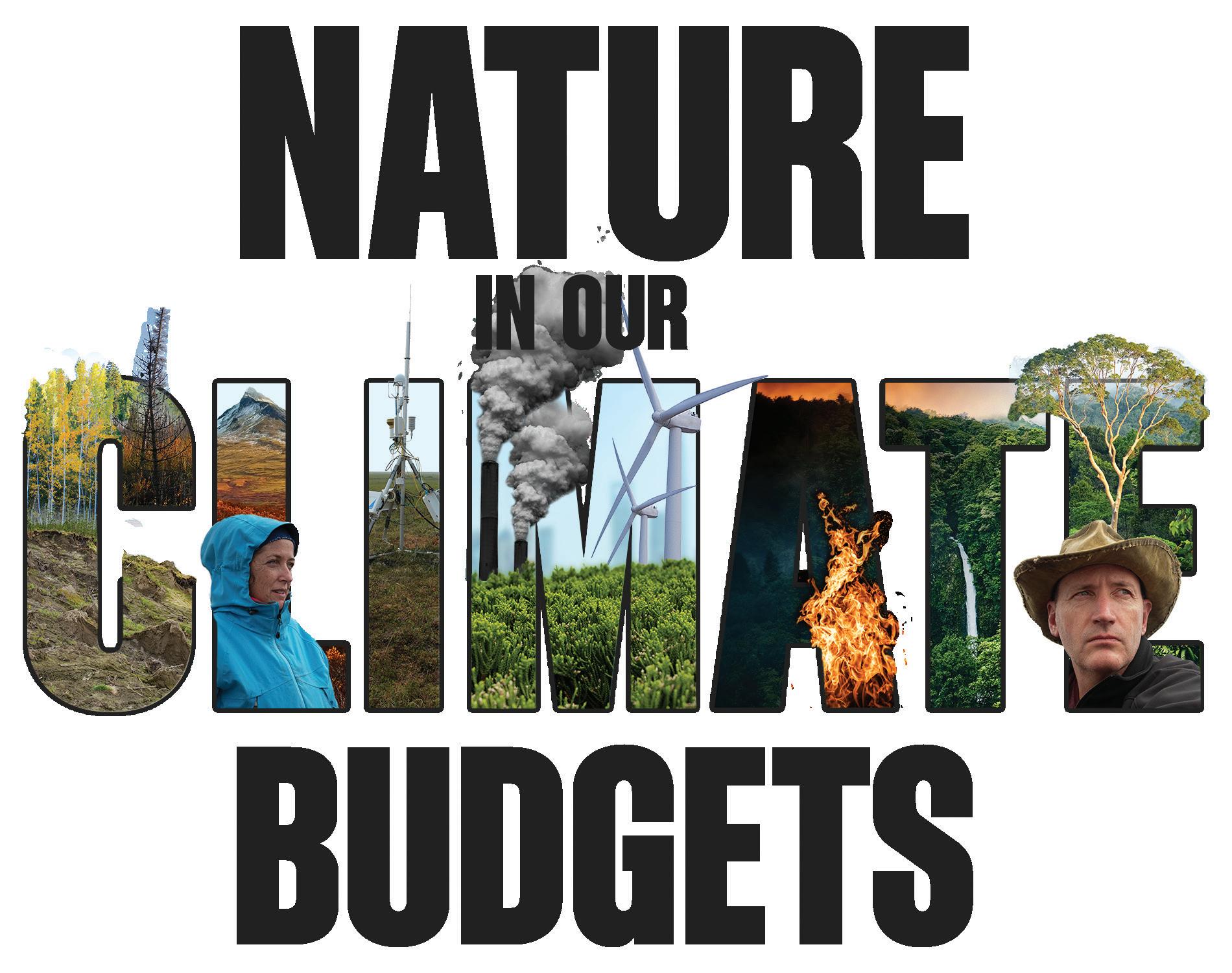

FALL 2022
Climate Science for Change is published by Woodwell Climate Research Center in Falmouth, Massachusetts.
Woodwell Climate Research Center conducts science for solutions at the nexus of climate, people and nature. We partner with leaders and communities for just, meaningful impact to address the climate crisis.
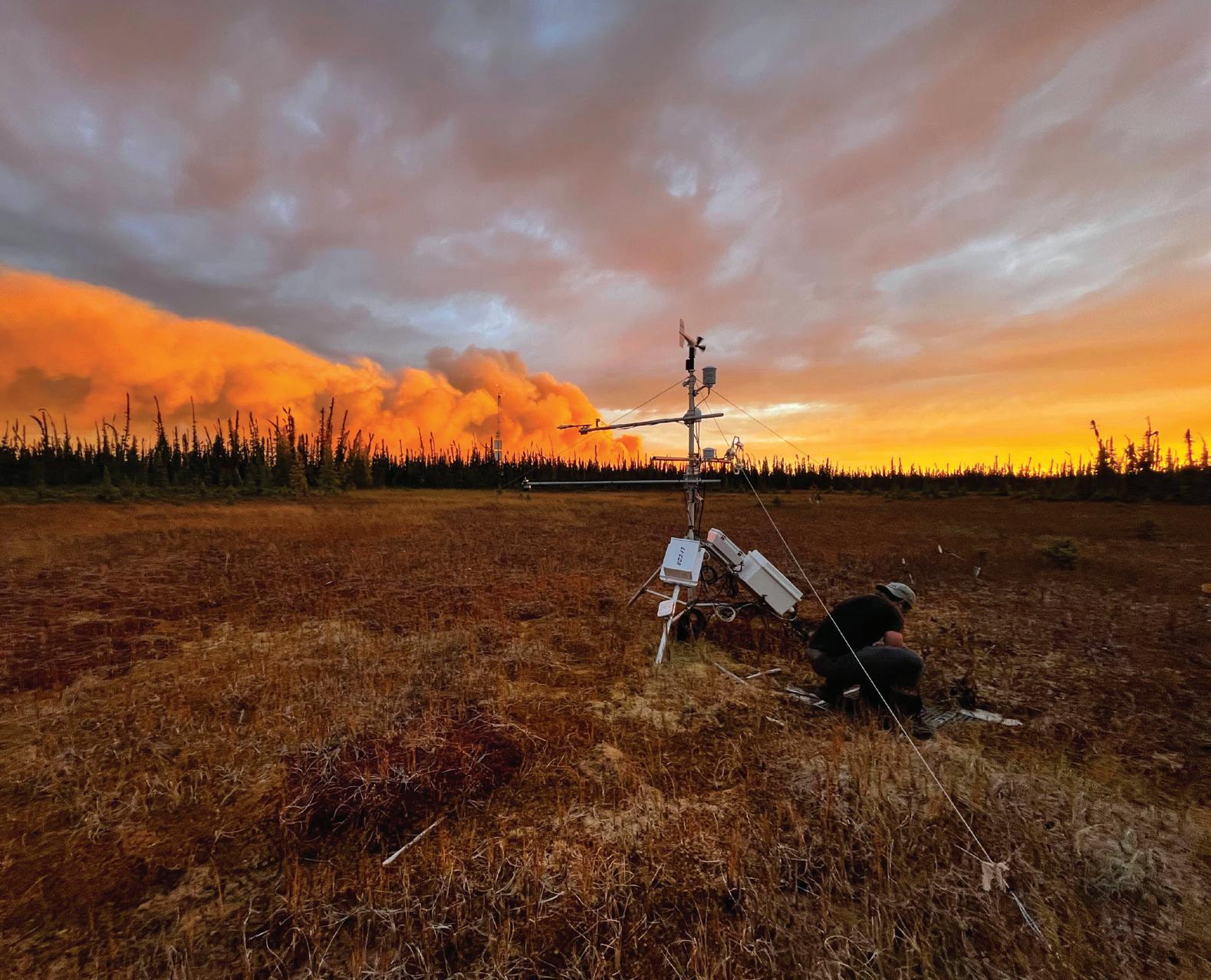
PRESIDENT AND CEO Dr. R. Max Holmes
CHIEF COMMUNICATIONS OFFICER Dr. Heather M. H. Goldstone
SCIENCE WRITER Sarah Ruiz
GRAPHIC DESIGNER Julianne Waite
COPY EDITORS
Elizabeth Bagley, Paula Beckerle
IMAGES
Paulo Brando, Glenn Bush, Nichole Chapman, Greg Fiske, Miles Grant, Max Holmes, Eric Lee, Madeline Lee, Chris Linder, Marcia Macedo, Manoela Machado, Susan Natali, Sarah Ruiz, Gabrielle Russomagno, Jonathan Sanderman, John Schade, Christina Shintani, Rachael Treharne, Julianne Waite, Jennifer Watts, Joëlle Voglimacci-Stephanopoli, Joseph Zambo WOODWELL CLIMATE RESEARCH CENTER
149 Woods Hole Road
Falmouth, MA 02540 Email: info@woodwellclimate.org Website: woodwellclimate.org
COMMUNICATIONS FROM WOODWELL Subscribe at woodwellclimate.org COPYRIGHT All material appearing in Climate Science for Change is copyrighted unless otherwise stated or it may rest with the provider of the supplied material. Climate Science for Change takes care to ensure information is correct at time of printing.
Woodwell Climate Research Center is located on
the traditional and sacred land of the Wampanoag people who still occupy this land, and whose history, language, traditional ways of life, and culture continue to influence this vibrant community. 01 / From the President & CEO 03 / Updates and insights 06 / What is permafrost? An unaccounted-for emitter 10 / They keep us cool, we cut them down 14 / It’s not the cows, it’s the way we’re managing them 18 / CENTERPIECE Pushing climate policy forward on two fronts 20 / Fund for Climate Solutions marks five successful years 22 / Permafrost Pathways celebrates six months 24 / Annual report New board members | In memoriam | Board and staff Statement of activities and financial position | Donors Contents
CHANGE Sunset wildfire smoke near the Scotty Creek tower site, a Permafrost Pathways associated tower, in Northwest Territories, Canada, September 2022. / photo by Joëlle Voglimacci-Stephanopoli Cover graphic by Nichole Chapman
CLIMATE science for
From Max
Climate, people, nature… and solutions
President & CEO
The mission of the Woodwell Climate Research Center is to conduct science for solutions at the nexus of climate, people, and nature. We partner with leaders and communities for just, meaningful impact to address the climate crisis.
On June 9, 2022, Woodwell’s Board of Directors approved this new mission statement. As anyone who has ever worked on a mission statement knows, it can be a long, tortuous process, where every word is vetted, analyzed, considered, and reconsidered, until finally you arrive at a string of words that ideally captures the essence of the organization and why it exists. Thanks to the hard work and insights of many people, both staff and board, I think we nailed it.
One week after the mission statement was approved, I departed with my family on a long-planned vacation to Africa. As I realized during our journey and as I’ll describe below, the three legs of the trip unfolded in a way that aligned remarkably closely with our new mission statement. The trip also reinforced the importance and urgency of our work at Woodwell, and made me more motivated than ever to do everything possible to advance our mission.
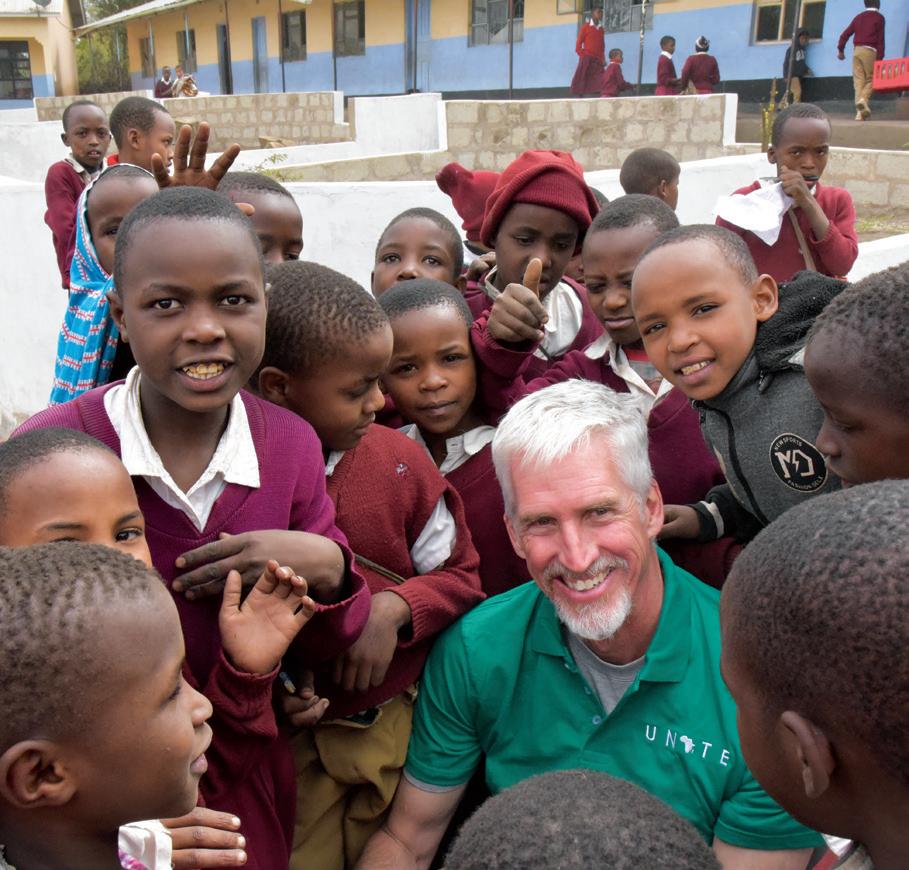
Climate | The first leg of the trip was our attempt to climb Mount Kilimanjaro. Straddling the Tanzania/Kenya border just south of the equator, the climb begins in lush tropical rainforest and, if successful, ends at the 19,341-foot summit surrounded by Kilimanjaro’s iconic glaciers.
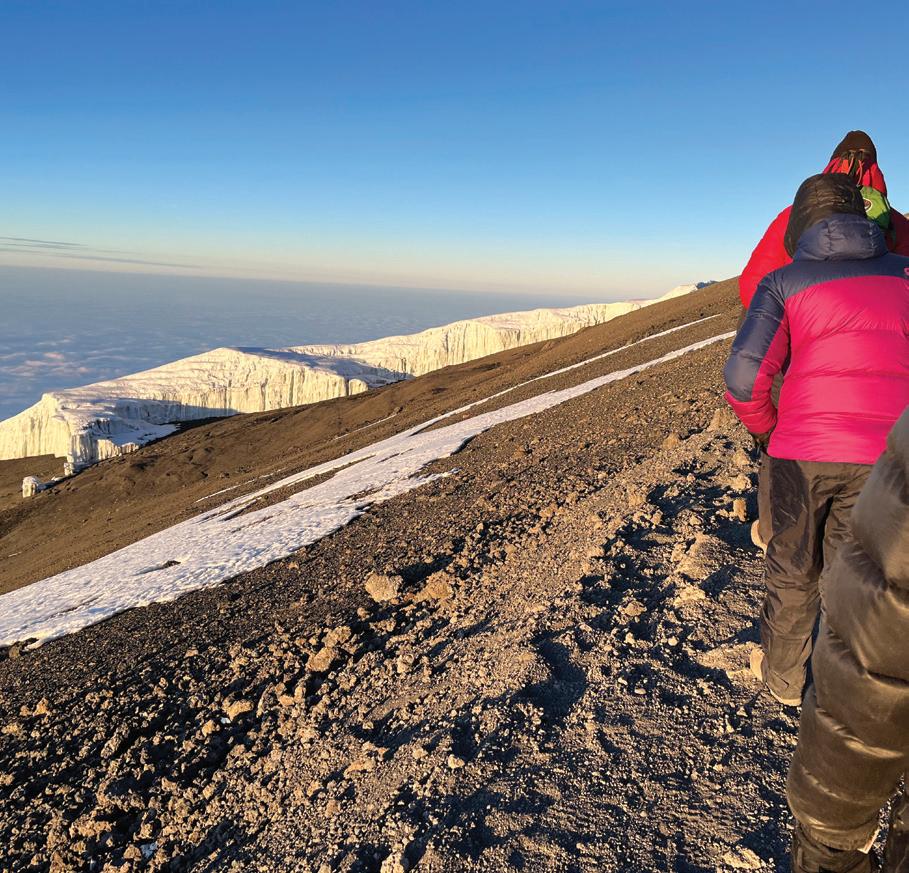
I’ve traveled to many different parts of the world where climate change is already having substantial impacts, from the Arctic to the Amazon, but there is something about receding glaciers that hammers home the physical reality of climate change. During our nine-day climb, I had lots of time to reflect on the beauty and vulnerability of Kilimanjaro’s glaciers, which are predicted to disappear entirely in the near future. I was thrilled (and a bit amazed) when we all made it to Kilimanjaro’s summit, but it was hard to shake the feeling of loss at the pending disappearance of Kilimanjaro’s magnificent glaciers.
We have work to do.
People | The second leg of the journey only lasted a day, but for me it was the most impactful. My 13-year-old daughter Sophie, in partnership with an amazing nonprofit called Unite the World with Africa Foundation, had raised almost $3,000 to plant trees for fruit and fuel at a primary school in Tanzania. We visited the school, met with the headmaster, toured classrooms, and interacted with the remarkable students. Though there were hundreds of students at the school, there was no running water, and we learned from the headmaster that most of the students got by on one meal per day. On top of that, the region was warming and as elsewhere in East Africa, a severe drought was leading to widespread crop failure. It was clear that these students and their families were already living on the edge, and that adapting to climate change would be extremely difficult. I think of these students often, who bear no responsibility for climate change yet may suffer the gravest consequences.
We have work to do.
1 Climate Science for Change Fall 2022
Holmes,
Nature | The final leg of the journey was a four-day safari in the Serengeti. Most of our planning had focused on the Kilimanjaro climb, so I hadn’t really done my homework to know what to expect on the safari. Let me just say that I was astounded by the diversity and abundance of wildlife we saw—lions, elephants, rhinos, hippos, cheetahs, leopards, giraffes, hyenas, crocodiles, zebras, hundreds of thousands of wildebeests, and more. I really had no idea that places like this still existed, or for that matter, ever existed. This experience reminded me that we live on an absolutely amazing planet. Yes, we face immense challenges that require urgent attention, but sometimes it is nice to sit back and reflect on the continued magnificence of our home planet. Continuing to protect places like the Serengeti also hinges on the success of Woodwell’s mission.
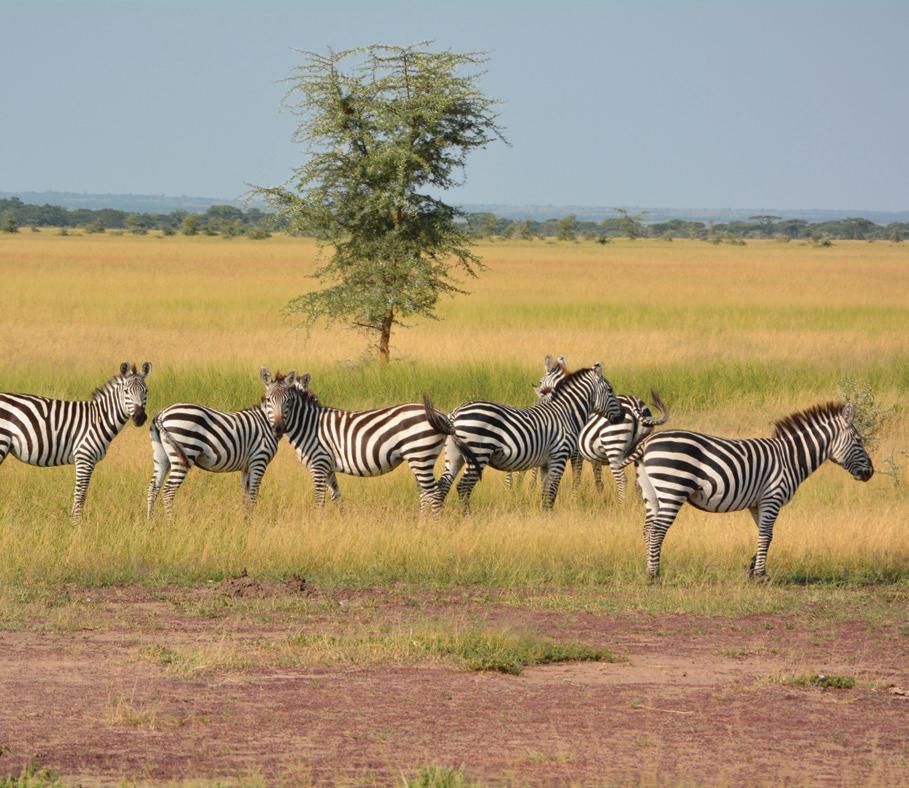
We have work to do.
Solutions | I’ll conclude with thoughts about my second trip to Africa this year, which will begin a few days after I write this in early November. This time I’ll be joined by 17 of my Woodwell colleagues, all of us heading to COP27 in Egypt. Having played a key role in the formation of the UN Framework Convention on Climate Change (UNFCCC) 30 years ago, Woodwell now is doing everything possible to push UNFCCC member nations to finally take the aggressive actions needed to live up to the promise of limiting warming to an extent that avoids the worst consequences of climate change. Much time has been wasted, and the fact that carbon emissions and warming have continued to increase three decades after the ratification of the UNFCCC clearly shows its limitations, yet it remains the most promising mechanism for catalyzing the global action needed to achieve a just, healthy, and sustainable world.
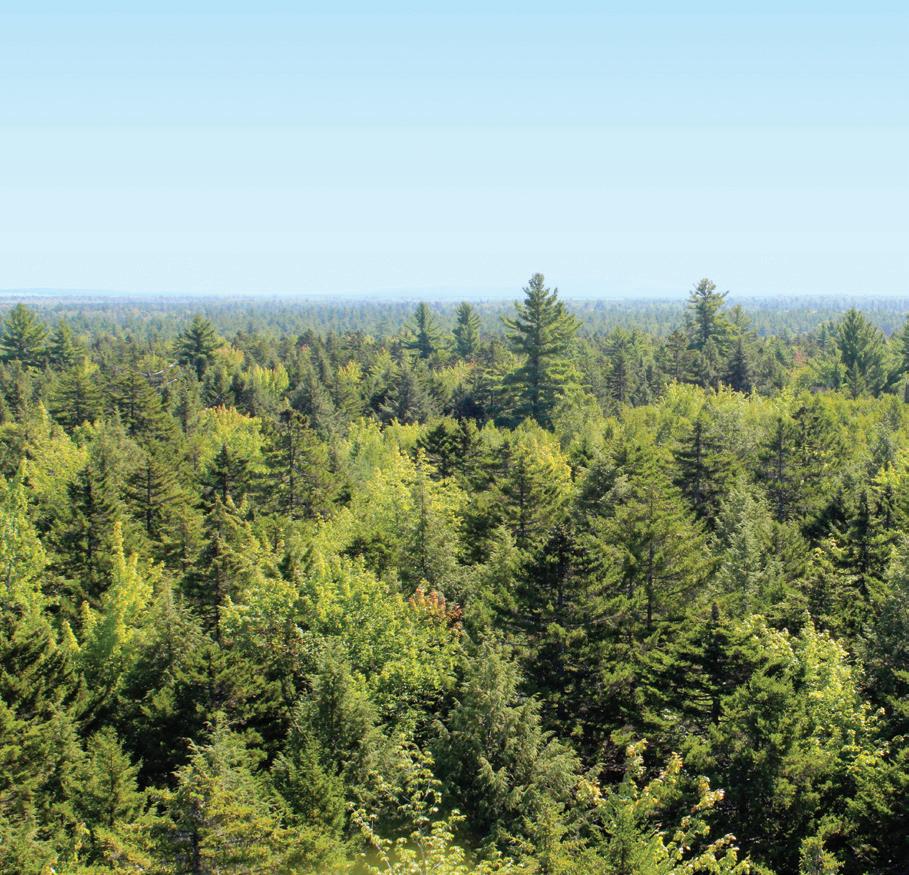
Thank you for your help and support. We all have work to do.

Miles
Grant
Climate Science for Change Fall 2022 2
From Max Holmes, President & CEO continued
Updates and insights
Impact updates
JUNE
Woodwell announced its policy priorities for the 2023 reauthorization of the federal Farm Bill, including responsibly deploying natural climate solutions, reducing wildfire risk, and improving credibility of carbon markets.
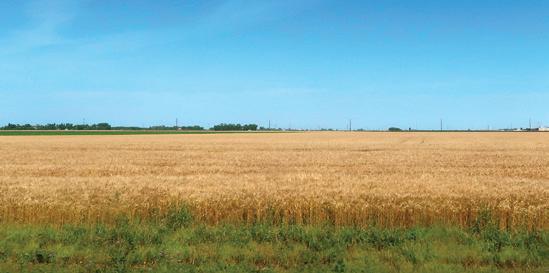
READ MORE woodwellclimate.org/farm-bill-2023-priorities
JULY
Woodwell Climate scientists were quoted in hundreds of news stories, providing context on extreme heat in the U.S., record deforestation in the Brazilian Amazon, and an unexpectedly severe start to the wildfire season in Alaska.
READ MORE www.reuters.com/business/environment/what-is-behind-heat-wavesaffecting-united-states-2022-07-24
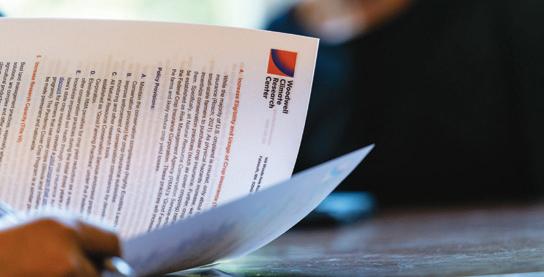
AUGUST
Members of the Risk program and Communications department received a commendation in the inaugural Climate Creatives Challenge (CCC) for their animated visualization of socioeconomic disparities in flood risk.
READ MORE woodwellclimate.org/commendation-in-climate-creatives-challenge/
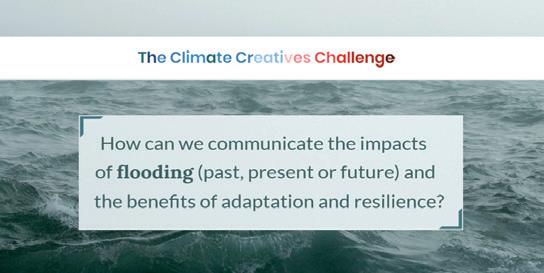
SEPTEMBER
One team of staff, board members, and partners traveled to Washington, D.C. for Congressional testimony and meetings with legislative offices, while another headed to New York, NY to connect with decision-makers at Climate Week NYC.
READ MORE woodwellclimate.org/teams-tackle-climate-policy-on-two-fronts
OCTOBER
Woodwell launched a free, online course on permafrost thaw—the first in a new partnership with the UK-based online social learning platform FutureLearn.
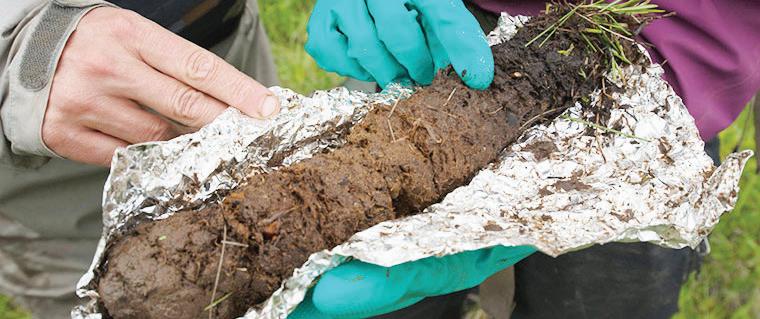
READ MORE woodwellclimate.org/permafrost-course
NOVEMBER
More than a dozen staff, as well as several board members, attended the COP27 climate negotiations in Sharm el-Sheikh, Egypt, pushing to get natural systems—and their stewards—valued and accounted for in UN climate policy.

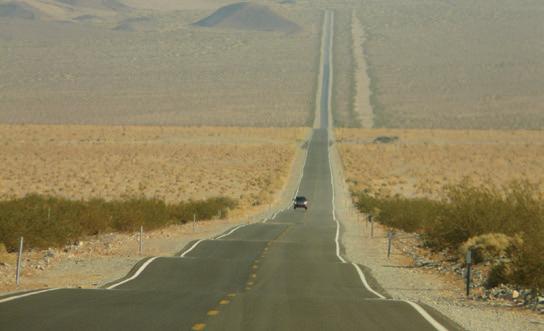
READ MORE woodwellclimate.org/cop27
By the numbers
INSIGHTS FROM RECENT WOODWELL CLIMATE PUBLICATIONS
287 3.1 46 $1
Metric tons of unrealized potential of land-based carbon storage woodwellclimate.org/ land-based-carbon-storageopportunities
Needed federal investment in science to support natural climate solutions
woodwellclimate.org/naturalclimate-solutions-roadmap
Acres burned by wildfires in Alaska in 2022
woodwellclimate.org/5-thingsalaska-fire-season
Portion of Brazilian Cerrado that has been cleared for crops or pastures
woodwellclimate.org/half-ofthe-cerrado-is-already-gone
Eric Lee Chris Linder
billion billion million % 3 Climate Science for Change Fall 2022
Fund for Climate Solutions awards largest cohort to date
Seven projects aim to push boundaries across all areas of Woodwell’s work
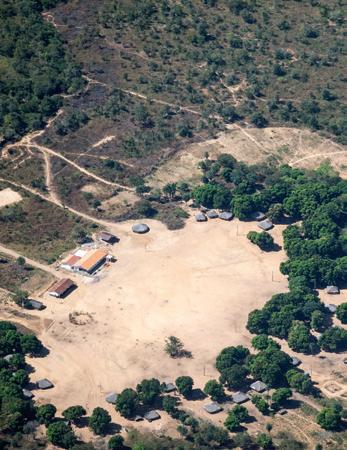
The Fund for Climate Solutions is a competitive, internal granting mechanism that supports early-stage and high-risk, high-reward research with breakthrough potential. New awards are made twice each year. The latest cohort comprises seven highly-collaborative projects and more than $650,000 in funding to support innovative extensions of ongoing research with near-term policy relevance.
Preserving and increasing carbon stocks of large trees on federal lands
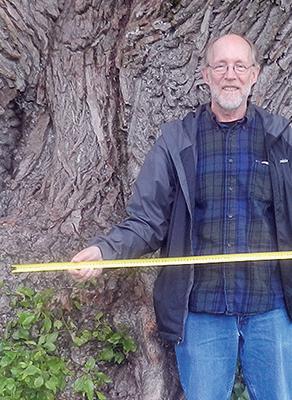
Project lead: Dr. Richard Birdsey
There is an urgent need to identify large, older trees and mature forest stands on U.S. public lands that could be protected from harvest to maintain their carbon stocks and growth potential. Building on preliminary work with the Natural Resources Defense Council, and working in collaboration with Wild Heritage, Woodwell Climate scientists will develop a quantitative method for identifying mature forests and apply this to U.S. National Forests in order to clarify thresholds for protection from logging and estimate the likely carbon storage resulting from protection. This project addresses key policies for federal land management contained in two recent Executive Orders, and has the potential to contribute significantly to maintaining present and future carbon stocks on public lands and achieving the nation’s goal of net-zero greenhouse gas emissions by 2050.
The importance of protected areas and Indigenous lands for Amazon climate
Project lead: Dr. Michael Coe
Amazon forests take up water from the soil and evaporate it to the atmosphere, cooling the land surface and sustaining up to half of regional rainfall. This forest function is critical for biodiversity, carbon cycling, and food and energy production, but it is threatened by deforestation and its integration into climate policy has lagged due to knowledge gaps. This project will quantify the climatic importance of forests in Indigenous territories, protected natural areas, and undesignated lands, which together account for roughly half the area of standing Amazon forest and a third of deforestation. This new understanding will be key to the development of targeted conservation strategies and stronger policies and land-use planning for protection of forests and their climate benefits.
Quantifying
Project lead: Dr. Marcia Macedo
Wetland ecosystems—whether natural, man-made, or restored—play a significant role in carbon cycling. Whether they are net sinks or sources of carbon to the atmosphere depends on local hydrology, vegetation, and land management in a changing climate. Woodwell scientists have studied these processes across a wide range of ecosystems, including small reservoirs in the Amazon, forests and bogs in Maine, and active or newly restored cranberry bogs in Massachusetts. However, traditional techniques for measuring carbon fluxes can be limiting in ecologically complex and/or rapidly changing environments. The purchase of a portable gas analyzer will enable real-time measurement of greenhouse gas fluxes at fine scale, adding a new dimension to ongoing work in these important environments.
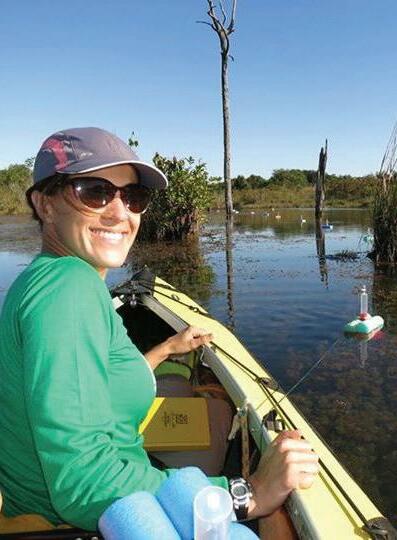
carbon fluxes in wetland ecosystems from tropical South America to temperate New England
Updates and insights continued Paulo Brando Climate Science for Change Fall 2022 4
Rapid soil health assessment
Project lead: Dr. Jonathan Sanderman
In order for food producers around the globe to improve soil health and increase soil carbon storage, they must first be able to measure it reliably and inexpensively. Previous work supported by the Fund for Climate Solutions has demonstrated that low-cost, handheld, infrared sensors connected to smartphones have the potential to meet the need for soil carbon monitoring. This project will expand the scope of ongoing work with Africa-based Innovative Solutions for Decision Agriculture (iSDA) to assess the effectiveness of this technology for measuring overall soil fertility and soil health status. This work has the potential to enable scientific advances and improved land management decisions that could help close the agricultural yield gap in some of the world’s poorest regions.
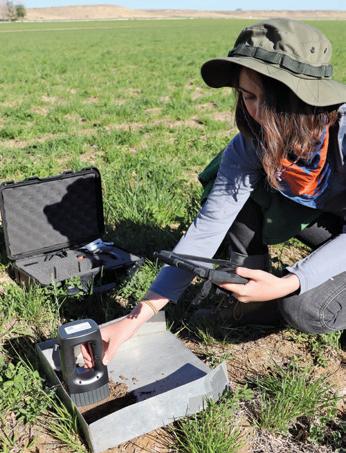
Climate change and global security
Project lead: Dr. Alex Naegele
Climate change has been identified as a critical national security issue—as a threat multiplier that exacerbates existing societal stressors and regional instabilities. However, the inclusion of granular climate impacts in security strategy is not yet widely practiced. In collaboration with the Center for Climate & Security, Woodwell Climate’s Risk Program aims to provide actionable climate intelligence that can be used to directly inform security policy. In this project, two case studies on countries with strong regional influence and mounting climate vulnerabilities (e.g. Indonesia, Iran, Turkey, and South Africa) will synthesize climate risk assessments and security insight to develop a comprehensive climate security analysis. This research will be accompanied by U.S. policy recommendations to address security risks, and it will be shared with policymakers and leaders in the security community to normalize this essential approach to climate security.
Gaining new insights into drivers of carbon emissions from Alaska permafrost by integrating radiocarbon, VLF-ERT, and soil respiration monitoring
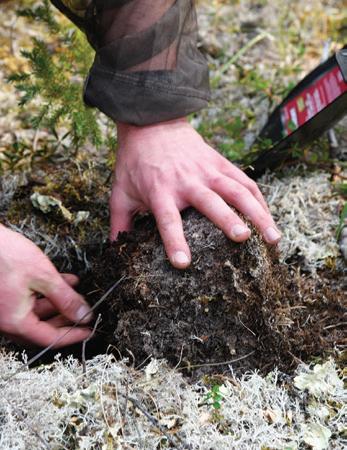
Project lead: Dr. Jennifer Watts
Thawing high latitude permafrost is expected to become a significant source of carbon dioxide and methane emissions this century. Accurately projecting future emissions requires not only measuring overall carbon release and uptake rates, but also understanding the biological and ecological processes at work. This project addresses two key knowledge gaps: differentiating the contributions of soil microbes and plant respiration to carbon emissions under differing environmental conditions, and understanding the impact of fire on subsequent carbon loss from soils. Specialized, year-round gas monitoring at burned and unburned sites near Hess Creek, AK, along with carbon dating and permafrost decay mapping using Very Low Frequency Electrical Resistivity Tomography (VLF-ERT), will provide proof of concept for a novel technique that can be applied across the Arctic to address these knowledge gaps and improve models and projections of permafrost thaw carbon emissions.
Tracking global contaminants in ecosystems on the frontline of permafrost thaw
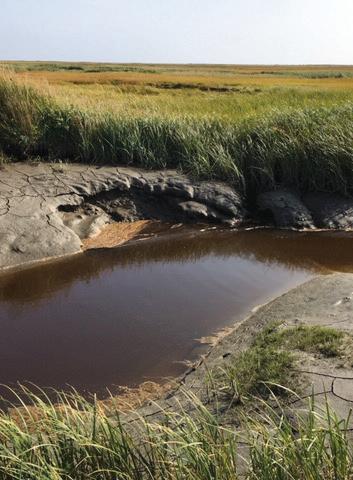
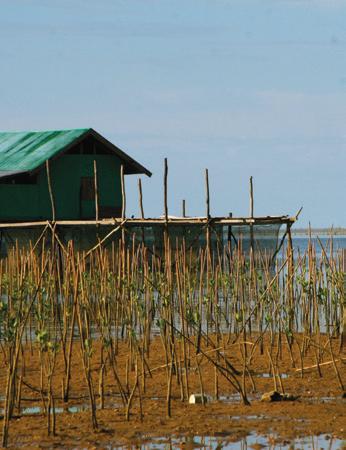
Project lead: Dr. Scott Zolkos
Rapid permafrost thaw is creating hazardous conditions for northern communities, as thawing and collapsing ground threatens infrastructure and Indigenous ways of living. It also poses a severe risk to human and ecosystem health, because toxic mercury (Hg) and poly- and perfluoroalkyl substances (PFAS) have accumulated to high levels within permafrost region ecosystems and are now being released into drinking water, and bioaccumulating in fish and other organisms that are essential to northern diets, health, and cultures. Despite the risk, the magnitude of Hg and PFAS release associated with permafrost thaw is largely unknown. This project will leverage the scientific infrastructure and community outreach efforts of two flagship Woodwell Climate projects—Permafrost Pathways and Science on the Fly—to establish the first observatory for tracking contaminants in waters of local importance within permafrost regions.
Sarah Ruiz
USAID/Janice
Laurente
Sue Natali 5 Climate Science for Change Fall 2022
Gabrielle Russomagno
What is permafrost? An unaccounted-for emitter
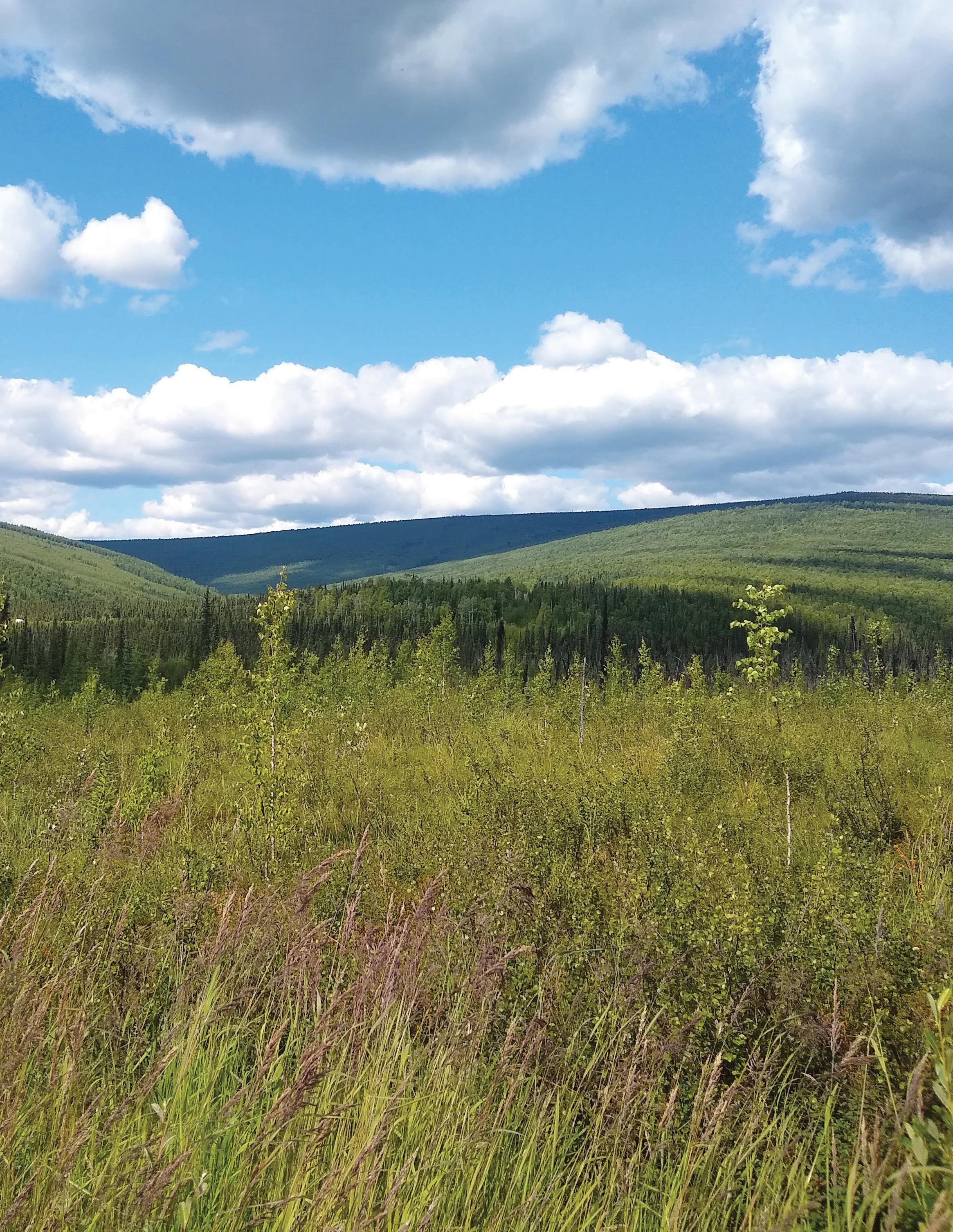 Katie Constantine Sarah Ruiz Communications Intern Science Writer
Katie Constantine Sarah Ruiz Communications Intern Science Writer
Climate Science for Change Fall 2022 6
Located anywhere between a few centimeters to 4,900 feet below the Earth’s surface, permafrost is soil composed of sand, gravel, organic matter, and ice that has been frozen for at least two consecutive years. The most significant extent of permafrost lies in the Arctic—stretched across Alaska, Scandinavia, Russia, Iceland, and Canada. It can be found beneath the Arctic Ocean, the Arctic tundra, and alpine and boreal forests. It covers 15% of the land in the Northern Hemisphere, 3.6 million people live atop it, and it has the
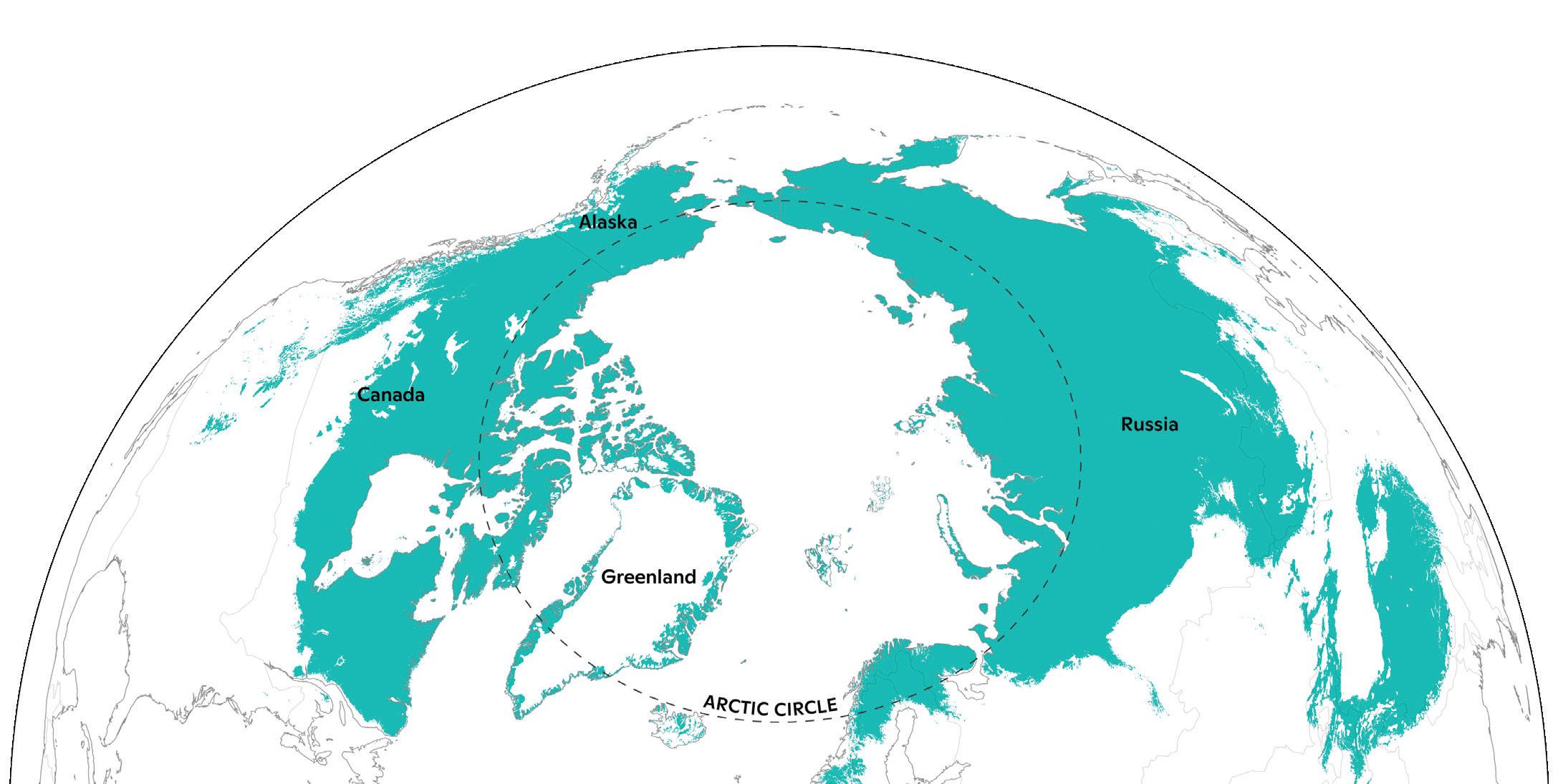
potential to release a devastating amount of carbon and rapidly accelerate warming.
The thawing threat
Scientists estimate that Arctic permafrost contains 1.4 trillion tons of carbon, an amount more than double what is currently in the Earth’s atmosphere. That carbon sink is stable as long as it stays frozen, but when it thaws, soil microbes break down the organic matter in permafrost and release carbon dioxide and methane into the atmosphere, increasing the rate of warming that caused the thawing in the first place.
In many places, forests, plants, and peat act as protective insulation for Arctic permafrost. This insulation helps keep carbon-storing organic matter, like plants and animals, as well as bacteria and archaea, frozen in the permafrost. However, climate change is already causing the Arctic to warm three to four times faster than the rest of the planet. In addition to speeding decay, rapid warming also strips back permafrost’s protective layers with increasing fires and heavy summer rains that burn and erode away top soil layers, further accelerating thaw. In some places, permafrost thaws so abruptly that the ground can collapse. Developing infrastructure that requires deforestation and the placement of underground pipes further exposes permafrost to warming. Additionally, as sea ice melts, coastal Arctic permafrost is exposed to warmer waters. The combined result is extensive permafrost thaw across the region.
Researchers have been studying permafrost thaw to determine the size of the threat it poses, though eroding slopes and

Graphic image by Nichole Chapman
Thawing Arctic soils have the potential to push us past our warming targets.
Current extent of permafrost (green) / map by Greg Fiske
7 Climate Science for Change Fall 2022
Caribou Creek, Alaska / photo by Jennifer Watts
fragmenting infrastructure are making Arctic research even more challenging. In a recent TEDTalk, Dr. Sue Natali, Woodwell’s Arctic program director and senior scientist, cautioned that, “By the end of this century, greenhouse gas emissions from thawing permafrost may be on par with some of the world’s leading greenhouse-gas-emitting nations.”
The missing expense in a global budget
Despite the potentially vast scale of permafrost emissions, they are conspicuously absent from the global climate budget. The budget, developed by the international science community, details planet-wide emissions and weighs them against carbon sequestered by forests and other carbon sinks. It functions much like a household budget—where spending more than you earn can jeopardize your financial stability. In this case, putting too much carbon into the atmosphere will push us past internationally-agreed warming limits.
Scientists estimate that emissions from permafrost thaw will range from 30 to 150 billion tons this century—on par with top-emitting countries like India or the United States. It’s “especially alarming… that permafrost carbon is largely ignored in current climate change models,” says Dr. Max Holmes, President of Woodwell Climate Research Center. That’s because permafrost thaw emissions could take up 25–40% of our remaining emissions budget to cap warming at 2 degrees Celsius. To put it in perspective, imagine leaving the cost of rent out of your household budget. It doesn’t mean you don’t have to pay it, it just means you won’t be prepared when that bill arrives.
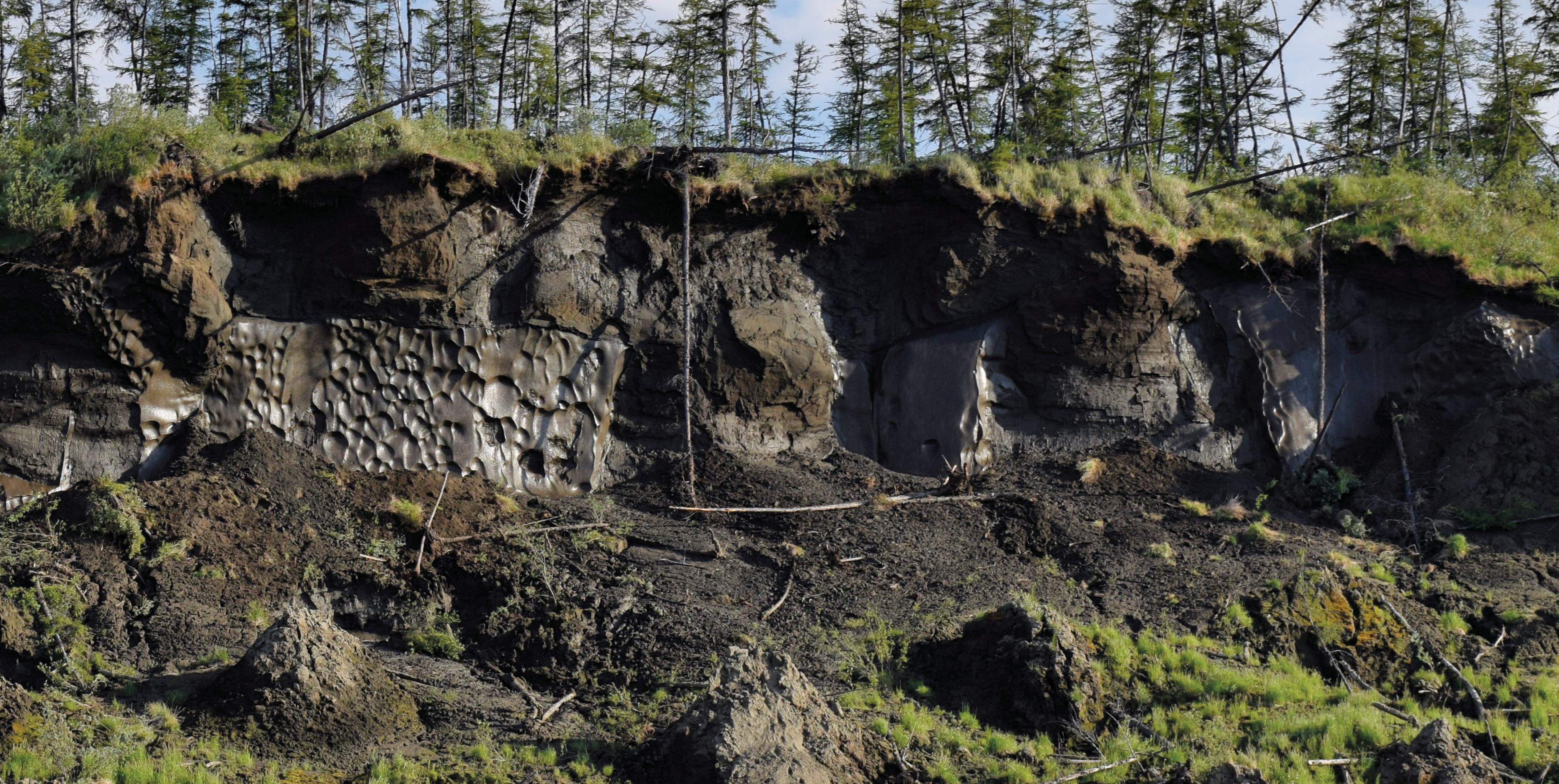
Permafrost emissions haven’t been factored into these budgets because solid estimates of them are difficult to create. The Arctic is huge and diverse, and spans multiple countries; onthe-ground data is sparse, leaving information gaps. To begin filling those gaps, Woodwell has partnered with the Arctic Initiative at Harvard Kennedy School, the Alaska Institute for Justice, and the Alaska Native Science Commission to connect experts in climate science, human rights, and public policy with frontline communities and high-level decision makers. The partnership, called Permafrost Pathways, will expand and coordinate a pan-Arctic carbon monitoring network to improve the accuracy of permafrost thaw emissions estimates. Improved data will put force behind the push to factor permafrost emissions into global carbon budgets, climate models, targets, and measures for mitigation and adaptation.
In addition, high-resolution satellite and aircraft-based observations and advanced computer modeling, will allow scientists to track the changing landscape in near real-time and more accurately project future emissions.
The demand for adaptation
Even without precision in the numbers, the impacts of permafrost thaw are already being felt in the Arctic. Because ice is an essential part of the ground’s structural integrity, it becomes unstable when it thaws. This leads to dangerous situations like landslides and sinkholes that threaten millions of people, particularly remote communities.
In 2019, a Yup’ik community that has lived in Newtok, Alaska for hundreds of years had to begin moving to higher, volcanic
8
110 GT 550
PERMAFROST High end 550
376
USA PERMAFROST Low end
GT
GT INDIA
GT
A slope eroding due to permafrost thaw in Siberia. / photo by John Schade
ground because the thawing permafrost under their town was causing disastrous floods and sinking infrastructure. According to Dr. Natali, who studies permafrost thaw in Yup’ik territory, “it’s a place where permafrost is on the brink of thawing, and will be thawed by the end of the century, if not much sooner.”
There is currently little government framework for adaptation, both within Arctic countries and internationally. The Yup’ik people had to reach out to a variety of government agencies, living without plumbing for decades, before the U.S. federal government finally awarded them support for relocation. The community paid a heavy price for it, though. Without proper policy in place to manage climate relocation, they had to bargain for government assistance, and in the end turned ownership of the land they were leaving over to the U.S. government.
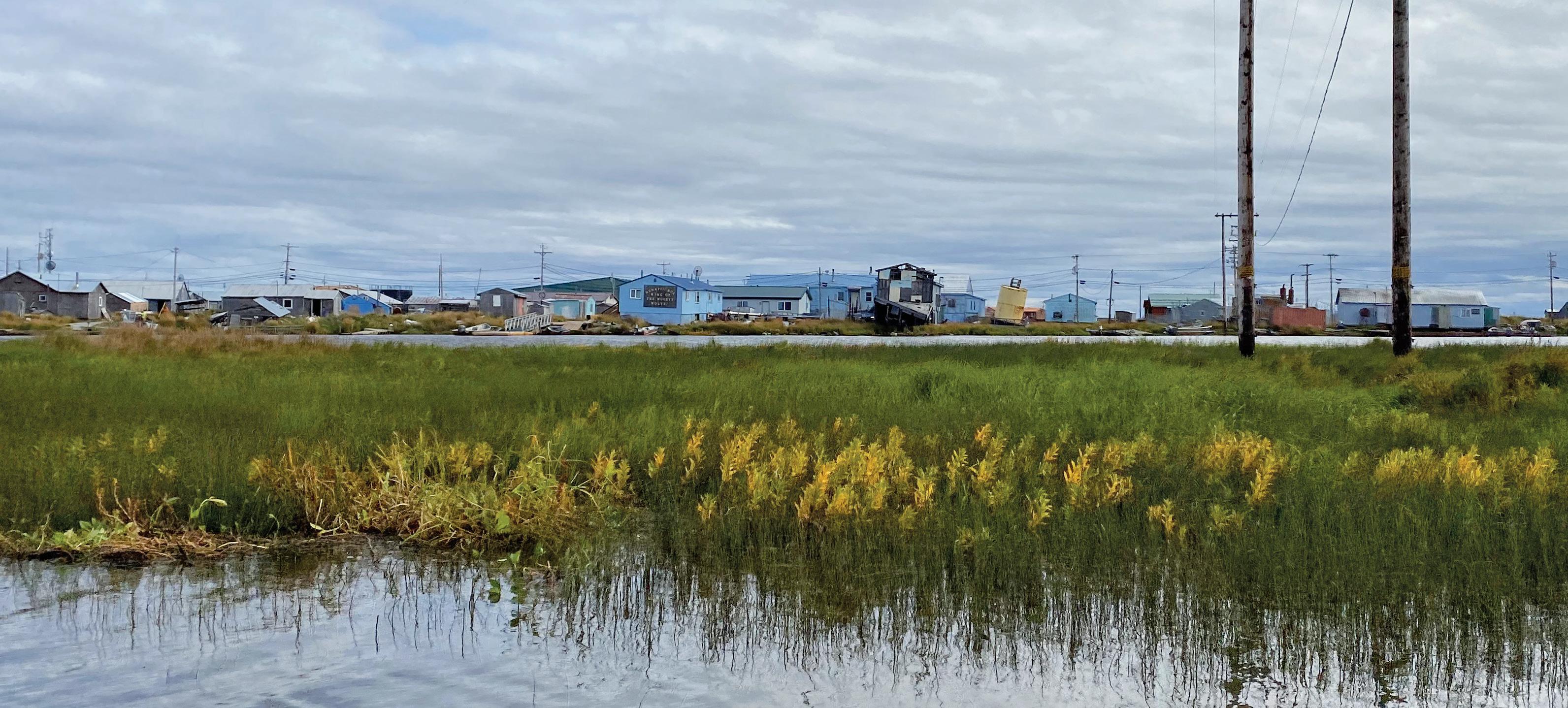
The process took sixteen years from when Congress agreed to provide assistance to when their promises were put into action. Arctic communities do not have another decade and a half to wait for more refined data, so the Permafrost Pathways program is collaborating with local communities to develop Indigenous-led adaptation strategies. For many, relocation or infrastructure upgrades are needed urgently, but there is currently no process or resources to enable communities to move forward. With Arctic residents already feeling the brunt of climate change, the involvement of frontline communities is crucial in developing successful adaptation plans and effective policies.
The work remaining
Despite its big strides, Permafrost Pathways is still in its infancy and there is a long road ahead when it comes to tackling the complex issue of permafrost thaw. In the Intergovernmental Panel on Climate Change’s 2021 report, permafrost thaw was named as an issue that should be included in carbon budgets and global reduction schedules, but it isn’t due to the lack of data. Continued data gathering is needed to speed up the inclusion of permafrost emissions in important decision-making, but governments need to act now to protect their citizens against the hazards they’re already facing from thaw. Integration of permafrost thaw risks into disaster policies and community-led adaptation frameworks will create clear planning and response procedures for the unstable future the Arctic is facing.
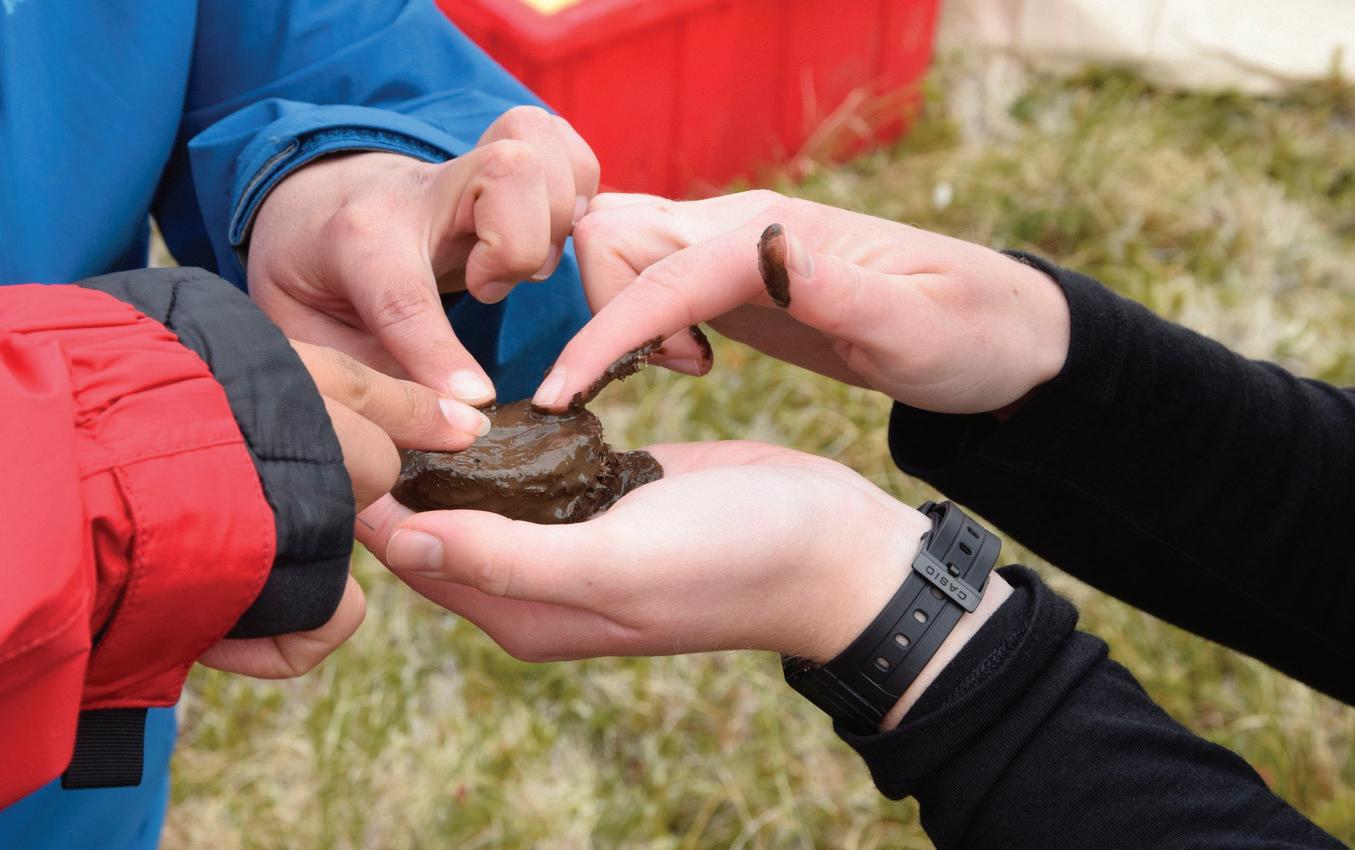
LEARNING OPPORTUNITY Want to dig deeper into permafrost? Enroll in Woodwell’s new online course offered through FutureLearn. It’s free, and available anytime you are. Thawing Permafrost Science, Policy, and Environmental Justice in the Arctic LEARN MORE woodwellclimate.org/permafrost-course 9 Climate Science for Change Fall 2022
Examining a permafrost sample in the field. / photo by John Schade
Nunapitchuk, Alaska / photo by Rachael Treharne
They keep us cool we cut them down
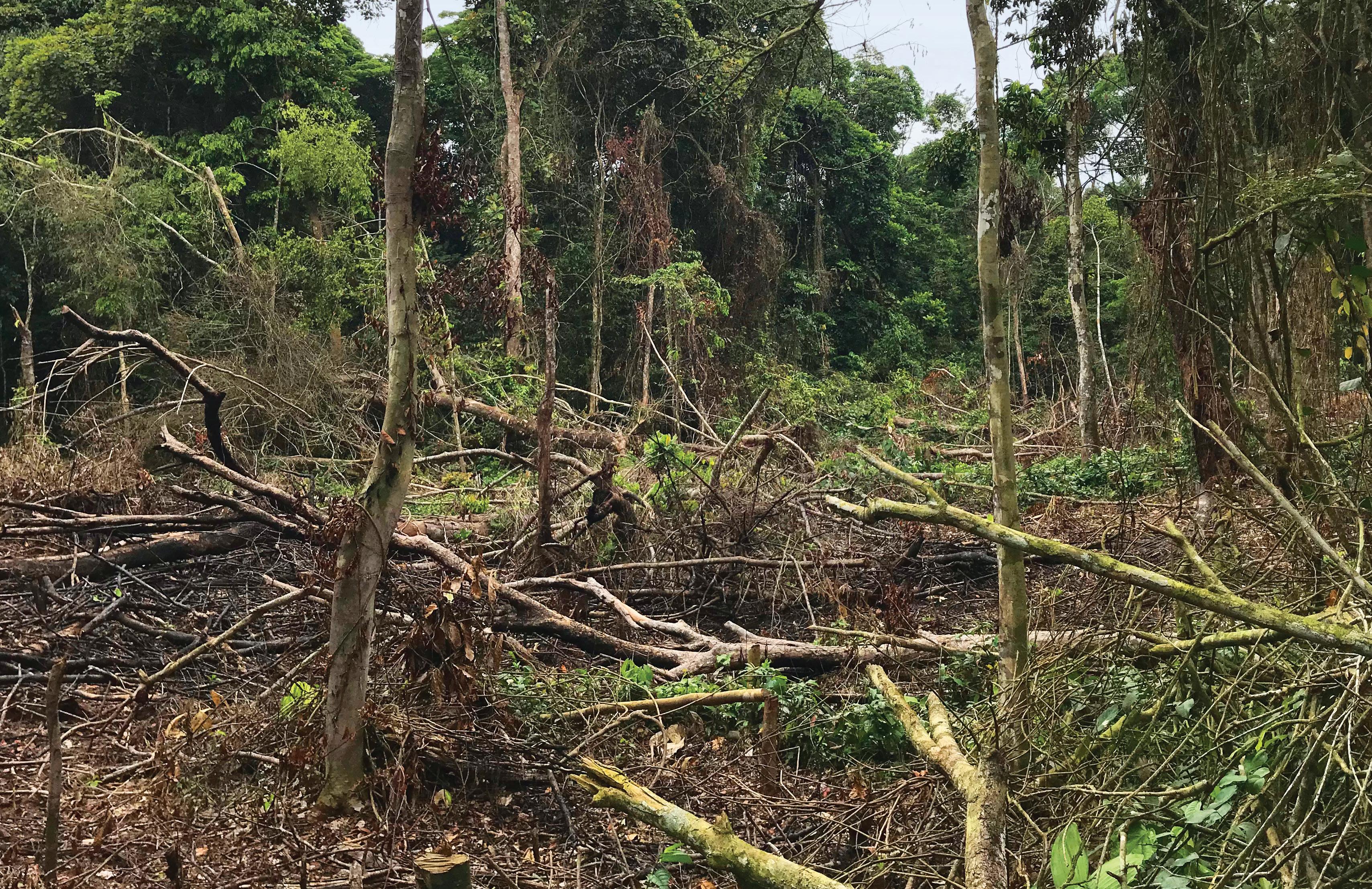
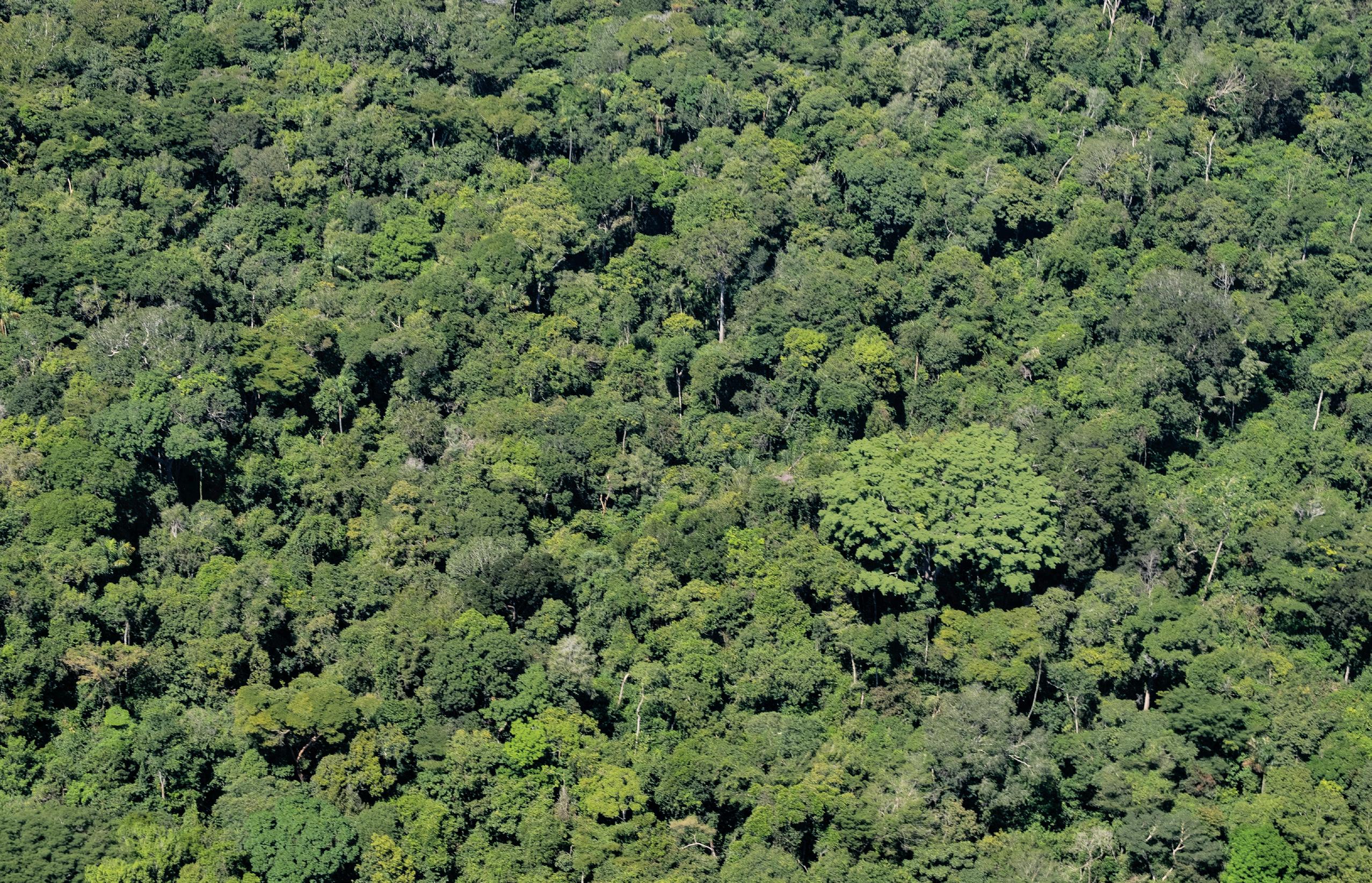 Ruiz Science Writer
Ruiz Science Writer
Climate Science for Change Fall 2022 10
Sarah
In terms of climate mitigation, forests are like green gold— working overtime to cool the planet, while also supporting a wealth of biodiversity. But we have not been saving them as one would a precious asset. Despite pledges to end deforestation, old growth forests are being cut down at alarming rates. And planting new trees is widely prioritized and incentivized over protecting existing forests. Across the board, standing forests are vastly undervalued. This has to change if we are to stand a chance of limiting warming to internationally agreed targets.
Forests are global air conditioners
According to a recent study from scientists at Woodwell and the University of Virginia, tropical forests alone are holding back approximately 1 degree Celsius of warming. About 75% of that cooling effect is due to carbon sequestration. Forests grow, trees lock away carbon in their trunks and roots and shunt it into the soil. The other 25% comes from the innate properties of forests that work to cool vast regions of the globe.
Through photosynthesis, plants release water vapor into the air in a process called evapotranspiration. The vapor contributes to cooling near the ground, as well as cloud formation higher in the atmosphere that reduces incoming solar radiation. The shape of the tree canopy also contributes. So-called canopy “roughness” disrupts air flow above the forest. The more uneven the canopy, the more turbulent the
air, which disperses heat away from the surface. In the tropics, evapotranspiration and canopy roughness are high, which means that surface temperatures remain relatively low, with the heat dispersed throughout the deep atmosphere.
Forests also naturally produce molecules called biogenic volatile organic compounds (BVOC), which can either contribute to cooling by encouraging the formation of clouds, or to warming by creating ozone and methane. In the tropics, the net effect of these chemicals is cooling.
The cumulative result of these properties is that when forests are removed, the land around them begins to heat up even faster, which can increase the frequency of extreme heat and drought events. Without forests, some regions will become a lot less resilient to sudden shocks. And the release of carbon contributes to global warming which further exacerbates hot, dry conditions.
“Forests act like air conditioners,” says Woodwell Assistant Scientist, Dr. Ludmila Rattis, who studies the impacts of deforestation on agriculture in Brazil. “Deforesting in the face of climate change is like getting rid of your air conditioners before an upcoming heatwave.”
Not all forests are created equally
Protecting forests, and maintaining the cooling services they provide, is vital to limiting warming. But, with forests covering 30% of the Earth’s land, prioritizing protection is a massive task. And when it comes to carbon storage, not all forests are equally valuable. Older, healthier forests tend to have a more secure hold on their carbon.
“Mature forests have higher biodiversity and create their own microclimate,” says Woodwell Associate Scientist, Brendan Rogers. “They’re more resistant to drought and other types of disturbance. And because of that, they tend to be more stable in the face of environmental perturbations over time.”
New research from Woodwell and Griffith University has developed a method of identifying high-value forests using satellite imagery. Estimating the metric of “forest stability” through satellite data on the light reflected by vegetation and a water stress index of the tree canopy, researchers were able to determine gradients of stability within forest patches in the Amazon and boreal forests.
Using a gradient of forest stability allows for a better prioritization of forest protection strategies based on their carbon value.
“The first priority is to protect stable forests from further human disturbance,” says paper co-author Dr. Brendan
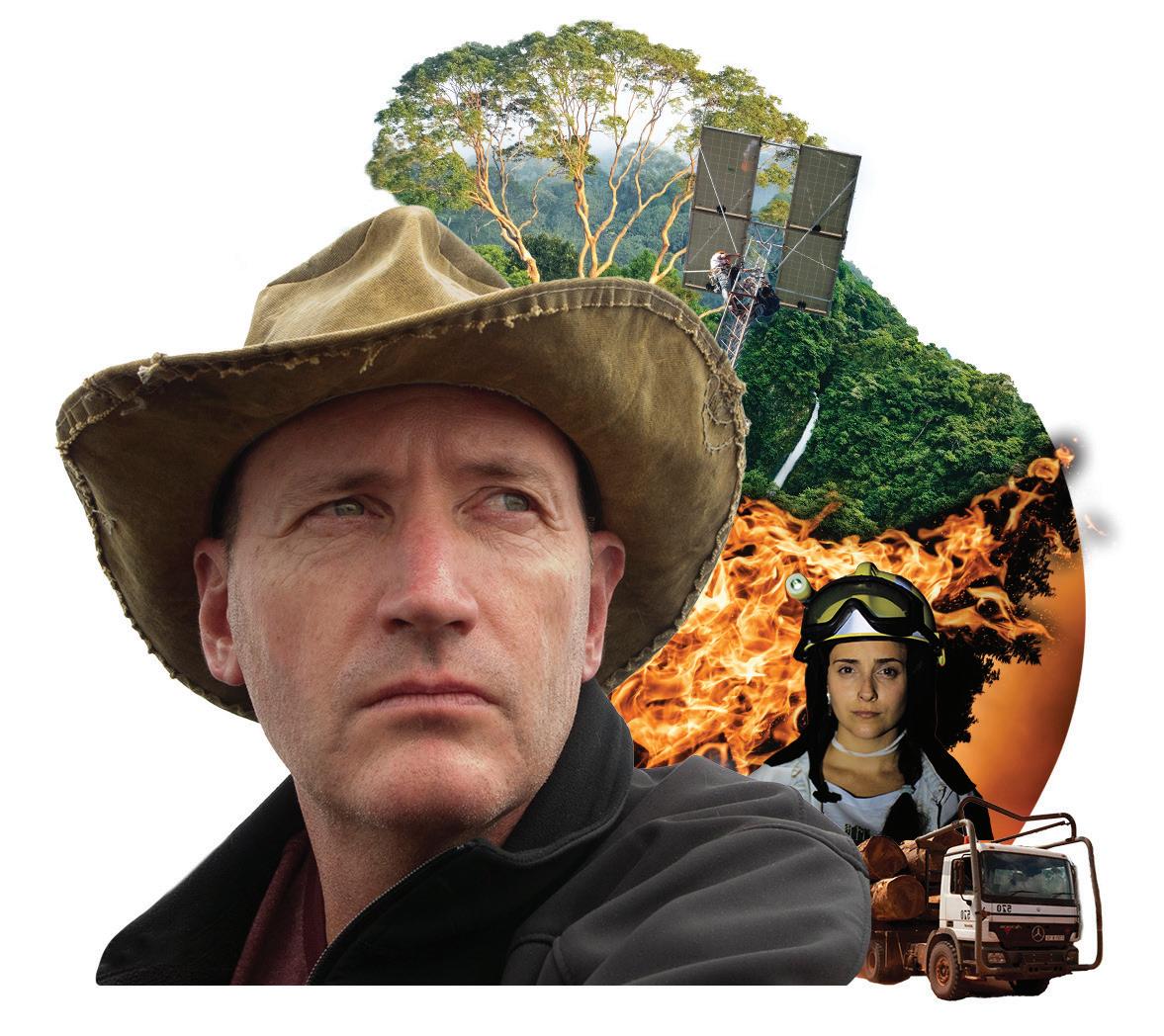
Standing forests are our best natural climate solution. So why aren’t we treating them that way?
11 Climate Science for Change Fall 2022
photos by Paulo Brando (top) and Glenn Bush (bottom)
graphic image by Nichole Chapman
Mapping forest stability is accurate across different biomes
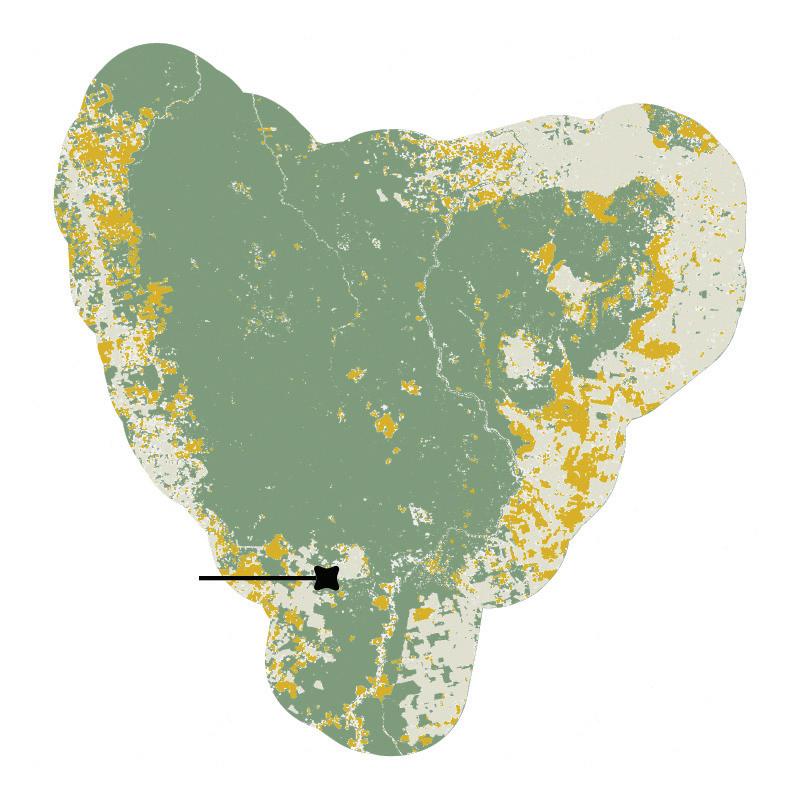
This new approach to categorize forests into stability classes was tested in two forest biomes that vary climatically and latitudinally: wet tropical (Amazon) and boreal (Siberia).

Modeled forest regions
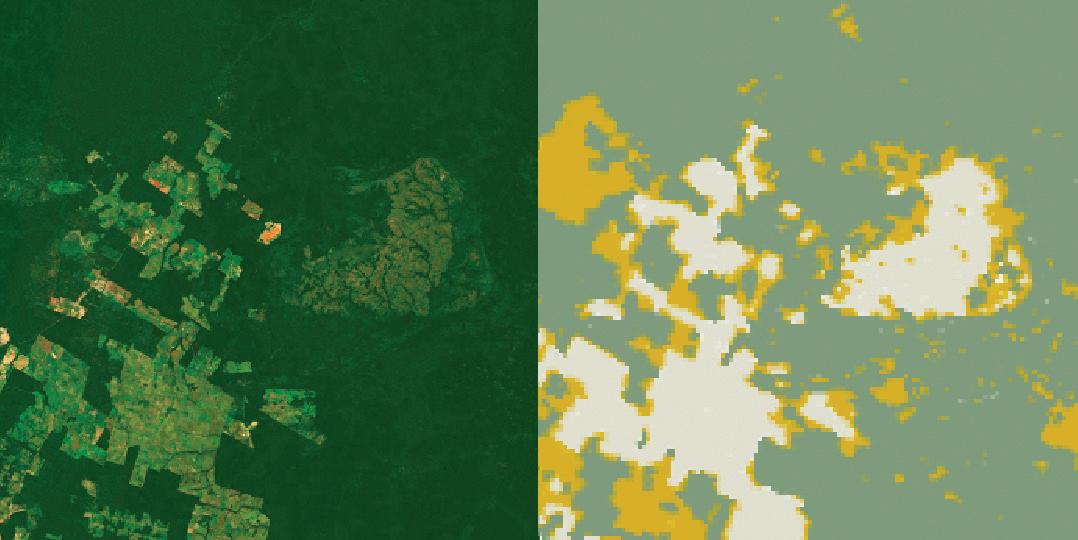
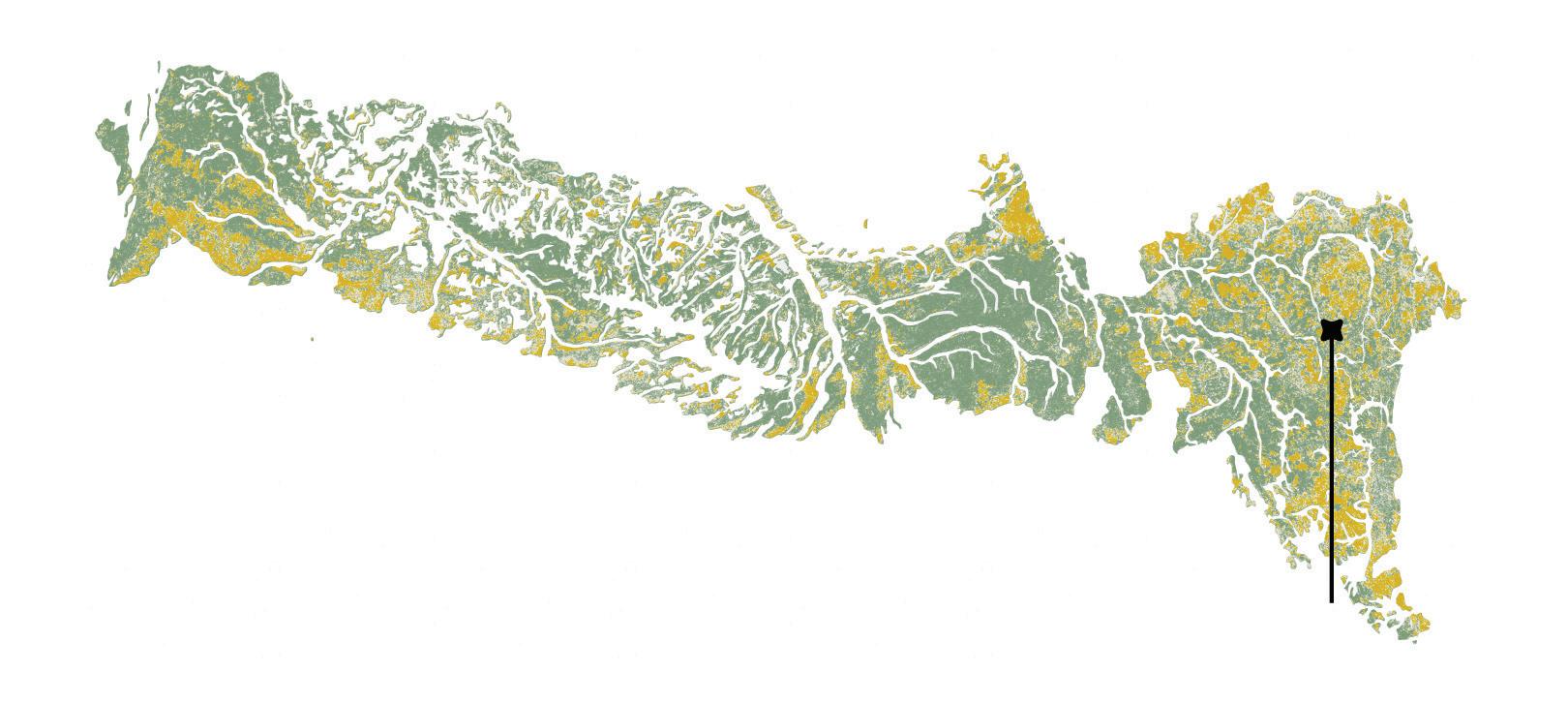
Kayapó territory Southern tiaga ecoregion
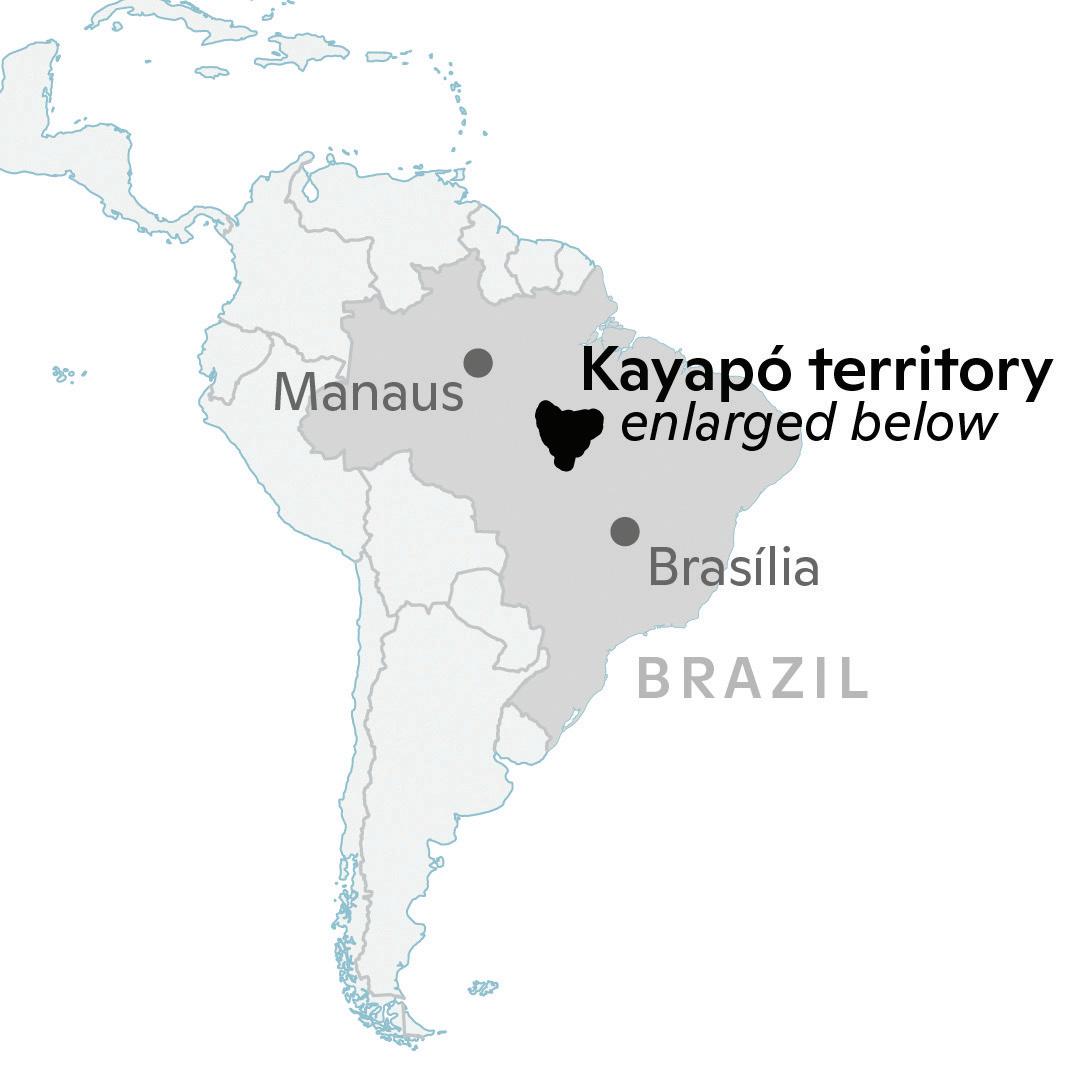
Area shown below
In comparison to Sentinel 2 satellite imagery, the model results proved to be accurate in both forest biomes and therefore a useful method in identifying and conserving stable forests.
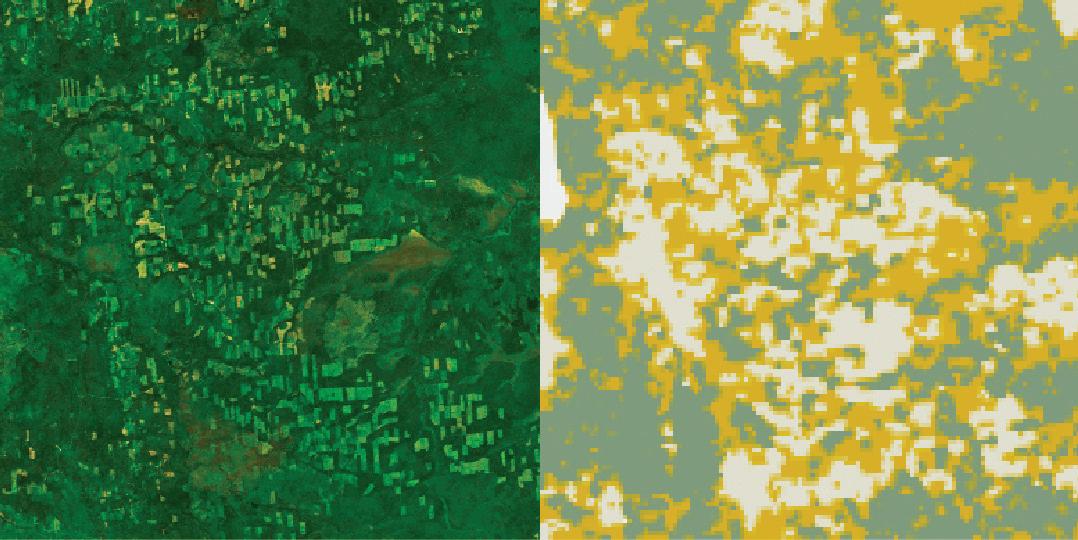
Satellite imagery
Area shown below
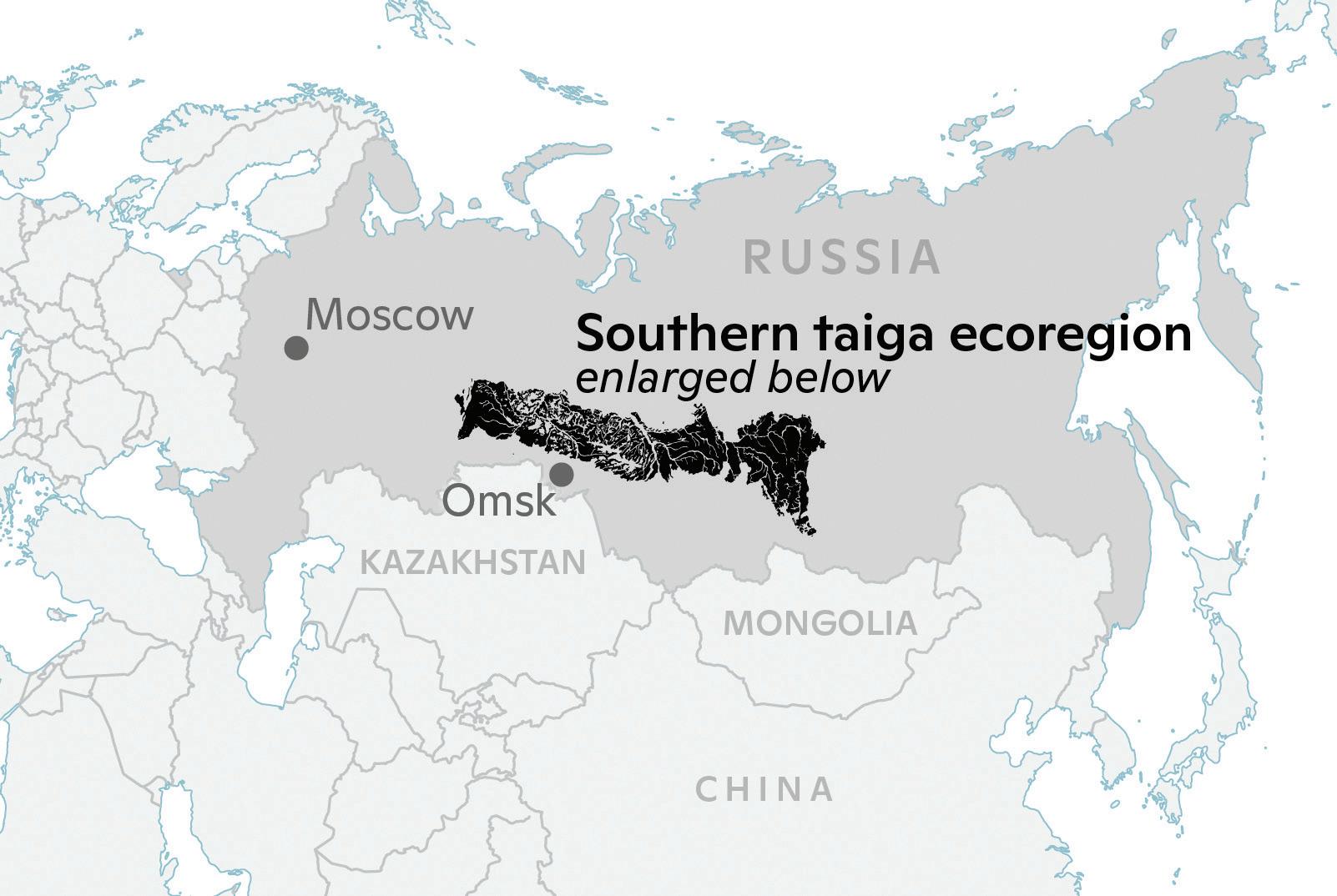
Satellite imagery Modeled results Modeled results 10 mi 10 km 5 mi 5 km
Climate Science for Change Fall 2022 12
Mackey. “The second priority is to identify forest areas where restoration efforts will be most cost effective.”
Guarding the forests that guard our future

If the state of existing forests is any indication, forest protection continues to be deprioritized. Many wildfires are left to burn unless they threaten human settlements. Governments continue to incentivize deforestation for development or agricultural expansion. Indigenous and local communities are not compensated for their work stewarding their territories and keeping forests safe. And the warmer the planet gets, the more susceptible even protected forests become to drought, fire, and disease.
Research has shown that stewarding standing primary forests, and reviving degraded ones, represents the greatest opportunity for near-term carbon storage and removal. A study of global land-based carbon storage potential found that improved management of existing forests alone could store approximately 215 billion metric tons more than they currently do.
Protecting forests is cost effective, too. For example, in the United States, investing in fire fighting in Alaska’s boreal forests would require just $13 per ton of CO2 emissions avoided. That’s easily on par with other mitigation strategies like onshore wind or solar energy generation.
Effective strategies for protecting forests already exist, they’ve just been suffering from a lack of force—and often funding— behind their implementation. For example, forest carbon
markets—where landowners and forest stewards are paid to protect standing forests that are otherwise vulnerable to deforestation—have the potential to keep forests safe while offsetting emissions from other sectors. But nascent carbon markets are inefficient, with weak standards for verifying the quality of credits being sold, and lacking the transparency needed to ensure credits are actually reducing overall emissions, rather than greenwashing carbon-intensive business practices.
Credits are also priced incorrectly for their relative climate value—the market currently values reforestation credits more highly, reducing incentive for landowners to conserve standing, old-growth forests when there is a better livelihood to be made in legally deforesting land for other uses. A truly effective carbon markets system would require large investments in science that can verify credit standards.
Forests are like our global carbon savings accounts—when we cut them down, we’re drawing out money and limiting our ability to collect interest and keep growing our funds. Successful mitigation can’t be accomplished without taking the full value of forests into account and strengthening policies to reflect that. If they aren’t, the planet will pay a far greater price for it as temperatures rise.
“We can’t afford to keep cutting forests. We need to reduce emissions now, and protecting forests is one of our best available solutions. Despite the obstacles, it’s worth the investment,” says Dr. Rogers.
13 Climate Science for Change Fall 2022
comparison mapping of forest biomes by Christina Shintani
Lidar image of a forest. Lidar is a form of remote sensing that can be used to monitor changes on a landscape. / photo courtesy of Manoela Machado
It’s not the cows, It’s the way we’re managing them
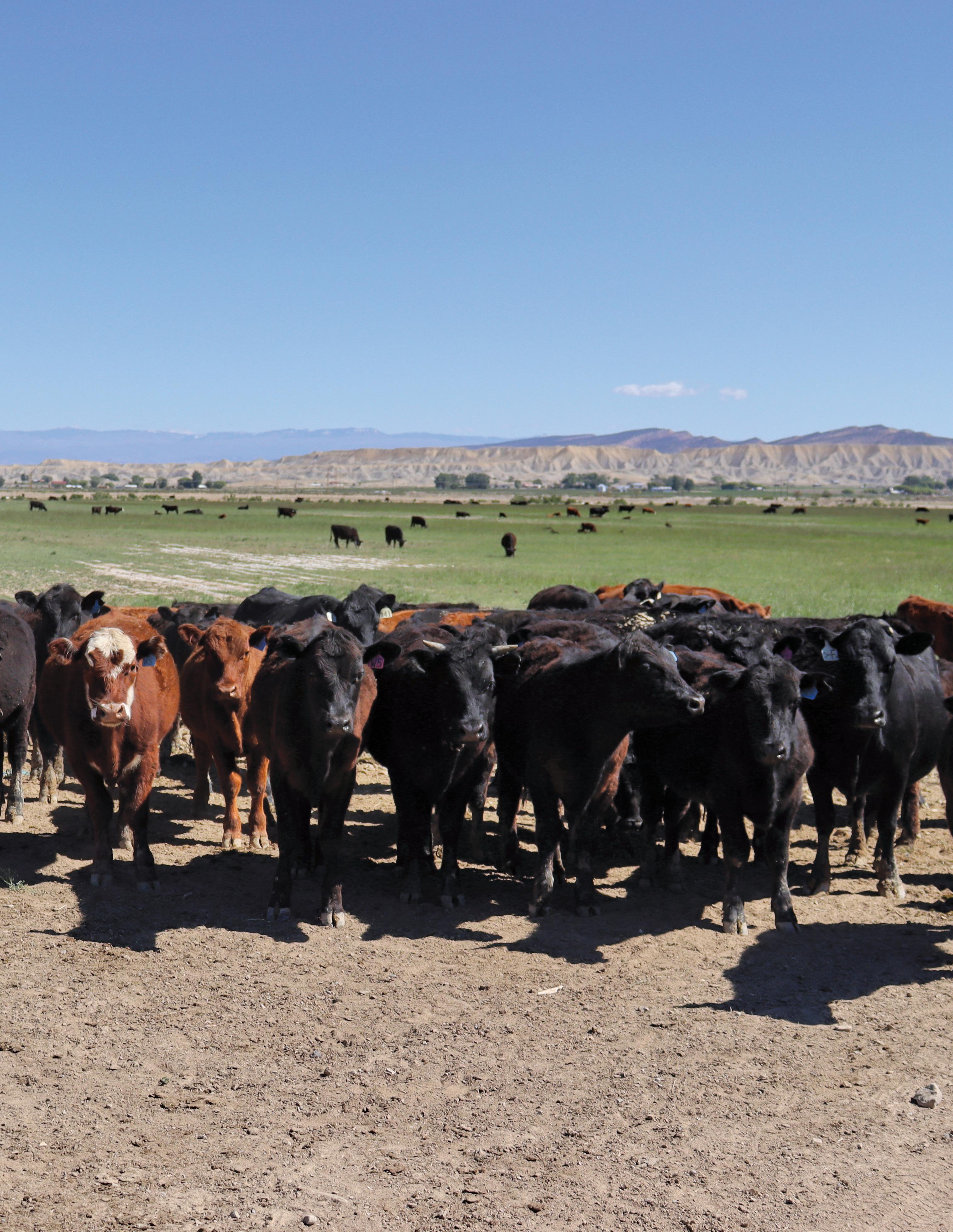 Sarah Ruiz Science Writer
Sarah Ruiz Science Writer
Climate Science for Change Fall 2022 14
“Talk to Jim. Jim knows everything.”
That’s what everyone told Woodwell Assistant Scientist, Dr. Jennifer Watts, when she started writing up a research plan to study soil carbon on U.S. rangelands. “And indeed, he does,” Dr. Watts says. “He knows everything about the region, about grazing management, species management, anything having to do with land management on these ranches.”
With his felt stetson, dusty jeans, and perennial tan, ranch manager Jim Howell looks a bit like the kind of cowboy Hollywood might dream up. And in a way he is—despite looking at home on the range, Howell grew up in Southern California. But he spent his summers out in Colorado’s Cimarron mountains, working on his grandfather’s cattle ranch.
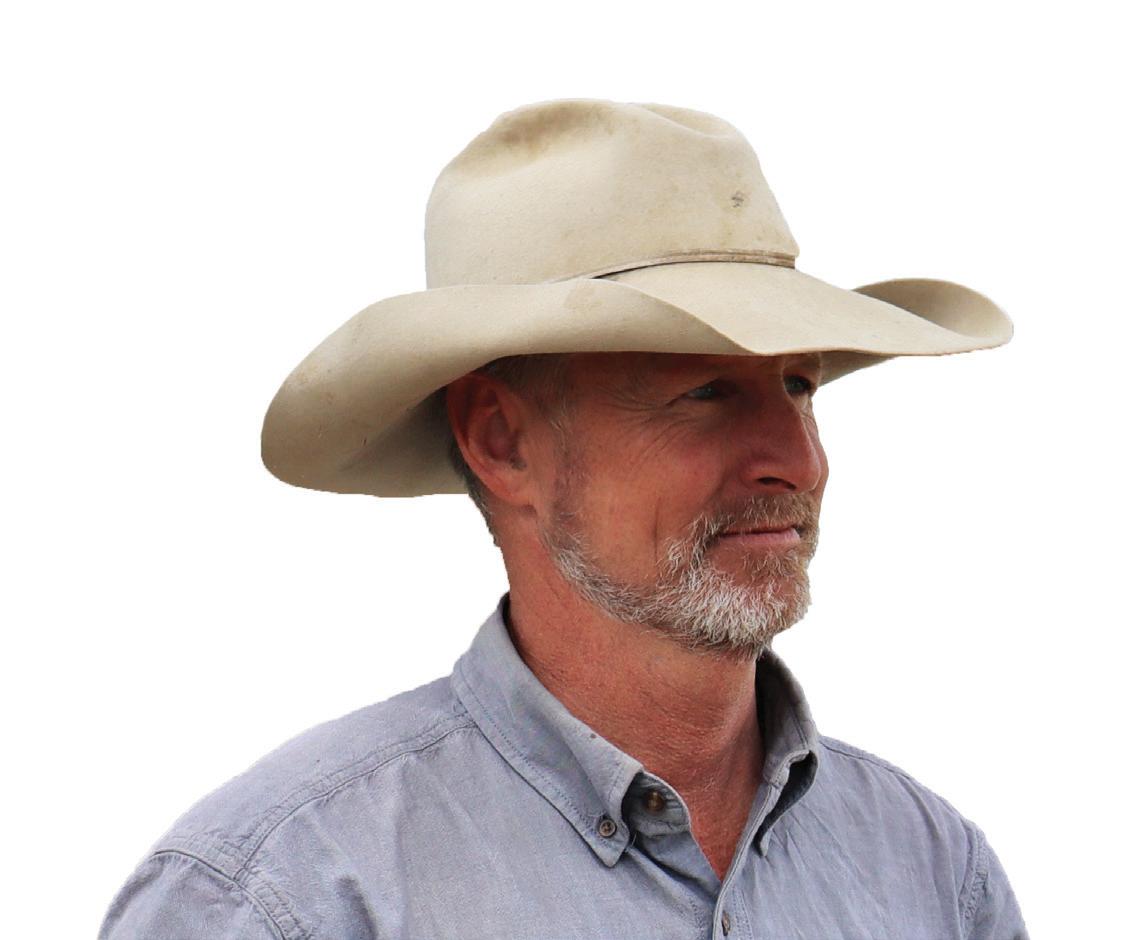
Those summers were Howell’s introduction to the idea that the way livestock are managed can change their impact on the land—a thread that would pull him through a college degree in animal production, toward a career “knowing everything” about holistic ranch management. He was first made aware of this this concept while walking the fence line separating his family’s property from a patch of public land being used to graze sheep.
“I noticed there were lots of very healthy, perennial, bunch grasses on the sheep side, while our side of the fence had degraded to mostly silver sagebrush, Kentucky bluegrass, and dandelions,” says Howell. “And I just didn’t understand why the differences were so stark.”
Howell’s cattle were stocked continuously on the land, low in number but able to graze year round, while the sheep grazing permit required rotation. There might be a great flock of sheep up there one day and nothing but grass for the remainder of the year. That difference, it turned out, dramatically altered the kinds of plants that could flourish on the land.
“I became aware then that the way that we’d been managing our cows in our country up there was leading to its slow, longterm, ecological degradation. And I didn’t know what to do about it,” says Howell.
The grazer makes the range
There have always been animals grazing the American west— before colonizers, even before Native peoples. On the Great Plains there were bison; in the mountains and high altitude deserts of Southwestern Colorado, it was bighorn sheep and pronghorn antelope, as well as elk and mule deer. All three are rare sights now, with populations decimated by overhunting and habitat degradation.
Now, if you see any animal grazing on these ranges, it will probably be cattle.
Despite displacing native species, cows can still fill a natural niche in the rangeland ecosystem. Antelope, bison, sheep, and cows all belong to a group of animals called ruminants— animals that can digest grass. Many grasslands have co-evolved with ruminant species; their roaming feasts influence plant growth the same way pruning might affect the shape of a tree. Occasional shearing by a hungry cow stimulates new grass growth. It also creates a more competitive environment that supports a diverse array of plant species.
Grazing also plays a part in cycling nutrients and storing carbon in the soil. In a frequently dry climate like this one, digestion breaks down plant matter much faster than it would decay in the environment. Manure fertilizes new plant growth and returns carbon to the soil. Let this process continue unencumbered for a couple hundred thousand years, and you can build up a valuable carbon sink. And as long as the number of cattle isn’t rising, the oft-cited methane emissions from cow burps are minimal and cycled back down into the plants that grow up after grazing.
Since settlers arrived, however, the land has been put through centuries of abuse. Public lands were, for a long time, left open to unregulated grazing. Many rangelands have been over-stocked and grazed too frequently in order to make a profit and meet growing global beef demand. Land has been ecologically degraded, valuable topsoil was lost, and carbon stores declined as a result.
Ranch manager Jim Howell has built a career on the idea that grazing could offer a natural climate solution.
15 Climate Science for Change Fall 2022
Cattle at a Delta, Colorado ranch. / photo by Sarah Ruiz Ranch manager Jim Howell. / photo by Sarah Ruiz
Let the cow do the work
It would be easy to blame cows for this. But really, they’re not behaving much differently than pronghorn or bison would. They eat what’s in front of them. And they eat the tastier plants first. Howell likens it to a salad bar.
“If you go into a salad bar and there’s some lettuce that has been sitting there for three months, and some of it that’s just been replaced that morning, you take the new stuff. So that’s exactly what the cow does,” Howell says. “If she’s not made to move anywhere new, she’s just going to keep coming back and grazing the regrowth of the good stuff as long as it’s there.”
Pretty soon, perennial grass species, important for their deep roots that help prevent erosion and store carbon and water longer, are grazed into nothing. All that’s left are the sagebrush, dandelions, and other less desirable plants that Howell noticed dotting his family ranch.
“So the whole thing is about how the cows are managed, it’s not the cow itself that is a problem,” says Howell.
If bad management can degrade the land, then good management should be able to restore it. While studying animal science in college, Howell encountered the concepts of “holistic management”, a term that began to decode this relationship between management practices and the health of the land. Controversial at its introduction a half century ago, holistic ranching has been gaining traction, and Howell and his ranch management company, Grasslands LLC, have helped urge its uptake.
The core principle is to make management decisions that restore lands and keep cattle in balance with the rest of the ecosystem—helping them fill the niche of the ancient grazers. This comes with a host of co-benefits, including water retention and higher plant productivity, that actually end up improving economic profitability for ranches in the long run. Simple adjustments, like lengthening the time between grazing a pasture again and wintering cows on native ranges instead of hay, can turn cattle from an ecosystem destroyer to an ecosystem helper.
“The trick is to let the cows do all the hard work,” says Howell.
Carbon modeling: The rancher’s secret weapon
Dr. Watts and Woodwell Senior Scientist Dr. Jonathan Sanderman, along with Dr. Megan Machmuller of Colorado State University, are interested in quantifying those cobenefits, especially carbon storage.
“In the western U.S. on our rangelands, just like in our croplands, we can change how we manage in a way that potentially could become a natural climate solution,” says Dr. Watts. “One where we’re bringing in more carbon than we’re emitting and we’re creating ecosystems that not only are beneficial for carbon sequestration, but also have more biodiversity, offer more habitat for wildlife, and more water conservation.”
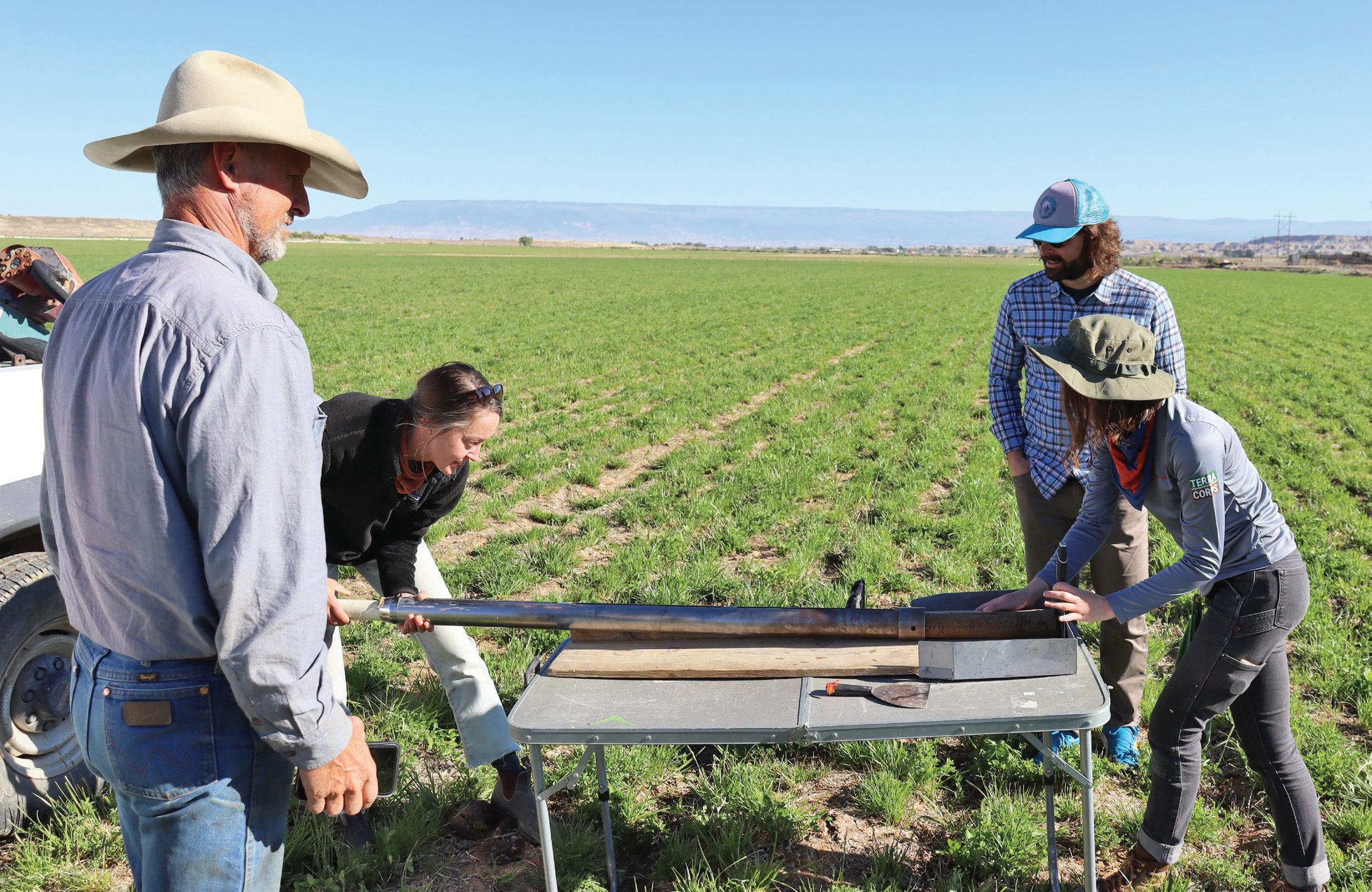
In order to prove that value however, scientists need a baseline understanding of how much carbon is currently stored across both traditionally- and holistically-managed rangelands. It’s
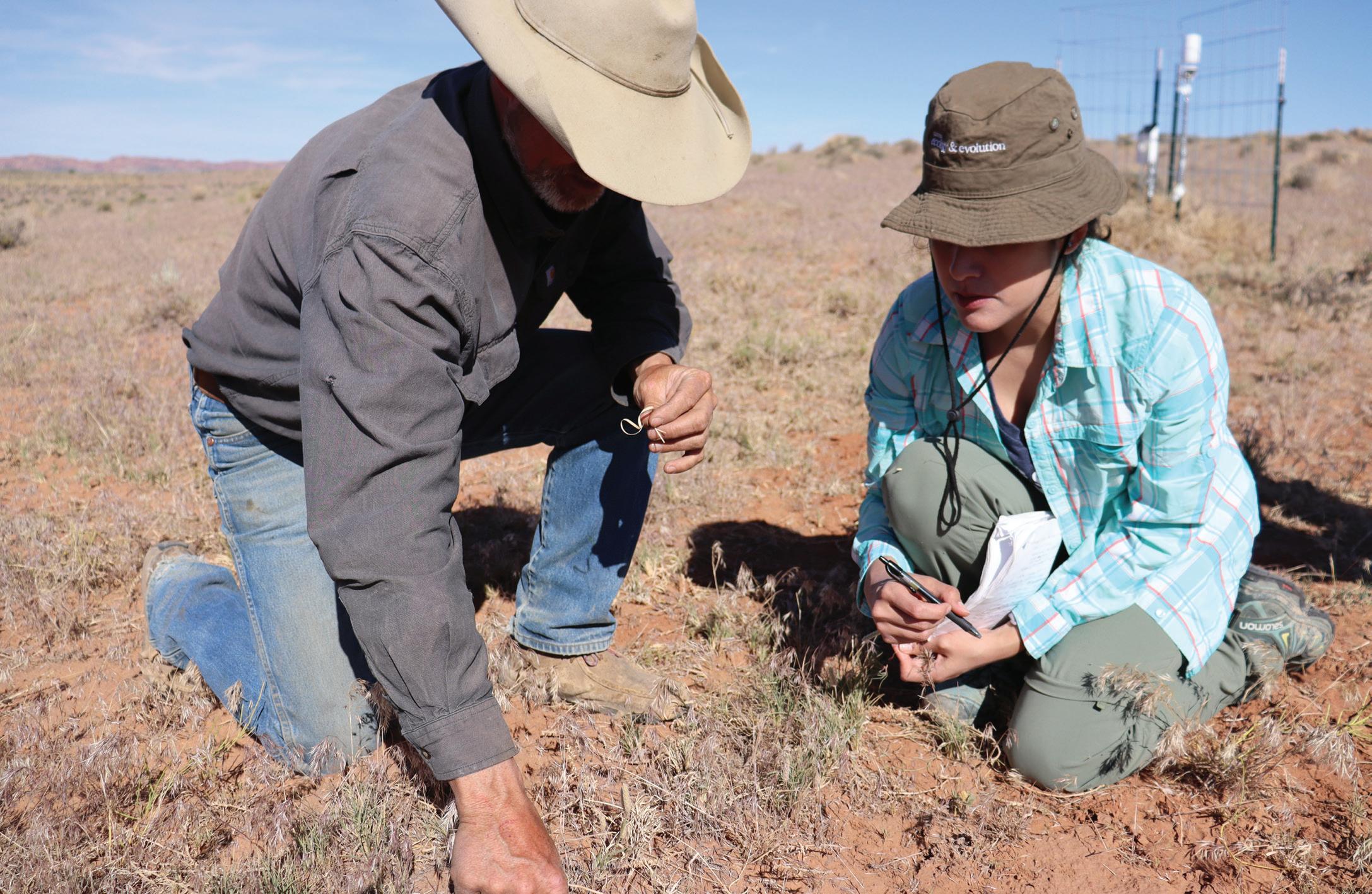
Climate Science for Change Fall 2022 16
hard to get an estimate for such a large area (roughly 30% of the U.S. is covered with rangelands), so they are using a remote sensing model, which they verify with strategic on-theground sampling.
Howell’s work also created the perfect conditions for the research team to study the long term carbon benefits of altered ranching practices, which is a tricky thing to test empirically. Ranchers must constantly adjust their management techniques to stay profitable.
“In a classical research setting, you try to control all the variables but one, but in real life that’s not what happens,” says Howell. “Nothing is controlled. Day to day, you have to adapt to constantly changing conditions.”
The ranches Howell’s company works with make those day-today decisions based on the principles of holistic management, so tracking carbon on those ranches over time offers the opportunity to generate baseline data on how they differ from more traditionally managed ones.
Howell also brings the expertise of a life spent on the range. He can identify just about any plant growing in the pasture, tell you which are native, which are invasive, and which used to be the preferred food of prehistoric ground sloths. His eye is trained to see diversity even in martian-esque deserts and read the history of the land in the structure of the soil. In May of 2022, Howell guided Drs. Sanderman, Watts, and Machmueller and their teams on a sample collection trip through Southwest Colorado and Utah. The researchers took soil cores, plant samples, moisture and temperature readings, and analyzed carbon fluxing in and out of the pasture.
The ultimate goal is to create a rangeland carbon management tool that will make the soil carbon data model accessible directly to ranch managers. Dr. Watts hopes having that data in hand will enable more ranchers to make management decisions with climate in mind. Dr. Sanderman also notes that it could be useful in eventually helping ranchers get paid for sustainable practices.
“Rangelands haven’t been included in voluntary carbon credit markets like cropping systems have,” says Dr. Sanderman. “Monitoring is a big problem because there’s so much land. How do you keep track of all that? That’s what our tool will be able to offer.”
Growing a resilient ranch
There are limits to what grazing can accomplish, though. The lands out west aren’t suitable for large-scale cropping, being too dry or too mountainous, which makes them perfect for cattle. But when the animals take up space on land that would otherwise be used to produce crops—or worse, penned into feedlots—their benefits are compromised. Howell also notes that some grazing lands are already as saturated with carbon as they can be. And there remains the fact that ranching will get more complicated as the climate changes.
At the Valdez ranch in Delta, Colorado, Dr. Sanderman and research assistant Colleen Smith unfold a collapsible table in a field of cracking mud, dotted with the brittle stick skeletons of dead grass. Nearby, Dr. Machmuller is assisting Howell in extracting a long metal cylinder from the ground. It was plunged into the soil by a hydraulic corer attached to a pickup truck that’s idling in the field. Howell and Dr. Machmuller lay it out horizontally on the table and slide out the soil core—a 50 centimeter long history of the land beneath their feet.
Howell breaks open a section of the core with his fingers, revealing clusters of white crystals. This is a pasture that has been abused; over-irrigation by previous owners brought salts to the surface. Now nothing will grow here and wind gusts threaten to blow away loose topsoil. It’s a sacrifice zone. The current owners are considering installing solar panels instead.
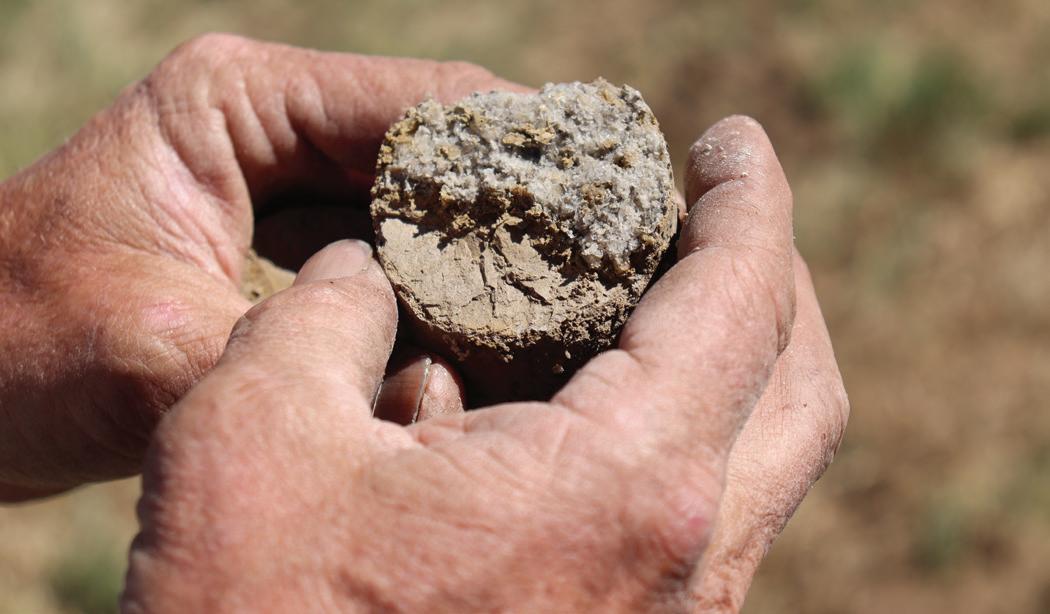
Water is a big issue for ranchers and it’s threatening to get bigger. The region is constantly dipping in and out of severe drought, and in a place that depends heavily on winter snows for its groundwater and rivers, a warmer, dryer climate is a threat.
Agriculture will depend more on irrigation as the climate warms and precipitation patterns change. This empty pasture is proof that it’s not always a viable solution, though, and will become less so as climate change advances.
It enforces the urgency of the work Howell and team are doing. The faster we can draw carbon out of the atmosphere, the more successful these ranches are likely to be in the long term. The better managed the ranch, the more resilient it will be in the face of tough conditions.
In the end, Dr. Watts says, the outcome rests in the hands of ranch managers—people like Howell.
“Land managers are the ones that ultimately are going to make or break this country.”
Jim Howell looks on as a soil core sample is extracted for examination. / photo by Sarah Ruiz
17 Climate Science for Change Fall 2022
A core sample showing evidence of overuse. / photo by Sarah Ruiz
Pushing Climate Policy Forward
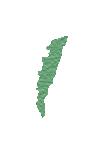
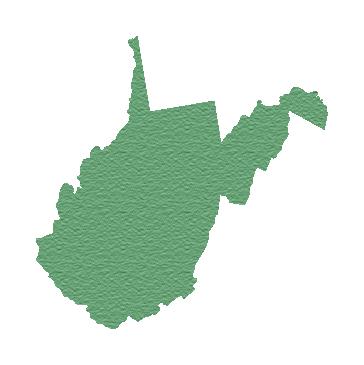
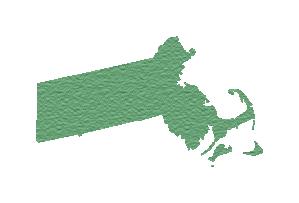
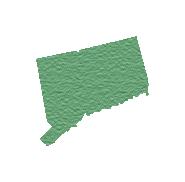
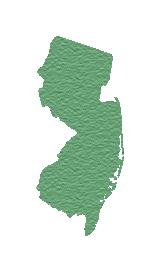
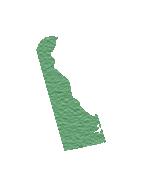
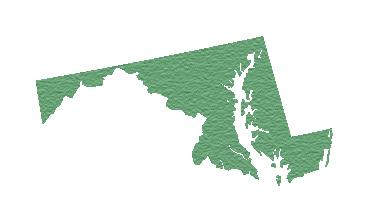
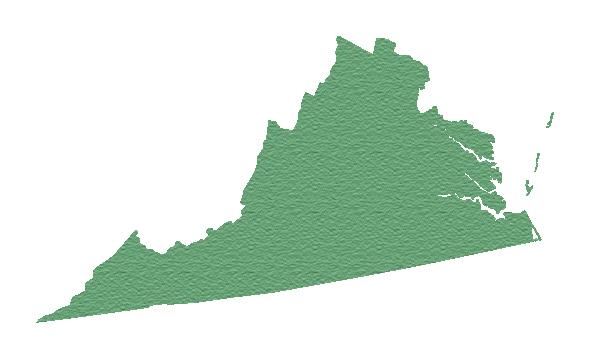
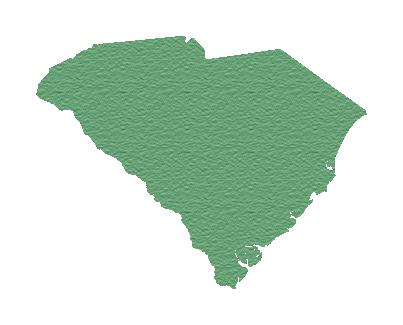
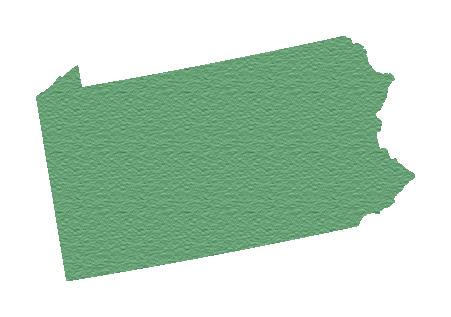
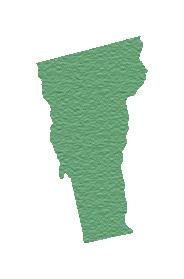
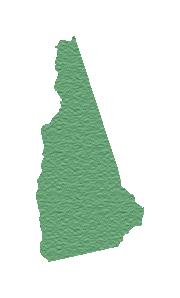
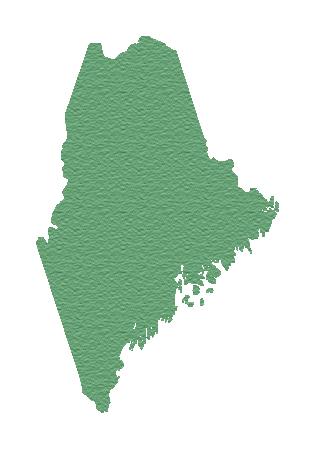
In September, Woodwell staff, board members, and partners traveled to both Washington, D.C. and New York, NY in the span of one week to connect with policymakers. The massive Climate Week push kicked off Woodwell’s campaign to see natural systems—both the risks and the solutions they present—fully and fairly accounted for in climate policy.
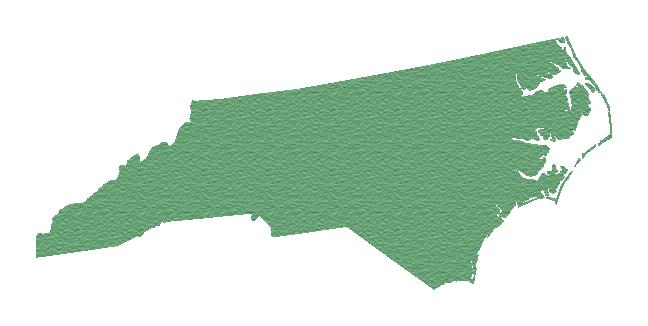
Wednesday, September 21 New York, NY


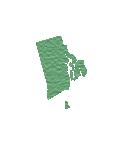
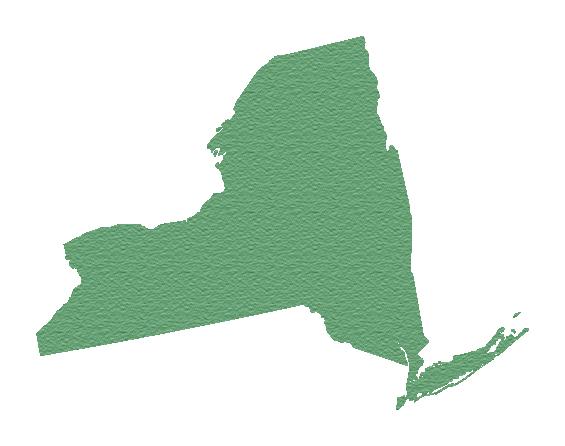
In the morning, Woodwell scientists Drs. Mike Coe, Glenn Bush, and Wayne Walker hosted an early breakfast with key stakeholders in town for New York Climate Week to discuss the challenges and opportunities of carbon markets—a complex and sometimes controversial natural climate solution.
By the evening, Dr. Sue Natali had joined Dr. Coe, Woodwell Chief of Communications Dr. Heather Goldstone, and other staff at the Explorers Club to host a hybrid event. Titled “Nature in our Climate Budgets,” it highlighted the climate connections between the tropics and the Arctic. The inextricable human element in rapid landscape change and the importance of supporting Indigenous leadership was a common theme. In both the Arctic and tropical regions, Indigenous communities are situated on the frontlines of climate-induced change.
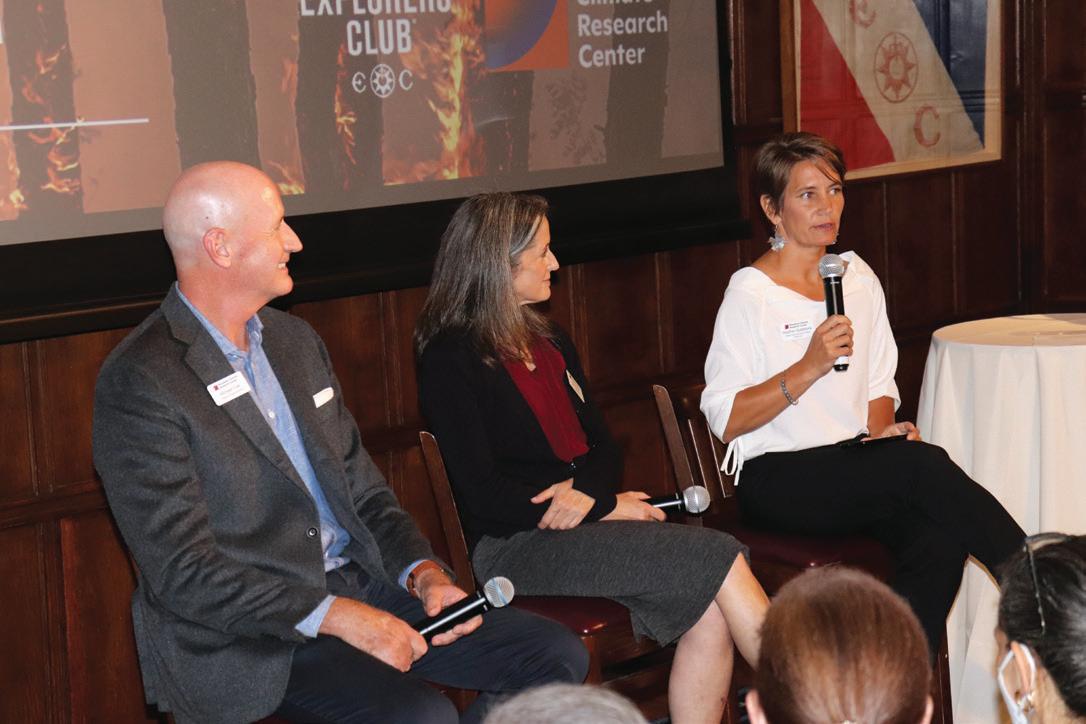
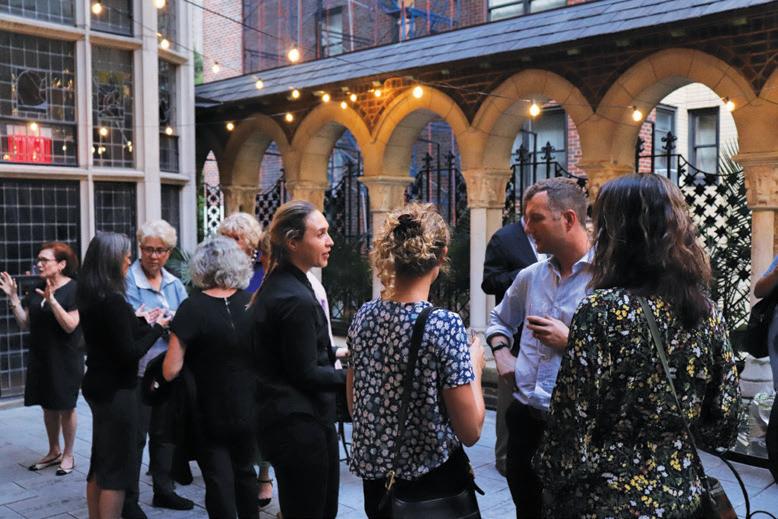
“Humans are not separate from nature. We are nature. It’s critical, if we want to find solutions to climate change that are just and that are viable, that we have Indigenous people leading the charge and providing us with guidance.”
— ARCTIC PROGRAM DIRECTOR DR. SUE NATALI
Sarah Ruiz
Climate Science for Change Fall 2022 18
Sarah Ruiz
on Two Fronts
Tuesday, September 20 Washington, D.C.
Together with our partners at the Niskanen Center, Woodwell Climate scientists, staff, and board members participated in a “fly-in” on Capitol Hill. The team had 15 meetings with elected officials and congressional offices, focusing on opportunities to support natural climate solutions through the next Farm Bill.
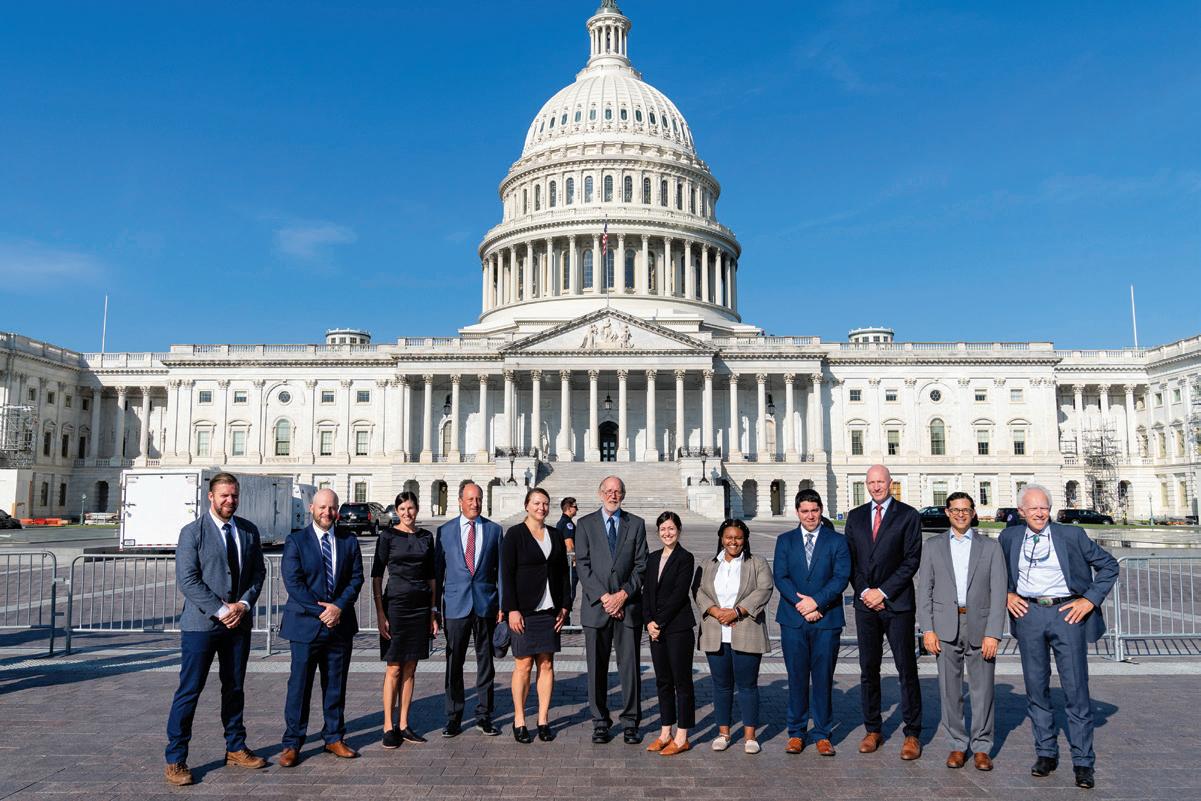
“This fly-in highlights Woodwell’s commitment to impact. We’re meeting with congressional offices on both sides of the aisle to offer our expertise and ensure they have the tools they need to make climate-smart decisions. To affect change, it’s essential that our science gets into the hands of decision makers.”
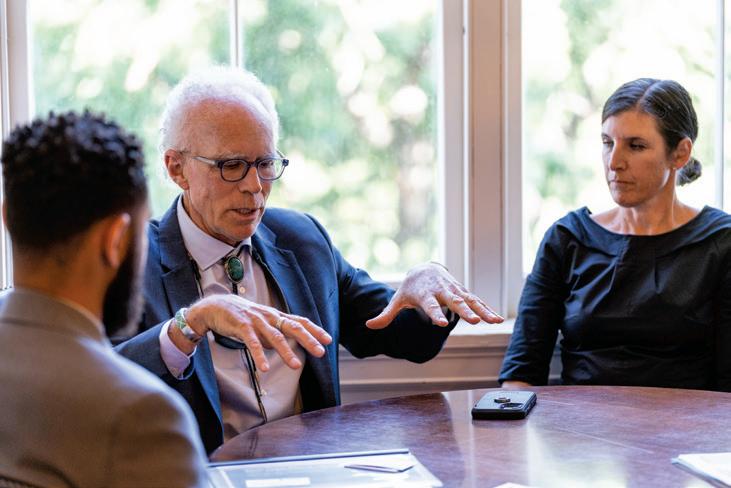
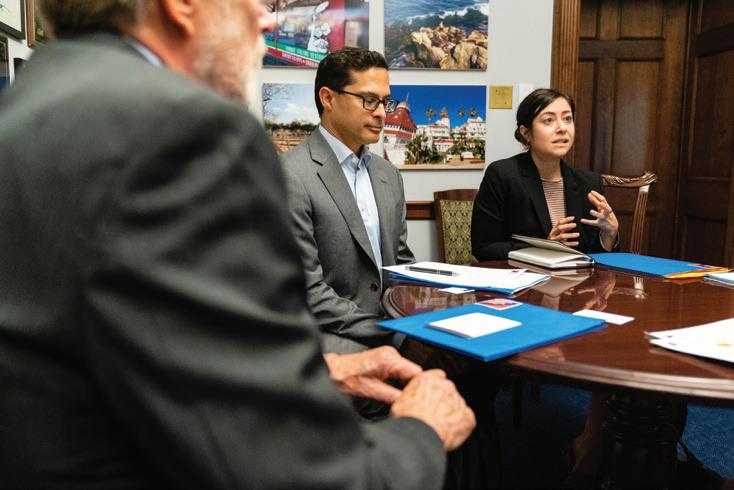
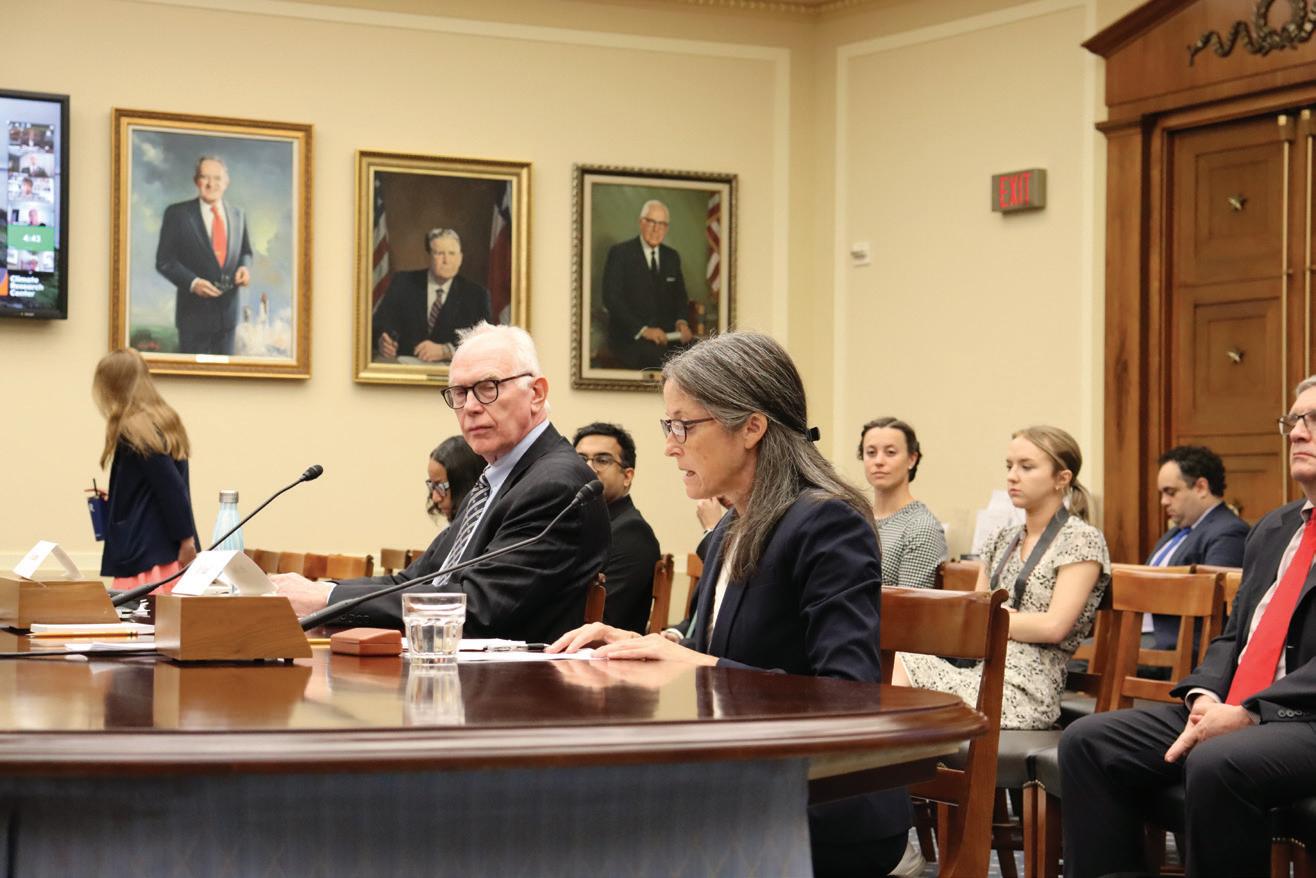 — CHIEF OF EXTERNAL AFFAIRS DAVID MCGLINCHEY
— CHIEF OF EXTERNAL AFFAIRS DAVID MCGLINCHEY
Woodwell Arctic Program Director and Permafrost Pathways lead Dr. Sue Natali testified before the House Committee on Science, Space, and Technology in a hearing on “Strengthening Science to Respond to a Rapidly Changing Arctic.” Dr. Natali highlighted the devastating impacts of rapid landscape change facing Northern communities and the global climate threat posed by greenhouse gas emissions from permafrost thaw. She called for increased federal research support to expand the scope and timeframe of research, improve interagency coordination and international collaboration, and support Alaska Native tribes to coproduce knowledge and lead climate change research.
“I came into this hearing thinking ‘ice, ice, ice, ice.’ I’ve read a lot of articles about a world with ice. And now I’m leaving thinking ‘permafrost, permafrost, permafrost.’”
— CONGRESSWOMAN HALEY STEVENS
Eric Lee
Eric Lee
19 Climate Science for Change Fall 2022
Eric Lee
Fund for Climate Solutions marks five successful years
Sarah Ruiz Science Writer
Over the last five years, the Fund for Climate Solutions (FCS) has developed from an experimental funding plan into the seed of some of Woodwell Climate Research Center’s most innovative and impactful research.
Formed in 2018, when government funding for science, especially climate science, was being cut back, the FCS offered a source of internal funding that would support new research projects focused on solutions. The fund has now raised over $10 million and launched projects that span the globe—from the Arctic tundra, to the Congo rainforest, to the rangelands of the American West.
Board member and co-chair of the FCS Capital Campaign, Connie Roosevelt, says one of the greatest successes of the program has been its ability to speed up the pursuit of new research.
“Being involved with FCS from the very beginning has been a bit like watching a race horse released from the barn,” says Roosevelt. “I had not appreciated the wealth of productive time that an internal grant program would free up for our scientist grantees. They are now able to pursue the most promising research leads without stopping to find new funding sources or changing the direction of their work to fit the priorities of a potential funder.”
That freedom has allowed Woodwell scientists to pursue projects that are high-risk, but transformative. Just this year, the FCS awarded its largest cohort to date. The new projects will have unprecedented reach, covering issues of Indigenous stewardship of Amazonian forests, global security in a changing climate, tracking contaminants released from thawing permafrost, and more.
The original fundraising goal for the FCS, 10 million dollars, has been surpassed, but board member and chair of the Development Committee, Joseph Mueller, says he intends the fund to continue far past this milestone. Mueller believes the FCS offers a powerful proof of concept for how the Center funds its projects.
“I think the lightbulb has gone on, and we’re really trying to brighten that lightbulb. This is the direction we need to go in the future and even though we hit $10 million, in my mind’s eye this is just the start,” says Mueller.
The projects highlighted on the following pages are just a subset of the many that have grown out of the FCS.
For more information on how you can support the Fund for Climate Change, please contact Leslie Kolterman at lkolterman@woodwellclimate.org.
Projet Équateur tests sustainable rice in the DRC
Agriculture, deforestation, and emissions are often linked, especially in areas where people are driven to clear land in order to feed their families. Developing agricultural practices that reduce this pressure could help save tropical forests.
Associate Scientist Dr. Glenn Bush and Projet Équateur Consultant Joseph Zambo have been testing “climate smart” rice production in the Democratic Republic of Congo (DRC), with the hopes of increasing yields over the same area of land and reducing the emissions produced by the crop.
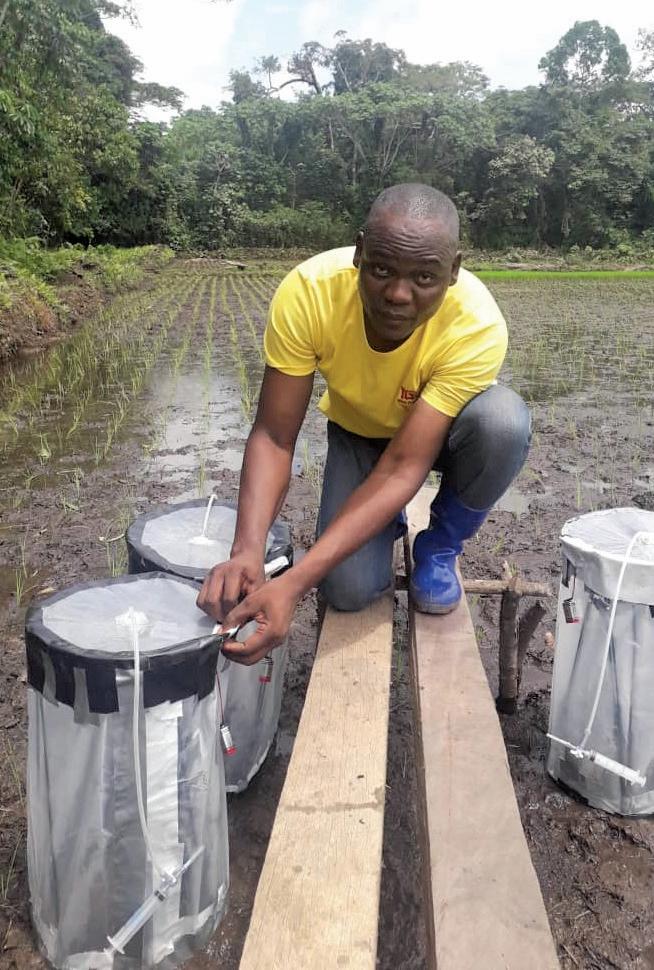
So far, results have shown that sustainable rice growing practices have the potential to increase yields from 46 sacks of rice per acre to roughly 60—the equivalent of expanding a farm’s area by 30%.
The project is now beginning to assess the feasibility of expanding this kind of production. Zambo is leading surveys of farmers in Équateur Province, DRC to better understand what barriers might exist to the adoption of new farming methods.
Joseph Zambo sampling greenhouse gas fluxes from newly planted rice fields. / photo courtesy of Joseph Zambo
Climate Science for Change Fall 2022 20
Informing policy around salmon, water and people in Alaska
The Arctic is warming nearly three times as fast as other parts of the globe, which presents a major challenge for cold-adapted species like the Chinook salmon. Salmon are a lynchpin of Alaskan culture and economics. Alaska Native tribes use annual salmon migrations as a subsistence food source, and sport and commercial fishing industries bring millions of dollars to the state. Heat stress can jeopardize their ability to spawn successfully.
Associate Scientist Dr. Anna Liljedahl’s project convened experts on fish biology, water chemistry, and social policy to better understand and address the challenges facing this keystone species as the climate changes. While researchers track rising water temperatures of streams and heat stress in fish, policy experts and community organizers are working with Alaskan tribes and local residents to develop policy proposals that are fair to, and supported by, the community.
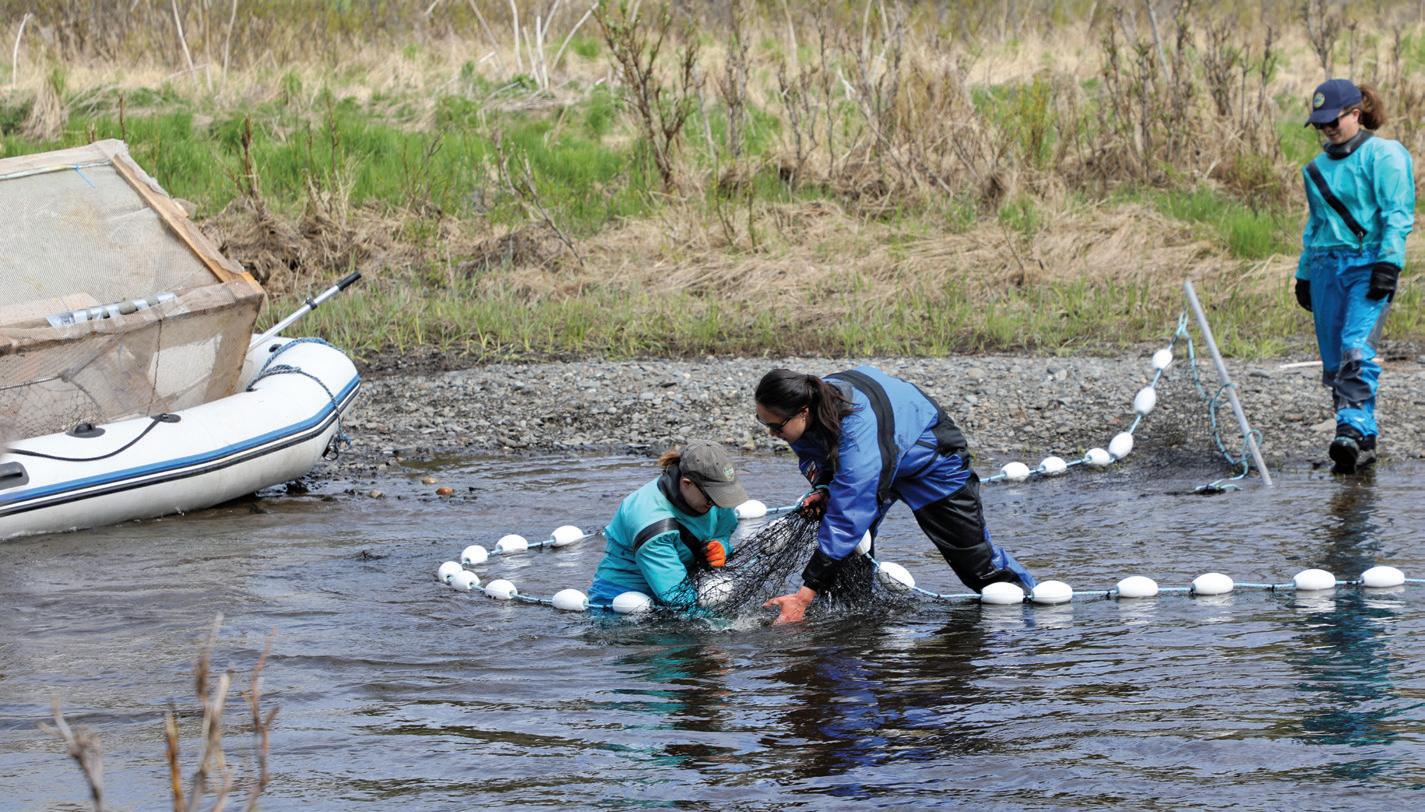
The original FCS project proposal has been expanded and the group is now seeking additional funding from the National Science Foundation which would allow them to continue the long and important work of building relationships and collecting data in the region.
Developing a rangeland carbon monitoring tool
Thirty percent of U.S. lands are rangelands used to raise and graze cattle, sheep, or other livestock. Given their vast area, these grasslands have the potential to be valuable carbon sinks, provided they and the animals living on them are managed sustainably.
Senior Scientist Dr. Jonathan Sanderman and Assistant Scientist Dr. Jennifer Watts are working to create a geospatial model of carbon stored on rangelands across the U.S. This will provide baseline data that can be used to track changes in how much carbon they store over time. Their team is also constructing a brand new tool that will make carbon storage and other rangeland management data easily accessible to ranch managers. The goal is that, by seeing first-hand how changes in management techniques impact their land, ranchers will be motivated to employ sustainable practices and potentially be eligible to receive payments via voluntary carbon markets.
The project has completed several successful field seasons, installing equipment and taking measurements to help calibrate their model. Woodwell scientists, Montana State University, and Turner Ranches co-hosted a twoday workshop for ranch managers in Montana to discuss ranching for carbon and ecosystem benefits. The work has garnered interest across the region, attracting stakeholders that might not otherwise be engaged in climate conversations.
A legacy gift can help Woodwell Climate make an even greater impact in the fight against climate change for generations to come. Bequests, charitable gift annuities, and charitable remainder trusts combine your philanthropic interests with your financial needs and tax-planning strategies. Contact Beth Bagley at ebagley@woodwellclimate.org to learn more.
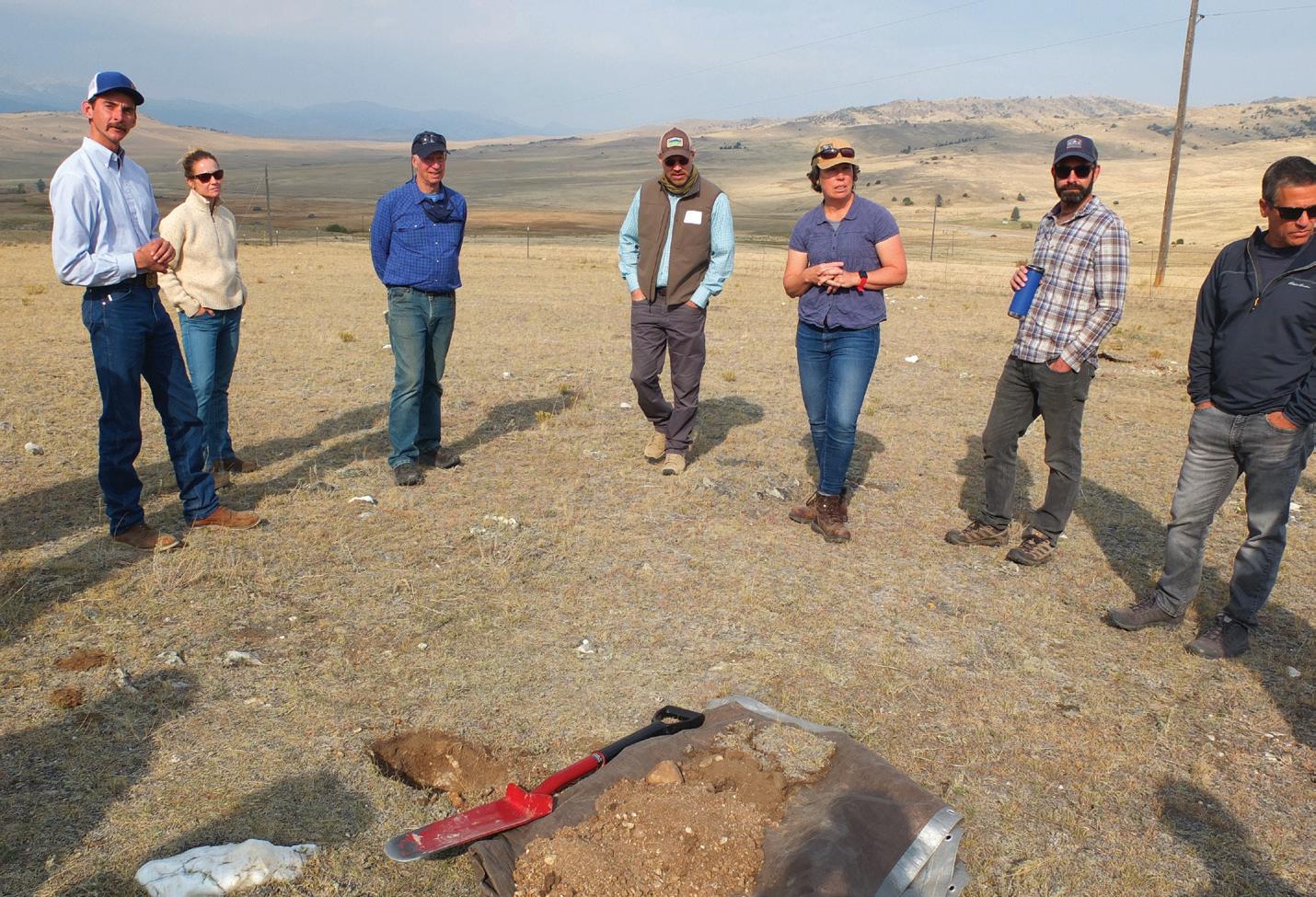
/
Catching
/
21 Climate Science for Change Fall 2022
LEAVE A LEGACY
A
field site visit during the rangeland carbon workshop held in Bozeman, MT in September 2021.
photo by Jonathan Sanderman
salmon to take measurements.
photo courtesy of Madeline Lee
Permafrost Pathways celebrates six months
Jessica Howard Arctic Communications Specialist
Six months ago, with funding through the TED Audacious Project, Woodwell launched Permafrost Pathways—a new multidisciplinary project connecting science, people, and policy for Arctic justice and global climate—along with our partners at the Arctic Initiative at Harvard Kennedy School, the Alaska Institute for Justice, and the Alaska Native Science Commission.
On April 11, 2022, Woodwell Climate Research Center’s Dr. Sue Natali took to the stage at the TED2022 annual conference in Vancouver, B.C., to introduce Permafrost Pathways. With poised urgency, Dr. Natali delivered a powerful speech highlighting the compounding threats that Arctic communities and our global climate
face due to thawing permafrost. Her passionate delivery of such a critical message was met with a standing ovation and has now been viewed more than one million times—even comedic actor and writer Rainn Wilson shared Dr. Natali’s talk on Twitter.
Monitoring and Modeling
The Permafrost Pathways project made substantial progress during its first field season. Woodwell’s Dr. Kyle Arndt and Patrick Murphy, working with Dr. Sue Natali, installed a new eddy covariance flux tower in Churchill, Manitoba, Canada. This is the inaugural tower of Permafrost Pathways—which aims to coordinate a pan-Arctic carbon monitoring network to fill data gaps that have hindered integration of permafrost
Monitoring team in Alaska heading out to a data collection site. / photo by Valeria Briones.
thaw emissions and impacts into climate targets and adaptation governance.
The project also supported five additional existing eddy covariance sites across Canada by providing instrumentation and/or technical support to ensure these existing towers continue to collect data and to expand their measurement capacity to include both carbon dioxide and methane measurements throughout the year.
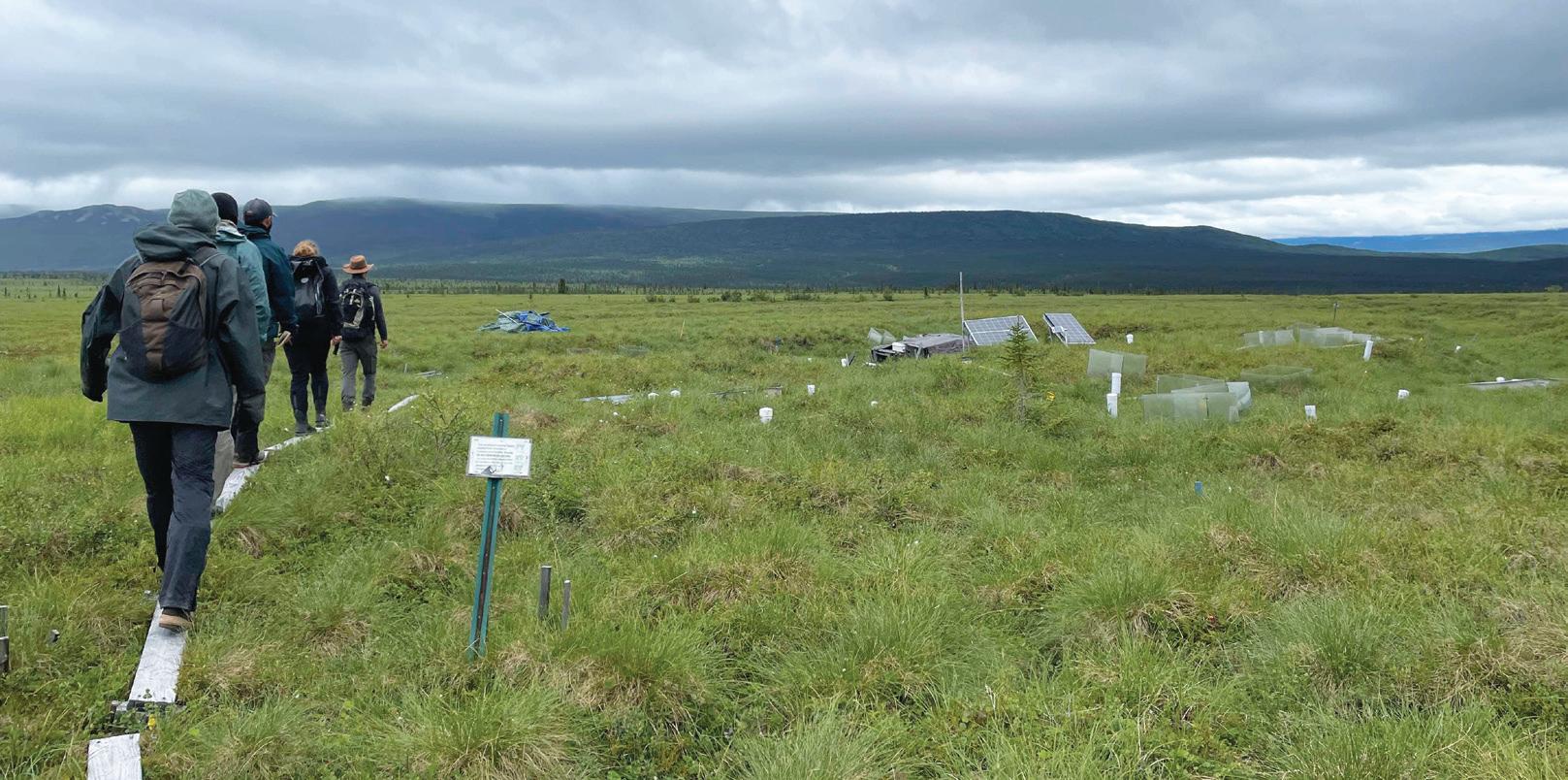
The Permafrost Pathways modeling team, led by Woodwell’s Dr. Elchin Jafarov, has started building the necessary infrastructure to handle the massive computational task of modeling and predicting carbon fluxes from thawing permafrost across the Arctic and boreal regions. Developing the model’s capacity to represent wildfire, abrupt thaw, and carbon fluxes in different Arctic ecosystems will provide better historical assessments, near-term forecasts, and longer-term projections under various policy scenarios that will allow tracking of the changing landscape and more accurately project future emissions from permafrost thaw.
Adaptation Strategies
In September, Dr. Sue Natali and the Alaska Institute for Justice’s Dr. Robin Bronen and Ben Baldwin traveled to Alaska to meet with Tribal liaisons in Kuigilnguq/Kwigillingok and Nunapicuaq/Nunapitchuk to collect water samples and install permafrost monitoring equipment. Both Alaska Native villages are severely impacted by permafrost thaw, erosion, and flooding, and are making difficult decisions about how they will adapt to the rapid and hazardous changes happening in their communities.
What began as a Fund for Climate Solutions funded effort to install an eddy covariance tower in Alaska has become a $41 million TED Audacious project with international reach.
Climate Science for Change Fall 2022 22
In late September, the Permafrost Pathways team hosted the Alaska Institute for Justice and Kuigilnguq/ Kwigillingok and Nunapicuaq/ Nunapitchuk Tribal liaisons at Woodwell Climate’s campus for an Indigenous-led adaptation strategy workshop. Kuigilnguq/Kwigillingok and Nunapicuaq/Nunapitchuk are two of four Alaska Native community partnerships established over the past six months, which now also include Cingik/ Siŋik/Golovin and Cev’aq/Chevak.
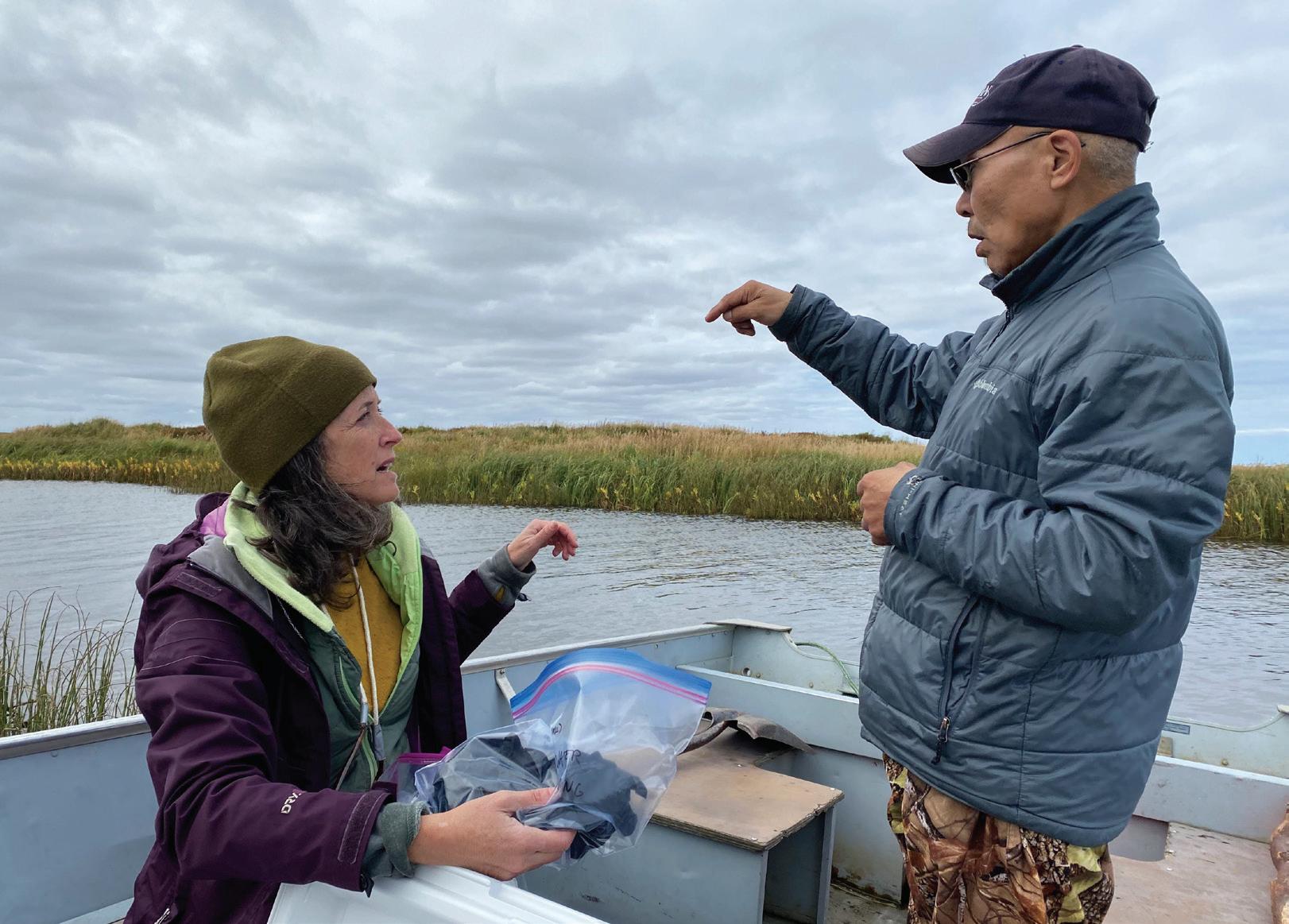
Mitigation Policy
In June, Dr. Rachael Treharne and Melissa Shapiro of the Permafrost Pathways policy team attended the 56th session of the Subsidiary Body for Scientific and Technological Advice (SBSTA) and Subsidiary Body for Implementation held in Bonn, Germany. During the conference, Dr. Treharne joined the Bolin Center for Climate Research at Stockholm University and the Inuit Circumpolar Council Canada for the International Climate Cryosphere Initiative’s (ICCI’s) live streamed press event urging governments to account for emissions from permafrost thaw as they work towards the Paris Agreement goals.
During that same week, Brooke Woods from the Permafrost Pathways policy team attended the National Congress of American Indians (NCAI) MidYear Conference and Marketplace in Anchorage, Alaska. NCAI provided attendees, which included Tribal leaders, Native youth, and partners from across Indian country, with an opportunity to work collaboratively to protect and enhance tribal sovereignty with the theme of “Thinking Beyond Self-Determination.”
On September 20, 2022, Dr. Sue Natali testified to the House Committee on Science, Space, and Technology on the subject of strengthening science to respond to a rapidly changing Arctic. Dr. Natali made the case for more Congressional support for conducting more extensive permafrost science and for Alaska Native tribes to coproduce knowledge and lead climate change research.
On September 26 and 27, 2022, Permafrost Pathways partners at the Arctic Initiative at Harvard Kennedy School hosted a convening at Harvard University. The Permafrost Pathways team was joined by representatives from federal agencies, Alaska Native
communities and organizations, and Arctic science institutions. The meeting was an opportunity for invitees to learn about Permafrost Pathways, offer their thoughts about the challenges and opportunities at the intersection of permafrost science and policy, and consider possibilities for collaboration.
Most recently, Permafrost Pathways hosted two sessions at the Arctic Circle Assembly in Reykjavík, Iceland and had a presence in the Cryosphere Pavilion at COP27 in Sharm el-Sheikh, Egypt in November.
Publications and media highlights
Several members of the Permafrost Pathways team have been co-authors on new publications and featured in media outlets including The New York Times, Alaska Public Media, and Time.
Journal publications
Frontiers in Environmental Science Nature Climate Change Human Ecology Ecology and Society
NYU Review of Law and Social Change Environmental Research Letters Nature Communications
Media coverage
The New York Times Arctic Today
Alaska Public Media | “Talk of Alaska”

Alaska Public Media | “Alaska Insight” Time | “Quick Talks” The Carbon Copy

Stay connected
permafrost.woodwellclimate.org
@woodwellarctic
MATCH
Increase your giving impact through your employer’s matching gift program. Many employers will match any charitable contributions made by their employees, retirees and/or employees’ spouses. Contact Chris Boudreaux at cboudreaux@woodwellclimate.org to find out what information your employer needs.
23 Climate Science for Change Fall 2022
Dr. Sue Natali with a Tribal liaison during a September visit to Nunapicuaq/Nunapitchuk, Alaska. / photo by Rachael Treharne
Annual Report 2021–2022
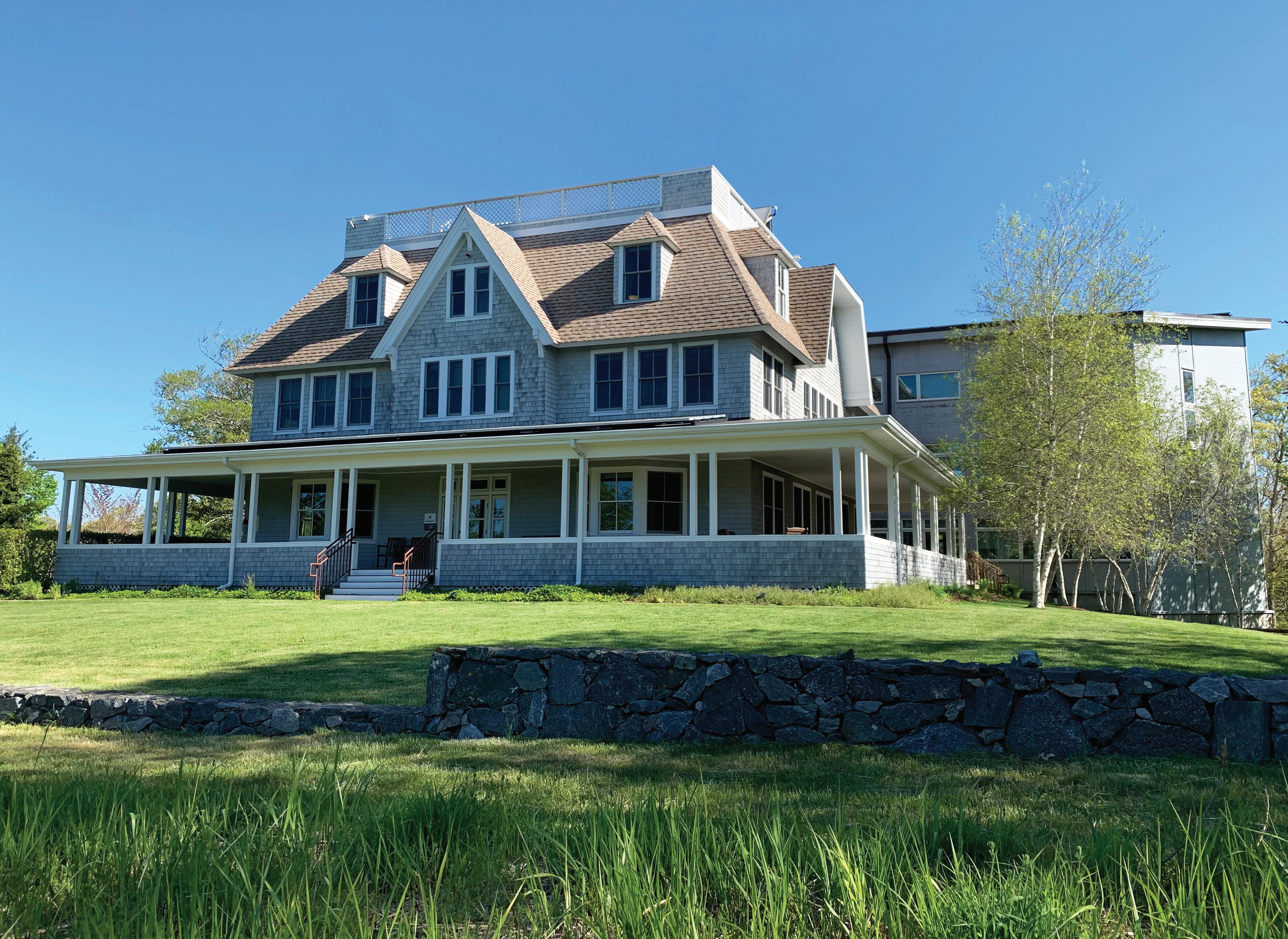 The Woodwell Building on Woodwell Climate’s campus. / photo by Julianne Waite
The Woodwell Building on Woodwell Climate’s campus. / photo by Julianne Waite
Climate Science for Change Fall 2022 24
Welcoming new Board members
Mr. Jerry Brown is Senior Vice President of Communications for the U.S. Dairy Export Council. He has more than 20 years of public affairs, public relations, and international experience in the corporate, U.S. government, and association sectors.
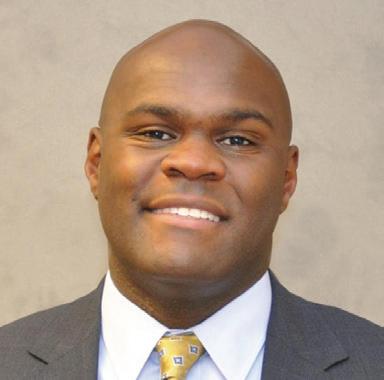

Areas of expertise include strategic communications, issues management, crisis communications, and environmental communications linked to sustainable development, climate change, and broader environmental issues. He has a deep commitment to strengthening climate action in the U.S. and worldwide.
Dr. Izabella M. Teixeira holds a Ph.D. in Energy Planning and was Brazil’s Minister of the Environment from 2010 to 2016. In 2015, Dr. Teixeira was Head of the Brazilian Delegation on negotiations of the Paris Agreement of the UN Convention on Climate Change. Today, she is Co-Chair of The International Resource Panel–IRP/UNEP-ONU, Board Member UN DESA, Senior Fellow of Institute Arapyaú, and Trustee for Environment and Climate Change of Brazilian Center for International Relations-CEBRI.
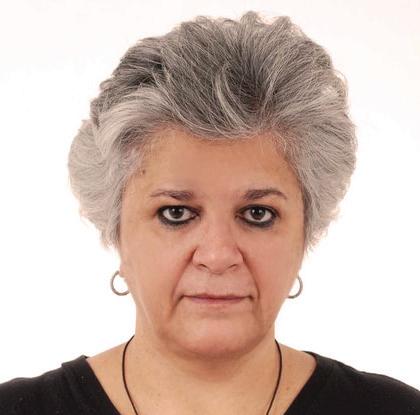
In Memoriam
Merloyd Ludington, the esteemed book publisher, ardent environmental activist, health care advocate, and animal rights crusader, passed away on June 27, 2022 at the age of 89. A longtime forest conservation advocate, Ms. Ludington served on the Board of Woodwell Climate from 2004 to 2019. She was elected Emeritus Director at that time and also was a member of the George Perkins Marsh Society that honors the Center’s legacy donors.
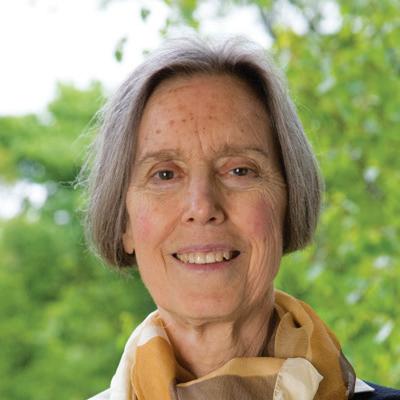
Ms. Ludington graduated from Radcliffe College where she also earned a master’s degree in comparative literature. In 1965, she co-founded Seymour Lawrence, Inc., an imprint publishing both fiction and nonfiction. In 1984, she created her own imprint, Merloyd Lawrence Books, producing hundreds of works of nonfiction over the next four decades.
Mr. Ihsan K. Speede is an attorney at Wellington Management where he leads the Investment Platform Legal Team, which has primary responsibility for legal, regulatory, and public policy matters related to the firm’s public investment activities. He has concurrently cochaired one of Wellington’s business networks and served on a number of internal committees. Before joining Wellington Management in 2010, Mr. Speede was a Senior Associate at WilmerHale and a member of the investment management and private equity practice groups.
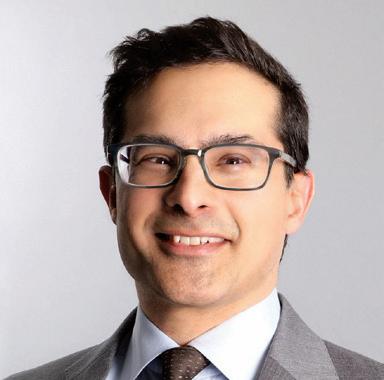
Mr. Sanjay J. Wagle is co-founder and Managing Director of The Lightsmith Group, a private equity firm investing in growth-stage technology companies that address critical societal needs, with a current focus on climate change adaptation and resilience. In the first three years of the Obama Administration, Mr. Wagle served as a senior official at the U.S. Department of Energy, overseeing the implementation of $15 billion of investments in clean energy under the American Recovery and Reinvestment Act.
Dr. Thomas E. Lovejoy, a worldrenowned ecologist who dedicated his career to conservation and the field of biodiversity, passed away December 25, 2021 at the age of 80. Dr. Lovejoy was elected to the Board of Woodwell Climate Research Center (then Woods Hole Research Center) in 1989 and served as Vice Chair from 2011 to 2018. He was Woodwell’s longest-serving director, marking nearly 32 years on the board.
Dr. Lovejoy introduced the term biological diversity to the scientific community in 1980. He served in highlevel advisory positions in the Reagan, Bush, and Clinton Administrations. He was considered one of the most important conservation biologists of his generation for his ability to meld field research with environmental and policy work. This ability to combine insights from the field with policy solutions will continue to inspire the Woodwell Climate community.
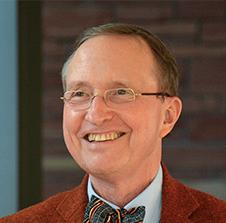
ANNUAL REPORT 25 Climate Science for Change Fall 2022
Board of Directors
CHAIR
C. Gail Greenwald
Cleantech Investor VICE
CHAIR
Thomas J. Hynes III
Senior Lecturer, MIT
TREASURER
Michael J. Fanger
Founder, Managing Member, and President, Eastern Funding, LLC
CLERK
Victoria H. Lowell
Community Leader, Conservationist
MEMBERS
Jerry Brown
Senior Vice President of Communications, U.S. Dairy Export Council
Christina DeConcini, Esq.
Director of Government Affairs, World Resources Institute
André L. Guimarães
Executive Director, IPAM Amazônia
R. Max Holmes
President and CEO Woodwell Climate Research Center
Joseph P. Kennedy III
Former U.S. Congressional Representative Roger A. Kranenburg
Vice President, Strategy and Policy, Eversource Energy
John L. Le Coq
Founder and CEO, Fishpond, Inc.
Robert B. Litterman
Founding Partner, Kepos Capital LP
Wilhelm M. Merck
Founder and Managing Member, Essex Timber Company
William R. Moomaw
Professor Emeritus and Founding Director of the Center for International Environment and Resource Policy, The Fletcher School, Tufts University
Joseph J. Mueller
Community Leader, Conservationist
Georgia Chafee Nassikas Artist, Conservationist
William C. Pisano
Vice President Emeritus, Stantec
Glenn T. Prickett
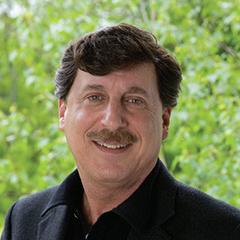
President and CEO, World Environment Center
Kilaparti Ramakrishna
Chair, Nippon Foundation-GEBCO Seabed 2030 Strategic Advisory Group
Daniel A. Reifsnyder
Adjunct Professor, Batten School of Leadership and Public Policy, University of Virginia
Joseph R. Robinson
Private Investor, Co-Founder of MidMark Capital
Constance R. Roosevelt
Conservationist
Ihsan K. Speede
Managing Director and Counsel, Wellington Management
Izabella M. Teixeira
Former Environment Minister of Brazil
Stephanie N. Tomasky
Independent Film Producer, Director, Writer
Cyrus N. Wadia
Head of Sustainable Product, Amazon
Sanjay J. Wagle
Managing Director, The Lightsmith Group
Dr. C. Gail Greenwald, Woodwell’s New Board Chair
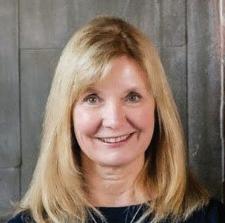
I am honored to serve as the new Chair of Woodwell Climate’s Board of Directors. This could not be a more exciting time to lead this uniquely impactful organization. I joined the Board in 2020 because of its combination of groundbreaking climate science research and advocacy for policy solutions in some of the most vulnerable locations around the globe. With the clock ticking on our collective ability to prevent the worst impacts of climate change, there has never been a more important moment for Woodwell to expand its science for solutions approach to the most challenging climate mitigation and adaptation issues. With a new strategic plan and a growing scientific and senior management team, I am confident that Woodwell is poised to dramatically scale up our ability to conduct science for solutions to address the climate crisis.
New Emeritus Directors
Dr. John P. Holdren served on the Woodwell board from 1994 to 2005. In 2005 he succeeded George Woodwell as Executive
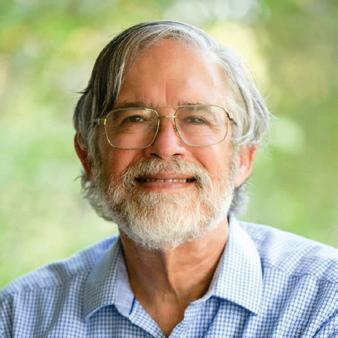
Director of the Center and served in that capacity until 2008 when he was named as President Obama’s Chief Science and Technology Advisor and the Senateconfirmed Director of the White House Office of Science and Technology Policy (OSTP). He went on to become the longest-serving Science Advisor to the President since World War II.
Mr. Joshua Goldberg served on the Woodwell Board from 2006 to 2020. He worked as a public defender for several years in courts in the Greater Boston metropolitan area, and then embarked on a 35-year career in corporate law, M&A investment banking, venture capital and private equity investing, developing a specialty in the Consumer sector. He has been active with several non-profits, including the Association to Preserve Cape Cod.
ANNUAL REPORT
Climate Science for Change Fall 2022 26
FOUNDER
George M. Woodwell
EMERITUS DIRECTORS
John H. Adams
Anita W. Brewer-Siljehølm
Neal A. Brown
John Cantlon
Stephen T. Curwood
Iris Fanger
Joshua Goldberg
Stuart Goode
David G. Hawkins
John P. Holdren
Joel Horn
Lily Rice Hsia
Lawrence S. Huntington
Karen C. Lambert
Mary Louise Montgomery Jeremy M. Oppenheim
Gilman Ordway
Amy H. Regan
Gordon W. Russell
Ross Sandler
Tedd Saunders James G. Speth
PRESIDENT’S COUNCIL
Warren Adams
Spencer Adler
Steven Berkenfeld
Stephen Bernier
Joanna and Stuart Brown
Jim Cabot
Alan Greenglass
N. Stuart Harris
Berl Hartman
Eloise Hodges
David Hoover
J.A. (Woody) Ives
Joy Jacobson
Shanti and Yale Jones
Christopher Kaneb
Amelia Koch
Kathy Kretman
Pamela Murphy
John Peteresen
Robert Peteresen
Ted Roosevelt V
Kate Schafer
Peter Stein
Eric Stoermer
Gen. Gordon Sullivan
Daniel Webb
Bonni Widdoes
Stash Wislocki
James Worth
Zaurie Zimmerman
StaffPRESIDENT AND CEO
Robert Max Holmes, Ph.D.
PAST PRESIDENT
On leave with the White House Office of Science andTechnologyPolicy Philip B. Duffy, Ph.D.
ACTING DEPUTY DIRECTOR Jennifer Francis, Ph.D.
SENIOR ADVISOR TO THE PRESIDENT John P. Holdren, Ph.D.
CHIEF COMMUNICATIONS OFFICER Heather M. H. Goldstone, Ph.D.
CHIEF DEVELOPMENT OFFICER Leslie Kolterman, M.A.T.
CHIEF OF EXTERNAL AFFAIRS David McGlinchey, J.D.
CHIEF FINANCIAL OFFICER Barry Leonard, B.S.
CHIEF OPERATING OFFICER Corrie Martin, M.P.A.
CHIEF PEOPLE & CULTURE OFFICER Lee Davis, B.A.
SCIENCE STAFF
Kyle Arndt, Ph.D. Alice Besterman, Ph.D. Richard Birdsey, Ph.D. Valeria Briones, M.S. Arden Burrell, Ph.D. Glenn K. Bush, Ph.D. David Byrne, Ph.D. Monica Caparas, B.S. Andréa D. Castanho, Ph.D. Michael T. Coe, Ph.D. Allie Cunningham, B.S. Jackie Dean, M.S. Linda A. Deegan, Ph.D. Zoe Dietrich, M.A. Carlos Dobler-Morales, Ph.D. Dominick Dusseau, M.A. Patrick Farrar, B.A. Gregory J. Fiske, M.S. Peter Frumhoff, Ph.D. Anna Gagné-Landmann, B.S.
Giselle Jimenez
Kelly Gassert, M.S. Darcy Glenn, M.S. Nigel Golden, Ph.D. Seth Gorelik, M.S. Haydee Hernandez-Yañez, M.S. Julia Holtzer, M.S.
Jake Huff, M.S. Jacqueline Hung, Ph.D. Elchin Jafarov, Ph.D. Matthew Jacques, B.Sc. Aiza Kabeer, M.S. Mitch Korolev, B.S., B.A. Anna Liljedahl, Ph.D. Abigail Lute, Ph.D. Marcia N. Macedo, Ph.D. Manoela Machado, Ph.D. Christina Minions, M.S. Joe Mangiafico, B.A. Marco Montemayor, B.Sc. Andrew Mullen, B.S. Patrick Murphy, M.S. Alexandra Naegele, Ph.D. Susan M. Natali, Ph.D. Christopher Neill, Ph.D. Jonas Noomah, B.A. Andrea Norton, M.S. Carmen Petras Stefano Potter, M.S. Joshue Rady, Ph.D. Ludmila Rattis, Ph.D. Heidi Rodenhizer, Ph.D. Taniya RoyChowdhury, Ph.D. Brendan M. Rogers, Ph.D. José Lucas Safanelli, Ph.D. Jonathan Sanderman, Ph.D. Kathleen Savage, M.Sc. Christina Schaedel, Ph.D. Christopher R. Schwalm, Ph.D. Melissa Shapiro, J.D. Christina Shintani, M.S. Colleen Smith, B.S. Trevor Smith, B.S. Robert Stenson, M.S. Emily Sturdivant, M.Sc. Hillary L. Sullivan, M.S. Anya Suslova, M.Sc. Anna Talucci, Ph.D. Rachael Treharne, Ph.D. Anna Virkkala, Ph.D. Wayne S. Walker, Ph.D. Jennifer D. Watts, Ph.D. Tiffany Windholz, B.S. Brooke Woods, A.A. Yushu Xia, Ph.D. Yili Yang, Ph.D. Joseph Zambo Zachary Zobel, Ph.D. Scott Zolkos, Ph.D.
EMERITUS SCIENCE STAFF
I. Foster Brown, Ph.D. Richard A. Houghton, Ph.D. Thomas A. Stone, M.A.
ADMINISTRATIVE STAFF
Elizabeth H. Bagley, B.A. Natalie Baillargeon, B.A. Tracy Barquinero, M.S. Paula C. Beckerle, B.A. Kelly Benway, B.B.A. Chris Boudreaux, M.S. Beth Brazil, M.A. Nancy Bridges, B.A. Florence Carlowicz, B.A. Amy Chadburn, B.A. Nichole Chapman, B.A. Max Danowitz, B.S. Hilary Davis, B.A. John Driscoll, M.S. Mark Haycock, B.S. Jessica Howard, M.S. Wendy Kingerlee, B.S. Rinzing Lama, B.S. Margaret Lin, M.P.S. Erin MacDonald, M.Sc. Sarah Moore, B.S. Fred Palmer
Karen Patterson Greene, M.A. Amanda E.W. Poston, B.A. Melissa Poueymirou, B.A. Hannah Ritter, B.S.B.A. Sarah Ruiz, B.A. Shana Singleton, M.S. Emily Sullivan, B.B.A. Julianne Waite, B.A. Grace Wang, M.B.A.
27 Climate Science for Change Fall 2022
Statement of activities 2021/2022
SUPPORT AND REVENUE EXPENSES
Foundations and Individuals (86.6%)
US Government (5.9%)
Contract Revenue (10%)
Other (-2.5%)
Research Programs (72%)
Development & Fundraising (8.8%) General & Administrative (19.2%)
WITHOUT DONOR RESTRICTIONS WITH DONOR RESTRICTIONS TEMPORARY PERPETUAL 2022 2021
SUPPORT AND REVENUE
Contributions, grants, and contracts U.S. Government Foundations and other PPP loan forgiveness



Contract revenue Investment income (loss)
Donated equipment Change in value of split-interest agreements
Other income
Net assets released from restrictions
Total support and revenue
EXPENSES
Research programs
General and administrative Development and fundraising
Total expenses
CHANGE IN NET ASSETS
NET ASSETS
Beginning of year
End of year
$7,405,5494,525,132 (446,697) 77,235 (2,962) 28,659 9,361,986 20,948,902 12,672,740 3,385,532 1,553,032 17,611,304 3,337,598 11,478,617 $ 14,816,215
$ 2,692,467 31,884,670(771,340)-(9,361,986) 24,443,811-24,443,811 16,740,213 $ 41,184,024
$110,200---110,200-110,200 3,779,479 $ 3,889,679
$ 2,692,467 39,400,4194,525,132 (1,218,037) 77,235 (2,962) 28,65945,502,913 12,672,740 3,385,532 1,553,032 17,611,304 27,891,609 31,998,309 $ 59,889,9189
$ 2,432,362 13,315,843 1,206,926 1,705,543 1,970,689 145,869 (5,063) 12,82420,784,993 8,087,254 2,942,121 1,033,057 12,062,432 8,722,561 23,275,748 $ 31,998,309
ANNUAL REPORT Climate Science for Change Fall 2022 28
Statement of financial position 2021/2022
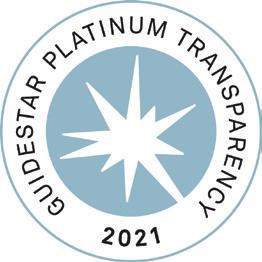
Fiscal year 2022 highlights
FY2022 represented another year of significant growth for Woodwell Climate Research Center.
Development had a successful year. The Fund for Climate Solutions (FSC), a multiyear campaign, achieved its goal of $10M.
Funding through the TED Audacious Project launched Permafrost Pathways in April 2022 which positioned the Center for continued growth.
The Center’s financial position is solid. We reported a $3.3 million surplus. Total net assets increased by $27.9 million in FY22 to $58.9 million. Unrestricted revenue and support increased from $13.7M in FY21 to $20.9M in FY22.
As we enter FY2023, the Center will continue to see growth and is making the appropriate investments in staffing and resources to support this growth.
Full financial statements are available at: woodwellclimate.org/financials
Barry Leonard Chief Financial Officer
ASSETS
Current Assets
Cash and cash equivalents
U.S. Government contributions receivable Other contributions, grants, and contracts receivable Prepaid expenses and other receivables
Total current assets
Investments
Endowment and quasi-endowment investments
Other investments
Total investments
Net property and equipment
Other assets
Other contributions receivable, net of current portion Beneficial interest in real estate trust assets Bond proceeds held in trust for debt retirement
Total other assets
Total assets
LIABILITIES AND NET ASSETS
Current liabilities
Accounts payable
Accrued expenses
Refundable advances Deferred contract revenue Liability under charitable gift annuities Loans payable
Total current liabilities
Long-term liabilities Liability under charitable gift annuities, net of current portion Loans payable, net of current portion
Total liabilities
Net assets
Without donor restrictions Operating Board designated for endowment Board designated for Fund for Climate Solutions Net investment in property and equipment
Total net assets without donor restrictions
With donor restrictions

Temporary restrictions Perpetual restrictions
Total net assets with donor restrictions
Total net assets
Total liabilities and net assets
2022
$ 31,965,737 856,219 7,648,331 320,642 40,790,929 8,277,290 845,269 9,122,559 4,685,284 8,300,266 212,651 10,803 8,523,720 $ 63,122,492
2021 $ 12,815,090 509,507 3,776,653 289,513 17,390,763 8,702,468 1,652,021 10,354,489 4,794,283 2,256,617 212,651 11,680 2,480,948 $ 35,020,483
$ 681,804 959,815 14,869 417,185 9,294 114,192 2,197,159 86,958 948,457 3,232,574 7,227,554 2,455,223 1,500,000 3,633,438 14,816,215 41,184,024 3,889,679 45,073,703 59,889,918 $ 63,122,492
$ 434,329 648,799 2,662 681,663 9,183 114,192 1,890,828 95,256 1,036,090 3,022,174 5,103,675 2,219,261 500,000 3,655,681 11,478,617 16,740,213 3,779,479 20,519,692 31,998,309 $ 35,020,483
29 Climate Science for Change Fall 2022
Donors
We are deeply grateful to the individuals, foundations and companies listed on the following pages who supported Woodwell Climate Research Center with gifts, new pledges, and pledge payments during the Center’s fiscal year July 1, 2021 to June 30, 2022. We are committed to accurately listing every gift. If we have made an error, or if you have a question about your gift listing, please contact Paula Beckerle at pbeckerle@woodwellclimate.org or 508-444-1521.
$5,000,000+
Anonymous (1)
Ballmer Group MacKenzie Scott Quadrature Climate Foundation Valhalla Foundation
$1,000,000–$4,999,999
Anonymous (4)
Foundation for the Carolinas
Chris Larsen Fund, an advised fund of Silicon Valley Community Foundation
Donald A. Pels Charitable Trust
Kristie Miller
Sea Grape Foundation
Seadream Family Foundation Inc. Fred and Alice Stanback
$500,000–$999,999
Anonymous (1)
J. Atwood and Elizabeth Ives
Ives Family Charitable Trust
Barbara Lavoy*
Gordon and Betty Moore Foundation
Ruth McCormick Tankersley Charitable Trust
$250,000–$499,999
Jean Lootz* Amy and James Regan
$100,000–$249,999
Anonymous (3)
Barbara Bowman
Stuart and Joanna Brown
Charles R. O’Malley Charitable Lead Trust
Environmental Defense Fund Cody and Kristine Friesen Dan and Bunny Gabel
Avram* and Carol Goldberg
Deborah Goldberg
Joshua Goldberg
Harbourton Foundation
Jerry and Margaretta Hausman
Heising Simons Foundation
Christopher and Lisa Kaneb
Eric Laufer and Giovanna Randall
John Myers and Merloyd Ludington*
Andrew McCormack and Sacha Janke
Charles Stewart Mott Foundation
Gilman and Margaret Ordway
Robert Petersen
Joseph and Marité Robinson
$50,000–$99,999
Anonymous (3)
Ayco Charitable Foundation
Michael Corrigan
Laurie David
Michael and Dudley Del Balso
Gail and Roy Greenwald
The Hermann Foundation
Robert and Mary Litterman
Victoria Lowell
Wilhelm Merck and Nonie Brady
MF Bartol Charitable Giving Fund
Minerva Foundation
Constance and Ted Roosevelt
Amy Schumer and Chris Fischer
Robert Stenson and Kate Stenson-Lunt
$25,000–$49,999
Garrett Albright ARIA Foundation
Stephen Bernier and Constance Messmer
The Buchanan Family Foundation
John and Mollie Byrnes
Peter and Valerie Byrnes
The Caldwell Foundation Cogan Family Foundation
Jonathan and Louise Davis
Robert and Iris Fanger
Michael Fanger and Linda Sattel
Peter and Sara Fleiss
Susan Gray
Greenwald Family Foundation
Art and Eloise Hodges
Yale and Shanti Jones
Shalin Liu
David Lovins and Elly Huber
Martha’s Vineyard Community Foundation, Inc.
Gary and Karen Martin
William and Margot Moomaw
Joseph and Eileen Mueller
Georgia and John Nassikas
Scion
W.L. Lyons Brown, Jr. Charitable Foundation
Gifts may be made online at woodwellclimate.org/give, by mail, by phone with your credit card, by stock transfer, or by wire or ACH. Please contact Paula Beckerle at pbeckerle@woodwellclimate.org for stock or wire transfer details.
$10,000–$24,999
Anonymous (1) Acadia Management
Arthur Vining Davis Foundation
Peter and Fay Bisson
Jonathan and Jennifer Blum
Anita Brewer-Siljehølm
Chris Cheever
Climate and Land Use Alliance
Williams Cosby
Nina de Clercq
Essex County Community Foundation
Diane and Scott Falconer Hart and Nancy Fessenden
Jesse and Elizabeth Fink
Peter and Jennifer Francis Paul Glendon
Stuart Goode and Nancy Cooley
The Grantham Foundation for the Protection of the Environment
Alan and Fran Greenglass
Serena Hatch Lily Rice Hsia
Tod and Beth Hynes Timothy and Joan Ingraham Island Foundation, Inc.
Ivor Cornman and Margaret E. Cornman Fund
Christopher and Katherine Linneman Monique Liuzzi
Mark Ludwig and Marjorie Pitz William and Sue Morrill Byrne and Pamela Murphy William and Rosemary Pisano Southwestern Water Conservation District
Joanna Sturm James Worth
$5,000–$9,999
Anonymous (3)
Matthew and Brooke Barzun Beattie Foundation
George Billings*
Brown Family Foundation
Karen Cove
Gordon and Wendy Cromwell Christopher Davis and Janet McMahon
John DeVillars and Gunnel Clarke David and Nina Fialkow
Michael and Darlinda Fleitz David and Betsy Fryberger
Greater Washington Community Foundation
Thomas and Virginia Gregg Matthew and Jessica Harris Robert and Diane Hildreth
Lawrence and Caroline Huntington
The J.M. Kaplan Fund
Joseph and Lauren Kennedy
Robert King and Annie Faulkner
Amelia Koch and Peter Meyer
Philip and Catherine Korsant
Kathy Kretman
John and Carolyn Lackey
Sam and Karen Lambert
David and Jan Leroux
William and Noelle Locke
Thomas May Mary McDonough
Casey and Megan McManemin
Joseph and Allison Mueller
Naduse Foundation
Susan Natali
Joan Person Rafe Pomerance
Leo Prone and Cynthia Moor
Renaissance Charitable Foundation Inc.
Richard and Nancy Robbins
Ted and Serena Roosevelt
Gordon Russell and Bettina McAdoo
Stanley and Barbara Schantz
Faye Steiner
Pierre Swick
Tree House Brewing Company
Frederica Valois
Zaurie Zimmerman and Craig Le Clair
$2,500–$4,999
Anonymous (2)
Artisan Partners
Don and Dee Aukamp
Awad Family Fund
Peter and Susan Bernard
Loren Blackford
Caithness Foundation, Inc.
Jay Cashman
CLC Kramer Foundation Inc.
Craig Davis
Geoffrey Freeman and Marjorie Findlay
Brent and Serena Hall
John and Molly Hooper
Brad and Andrea Hubbard-Nelson
Raymond and Lola Johnson
Christopher and Susan Klem
Carl and Joanne Leaman
David and Dana Lee
Losum Fund
Cynthia Mackay
Marcia Miller
Mary Louise and Charles Montgomery
Frank O’Sullivan
Robert and Pamela Pelletreau Linda Polishuk
GIVE ANNUAL REPORT Climate Science for Change Fall 2022 30
Harriet Rogers
Tedd and Ella Saunders
Thomas and Heidi Sikina
Summer Star Foundation Daniel and Mary Webb
Douglas and Barbara Williamson
$1,000–$2,499
Anonymous (3)
Joel Adams
Carla Alani
Ameriprise
Jim Antal and Cindy Shannon
Sabine Daley Deaton
Christina DeConcini and James Sweeney
Robert and Sylvia Dickinson
Leonard and Annmarie DiLorenzo
Robert and Evelyn Doran Joan Ducharme
Philip Duffy and Lauren Lempert Duffy
Tom and Janet Duncan
Roger and Linda Easley
Paul Elias and Marie Lossky Susan Epes
Robert and Marion Howard
Indigo AG
David Isenberg and Paula Blumenthal
Benjamin Ives and Sarah Morrison
Rick Gill and Betsy Jewett
Jewish Community Federation Frank and Judith Kauffman
Pamela Koch
Leslie and John Kolterman
Marta Jo Lawrence
Stephen and Sigi Lindo Stephen Lyle John Lynch
Marcelo Macedo Laurence and Katherine Madin
Marion Mann
John and Rebecca Markley Brian and Anne Mazar David McColl
Kevin McCroary
Clifford and Rebecca McCue
David Brown and Nawrie Meigs Brown
Garrett and Mary Moran
Stephanie Morgan
Christopher Neill and Linda Deegan
Abigail Norman
Susan Wall Oleyer
Elizabeth Bunnen Pack and Cam Pack
Pamela Steel White Foundation
Thomas and Jill Pappas
David Peet
Christopher Poirier Glenn and Lisa Prickett
Daniel Reifsnyder and Kathryn Clay Mark Reis
Jackson Robinson Louis and Val Rossman Glenn and Susan Rothman Charlie Ruch SAE International Ron Schafer
Robert Shatten and Jessica Langsam
Samuel Sherraden
Bonnie Simon
Gentry Baker
Michael and Margherita Baldwin
Kelly Barlow
George Basch
Mary Bertino
Beachcomber Fund
John and Nancy Braitmayer
Lynn Brennan Sierra Bright
Michael Buonaiuto and Sandra Goldstein
Carl Forstmann Memorial Foundation
CARS
Charitocracy Corporation
Chillaksian Inc.
Mischa Chillak Jim Clemans
Molly Cornell
Tammy Dayton
Adam Deaton and
Barbara Eskin
Robert and Joanne Fallon
Delia Flynn
Roger and Laurie Freeman Philip and Marcia Giudice
Christopher Goolgasian
Scott Grainger
Marcia Greenblatt
Andrew Hall
Lawrence Pratt and Melinda Hall
Peter and Karen Hargraves
Jonathan Harris
Lynn Harrison and Barbara Hazard
Berl and Hyman Hartman
Whitney and Elizabeth Hatch
George and Marina Hatch
Jill Hawley
Ronald and Colleen Hertel
R. Max and Gabrielle Holmes
David Hoover and Carol Swenson
Richard and Susan Houghton
Lionel and Vivian Spiro Peter Stein and Lisa Cashdan Stony Point Foundation
Gordon R. Sullivan
Catherine Symchych
Kathryn Taylor
Stephanie Tomasky and Mitchell Cohen
Margaret Evans Tuten Foundation
Sanjay Wagle
Matthew Watson and Ellen Cabot
Scott Wayne
Nina Webber
James and Theresa Whitmore
Ned and Patricia Wright
Alan Yanny Timm and Cate Zolkos
$500–$999
Anonymous (3)
Amy Abrams
AmazonSmile Robert and Alison Ament
Drew Trott and Jennifer Avian
Jim and Pam Barquinero
Charles and Christina Bascom
John Boyle
John and Elaine Brouillard
Jacob and Barbara Brown
Alexander and Sarah Buck
Jonathan Chatinover and Elizabeth O’Connor
Brian Church
Richard Cowett
Mark and Jackie Curley
Murray and Judith Danforth Sanders and Ann Davies
Bruce and Lee Davis
Frank Dunau and Amy Davis
Thomas and Diane Esselman
Expedia
Susan Fisher
Harvey Fishman
Paul Ford
Ken Foreman and Anne Giblin Mark Fresolone
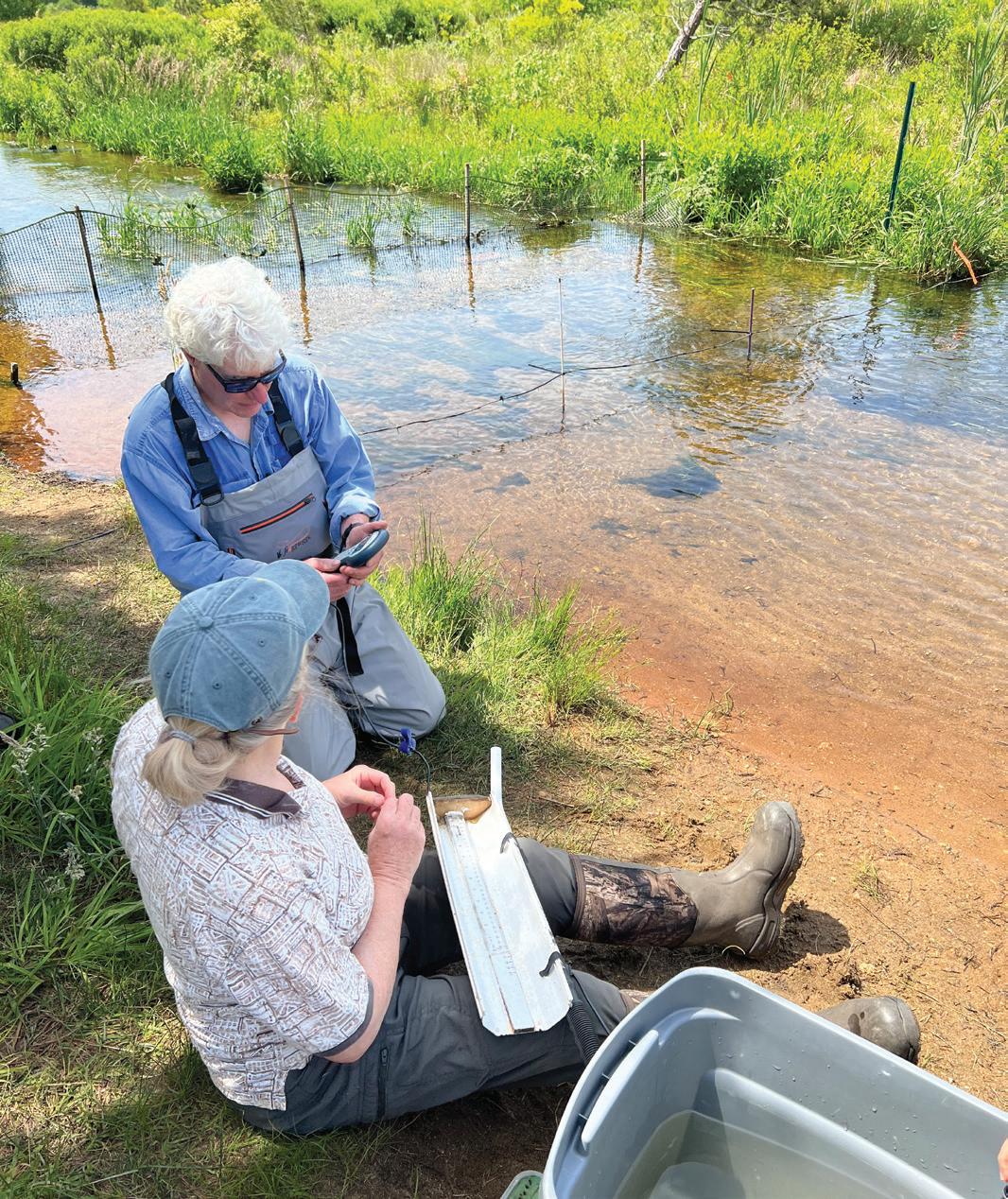
F. Thomas Fudala
John and Tally Garfield Margaret Gifford
Tobias Goldstone
David Greco
Sally Haas
Jane Hallowell Charles and Ethel Hamann Albert and April Hamel
David and Betsy Hawkins John and Olivann Hobbie Betsey Holtzmann
Richard Hough
William and Holly James Barbara Woll Jones*
Patrick Kent
The Night Walk Fund
Peter Leyton
Wesley Lipchak
Paul Litwin
Phillip and Whitney Long Joanna Lowell
Kai and Marion Marcucelli John Mashey and Angela Hey
Jim Mathewson
Gilbert McCurdy
Ruth C. Mead
Sally Merrill
Thomas Mikus and Diane Cartwright
Leah Miller
Dana and Eileen Miskell
Annie Morris
Susan Morse
Nitorum Capital, L.P. Elizabeth & Frank Odell Family Fund of the Community Foundation of Collier County
Bonnie Perkins
Elizabeth Rocha Pimenta
Sheila Place
Robert and Sally Prendergast George and Kathy Putnam
Kilaparti and Anjali Ramakrishna
Licia Rando
Richard Raushenbush and Barbara Giuffre
Charles and Jennifer Rose
31 Climate Science for Change Fall 2022
Drs. Chris Neill and Linda Deegan preparing to tag and measure fish from the Coonamessett River in Falmouth, MA. / photo by Nichole Chapman
We are deeply grateful for the generosity of those who have contributed to the Campaign for the Fund for Climate Solutions since the campaign’s launch in 2018. Your leadership has enabled us to raise $10 million and has funded 42 research grants to date.
$1,000,000+
Harbourton Foundation
Kristie Miller
Ruth McCormick Tankersley Trust
$500,000–$999,999
J. Atwood and Elizabeth Ives
Ives Family Charitable Trust Christopher and Lisa Kaneb
Wilhelm Merck and Nonie Brady Quadrature Climate Foundation Joseph and Marité Robinson
$100,000–$499,999
Anonymous (1)
Robert and Iris Fanger
Michael Fanger and Linda Sattel Avram* and Carol Goldberg
Deborah Goldberg
Joshua Goldberg
Jerry and Margaretta Hausman Shalin Liu
Victoria Lowell Robert and Veronica* Petersen Constance and Ted Roosevelt Douglas and Barbara Williamson
$50,000–$99,999
Stephen Bernier and Constance Messmer John and Mollie Byrnes Stuart Goode and Nancy Cooley Susan Gray William and Margot Moomaw Joseph and Eileen Mueller Georgia and John Nassikas
$25,000–$49,999
Peter and Fay Bisson
Joshua Byrnes
Peter and Valerie Byrnes
Cogan Family Foundation
Michael and Dudley Del Balso Philip Duffy and Lauren Lempert Duffy Gail and Roy Greenwald
SUPPORT
Yale and Shanti Jones
Jeremy Oppenheim William and Rosemary Pisano
$10,000–$24,999
Anonymous (1) Scott and Diane Falconer Tod and Beth Hynes Sam and Karen Lambert
$5,000–$9,999
Boston Financial Management Brookline Bank
John DeVillars and Gunnel Clarke Alan and Fran Greenglass
Thomas Lovejoy* Thomas May Tedd and Ella Saunders George and Katharine Woodwell
$1,000–$4,999
Anonymous (2) Jay Cashman
Roger and Laurie Freeman Lily Rice Hsia Kathy Kretman
John Le Coq David McColl
John Myers and Merloyd Ludington* Frank O’Sullivan
Christopher Poirier
Bob Reid
Stephanie Tomasky and Mitchell Cohen Richard Wilson
$100–$999
Anonymous (3)
John and Patricia Adams Steve Curwood and Jennifer Stevens Curwood David and Betsy Hawkins Robert Cimetta
Brian Degnan Stephane Quintal
To learn more about how to support the Fund for Climate Solutions, contact Leslie Kolterman, Woodwell’s Chief Philanthropic Officer, at lkolterman@woodwellclimate.org.
Robert and Felicia Rubin
Rebecca Russell
Richard Sailor and Mary Johnston
William and Rebecca Sawyer
Jennifer Schloming
Clair Scribner
Jack and Kathy Simonds
P.K. Simonds and Beth Colt
Jeffrey Soulen
Pamela Steiner
Campbell Steward
Chad Thomas Noah and Janet Totten
Christine Weisiger
Wichita Falls Area Community Foundation – John Hirschi Donor Advised Eric Wolman
Leigh Wood Peter Zika and Elizabeth Gould
$250–$499
Anonymous (3)
John Abrams
All Trust Credit Union Tom and Kim Athan
George and Beth Bagley John and Priscilla Becker
Nancy Benchoff
The Benjamin Family Kathleen Biggins John and Laurel Bobrowich John Boiney
Jean Paul Bourque
Frank and Mardi Bowles
Emily Bramhall
David and Jennifer Brower
Patrick Burke
Bradford Butman John and Theresa Cederholm
James Thomas Chirurg
Nathaniel Coolidge
Steve and Sukie Crandall
Elizabeth De Montigny
Margaret Edgerton
Benjamin Egan
Paul and Anne Ehrlich
Leslie Eldridge
Douglas Evans and Sarah Cogan
Emily Farmer
Thelma Fenster
Henry Fountain
Lee and Melissa Freitag
Craig Gaspard
Thomas and Elizabeth Gewecke
Give Lively Foundation
Robert Goldsborough and Salley Mavor
Frederic and Jocelyn Greenman
Huson Gregory
Christopher Haig
Robert and Heather Harrison
Rob Harvey
Alan and Judith Hoffman
John Holt and Elizabeth Whelan
Nick and Mary Hubbard
Stanley and Dee Jacobs
Drew Jannati
Leonard and Patricia Johnson
Robin Johnson
Virginia Johnson
Mary Kane
Dennis and Joanne Keith Fund
Melinda Kelly
Kenny Kirsch
Danielle Knight
Roger and Katherine Kranenburg
Howard and Carole Kuenzler
Geraldine Kunstadter
Patricia Lamoureux
Lawrence and Ginette Langer Henry and Mary Lee
Andy Lilienthal and Laura Blaisdell
Philip Lilienthal
Peter A. Tassia and Maija M. Lutz
Cameron and Susana Mackey
Marley Matlack
Robert Matthew
Rod Hinkle and Kirstin Moritz
Beatrice Nelson
Network for Good
Jill Neubauer
Ian Nisbet
John Noel
Lyn O’Doran
John and Karen O’Neil
Mrs. Diana Orenstein
Mrs. Susan Parker
Richard Payne and Deborah Siegal
Robert Prescott
Robert and Nora Radest
Elisabeth Raleigh Susan Rau
Robert and Betsy Kyle Reece
Susan Rice
Margaret E. Richardson
Alison Rieser
Stephen Rockwood
Dana and Alison Rodin
Christopher and Roddy Roosevelt Alice Rushforth
Ray Schmitt and Nancy Copley
Damien Scott and Tessa Nichols
Allan and Judith Sherman
Peter Sinclaire
Robert Skilton and Jo Ann Muramoto
Jonathan Smith and Rosella Campion
David and Lea Soifer
Chris and Liz Steel Jakob Sunde
A.C. Tolkoff
Stephen and Carol Ann Wagner
Ann and Brad Wallace
Susan Warner
Richard Wilson
Donald Wixon and Lori Lawrence Kent Wommack and Gro Flatebo
Robert and Blaikie Worth
Geofrey Wyatt
$100–$249
Anonymous (9)
Donald and Barbara Abt
Levi and Jeanne Adams
Catherine Allard
Lawrence Altman and Janet Barsy
Luean Anthony
Rich Armstrong and Ellie Prosser
John Atkins
Laurie Austin
David and Nancy Babin
Denise Backus
Paul and Annette Bakstran Gary and Karen Bankston
REPORT
ANNUAL
Climate Science for Change Fall 2022 32
Lynne Barbee
David and Laurie Barrett
Marilee Bass
Katherine Beach
Deborah Blanchet
John and Linda Bowers
T. Marshall Boyd
Bennett and Cynthia Brabson
David and Diana Brassard
Beth Brazil Hauck and Eric Hauck
Jerry and Celia Brown
Brooks Browne
Marc Bruneau
David Byrne and Rosemary Loring
Christopher Carlson and Jane Fisher Carlson
John and Rhona Carlton Foss
Elliott and Susan Carr
John and Helaine Carroll
Julia Child
Robert Cimetta
Andrew Cimino
Darlene Clark
Margaret Clark
Sigita Clark
Tucker Clark Climate Ride, Inc.
Jennifer Clock
Jeffrey and Heather Collins
Dean and Cindy Conway
Peter Conzett and Pam Gougen
Tom Craddock
Lindsay Crouse
Copenhaver Cumpston
Kathie Dalzell
Cynthia Dauphin
Gillian Davies
John Davis and Ann Price Michael and Rona Davis
Brian Degnan
Lawrence and Regina DelVecchio
Gregory Devine
Francis and Carol DeYoung Jonathan and Heather DiPaolo
James Diverio
Justin Dove
Toni Dove
Michael Dowling
Paul Dreyer
Donald and Anna Ducharme
Frank and Geraldine Duffy
Jon Durell
Benjamin Egan
David and Sue Egloff
Jan Elliott
Thyra Elliott
William Elsey
Joanne Epstein
Michael and Christine Ernst
David Fanger and Martin Wechsler
Lynne Farlow
Carolyn Fedigan
Gordon Fitzgerald Elizabeth Anne Foss
Margaret Foster
Bruce Fowle
Judith Fox
Frank and Mary Fritsch
Sara Fritz
Barbara Gaffron
Alfred Garber
Michael and MC Garfield
Lawrence Geuss and
Pamela Lenehan
Nancy Gibbons
Susan Gibbs
Marc and Carol Gordon Bobbie Grimstad
Jean Groth
Robert and Virginia Guaraldi
Timothy Hagan
Deb Haines
Ronald Halpern
Jeffrey Hamilton
Judith Handley
Joan Harding Stanley and Elaine Harlow
Mark Haycock
Kurt Hellfach*
Frances Henry
Michael Herz and Kate Josephs
Richard and Kristen Hill
Judith Holt Herbert Homes
Mary Horne
Alan Houghton and Sky Pape
David and Clara Hulburt
George Hunnewell
Sarah Hunnewell
Lynn Jackson
Elchin Jafarov
Michael and Rachel Jakuba
Donna and David* Jewett
Alice Johnson
Stegar and Astrid Johnson
Richard Kacik
Thomas Kehler
Stuart Kendall and BeeBee Horowitz
Kevin Kenlan Robin and Laurel Kent
Marianne Wiser
Sandra Kinet
Ronald and Marcy Klattenberg
Pamela, Amelia, Sandy, and Joy Koch
Paul Koulouris
Leslie Kramer
Russ Kulp
Calvin and Ilene Kunin Klara Kurowski
Marjorie Lange
Lawrence and Hannah Langsam Chip and Gayle Lawrence Ginger Lazarus
Dennis Lebwohl and Debra Michlewitz
Steven Lentz and Colleen Wood
Barry Leonard
Edwin and Judith Leonard H. David and Patricia Leslie Kathie Levison Jim and Alice Liljestrand
Tommy Linehan
Douglas and Kim Livolsi Allen Luke
San Lyman
Fred and Judith Mackenzie Daniel and Jane MacNeil David and Maryann Mahood
Janice Marks
Jeffrey and Kimberly Markuns
Michael Martin and Ann O’Kennedy Martin Stephen and Ann Martin Bill and Kristina Matsch
RECOMMEND
Marguerite Mauritz
Mary McCabe
Gretchen McClain
Frances McClennen
Jim McCotter
Alice McDowell
Andrea McGlinchey
Mr. and Mrs. Ed McKelvey
Carol McKeon
Samual McMurtrie and Elizabeth Molodovsky
J. Scott McNamara and Krista Hennessy
Maryellen Meleca and Christine Graziano
Fran Merker
Robin Milburn
Mary Jane Milner
Emily Mohl
Angela Hart Morris
Elizabeth Moulton Day and Kathie Mount Colleen Mullen
Gardner Neely
Tim Neiley
Marcy Woodwell Neilson
Ann Little Newbury
John and Kate Newhall
James Newman and Deborah Coulombe
Peter Newman Amy Nielsen
If you have a donor advised fund participating in DAF Direct, you can recommend grants to Woodwell Climate Research Center.
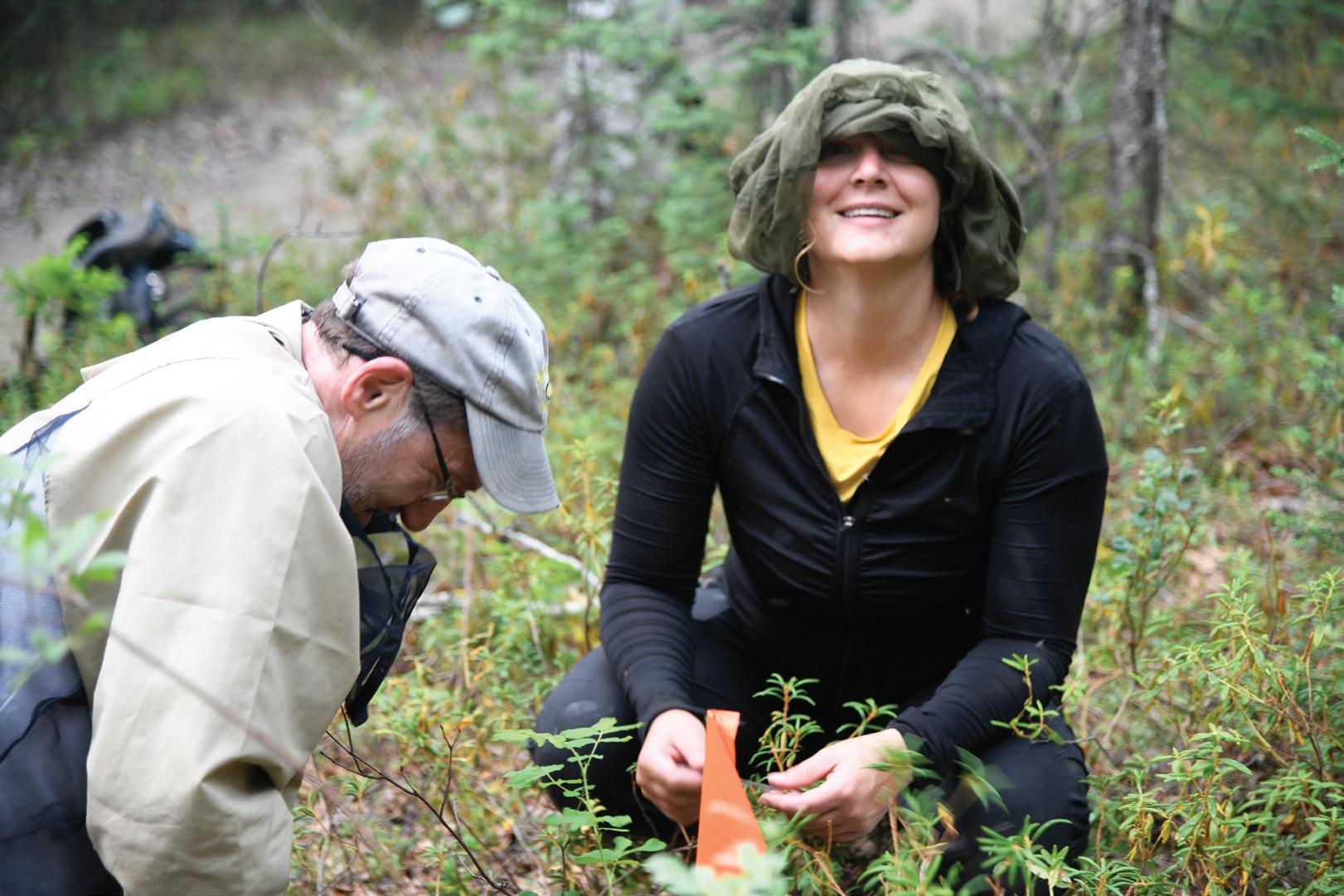
33 Climate Science for Change Fall 2022
Dr. Jennifer Watts is collaborating with Dr. Howard Epstein of University of Virginia, on a project near Caribou Creek in Alaska. / photo by Gabrielle Russomagno
Mark Obrinsky and Michelle Gehshan
Carol O’Neil
Melody Padget
Jill Park
Tyler Parkinson
Thoru and Judith Pederson
Julie Peller
Bernhard Peucker Ehrenbrink and Petra Ehrenbrink
Claudia Phillips
Thomas and Lys Pike
Harriet Potter
Harold Prezzano
David Prosten and Sarah Flynn
Rock Pulak and Alice Rushforth
Ann Quealy
Stephanie Quinn Davidson
Stephane Quintal
Robert Ralls and Sherrie Burson
Edward Rastetter
David Riihimaki
Robert Riordan
Michael and Marjorie Roache
Margaret Robbins
Katherine Roberts
Charlotte Robinson
Greg Robinson
Sydney Roberts Rockefeller
James and Dianne Roderick
Daniel Rodrigues
Martin Rojas
Camille Romano and Mark Kasprzyk
Bob and Gabriela Romanow
David and Edith Ross
Helen Ross
Hannah Rossman
Daniel and Verne Roy
Norman Rushforth
Michael Sales
Dave Sandstedt
Judy Savage
Kenneth Wharton and Katherine Schafer
Nick Seinfeld
Peter Sherin
Daniel and Joanne Shively
Mark and Tema Silk
Robert and Sharon Smith
Robert and Mary Smith
South Mountain Company Foundation
Gus and Cameron Speth
Jane Stallman
Tom Anderson and Jennifer Stamp
Wallace and Pamela Stark
John Stegeman
Edward and Ann Stern
Lewis Stern
Jeremy Steuer
Wesley and Patricia Stimpson
Thomas and Ann Stone
Jacek and Margaret Sulanowski
Apa Sunriver
Phil Thayer
Noah Thiemke
Fredrica Harris Thompsett
Dan and Meredith Tipton
Guy Tomasky
Mike Tong
Richard and Marney Toole
Marie Eve Tremblay
Gordon and Ellen Tully
Mrs. Lee Turner
UU Falmouth
Carolynn Van Dyke and Ann Carter
Al and Jackie Vnencak
Keith von der Heydt and Terry McKee
Cyrus Wadia and Heather McMahon Grant and Jean Walker Gary and Linda Walker
Marian Ware
Deborah Warner
Diana Weatherby
Nicholas and Katharine Weber
Stella Weil Lewis Weinfeld
Irwin Weisbrot
Robert and Marilyn Werner Daniel White
Peter and Betsy Wild
Jeff Williams and Rebecca Upton
Cyara and Marina Gresham
Benjamin and Ann Williamson
Woods Hole Women’s Club, Inc.
John Woodwell and Marie Hull Boyd Zapatka
Leon Zar Judith Zis
$1–$99
Anonymous (8)
Shelley Abrams
William Anderson Adriana Aquino Nina Aronoff
Paula Bacon
Joan Balfour Karel Baloun
John Banner
Nancy Barnett
Susan Baur
Benevity Community Impact Fund Howard and Deborah Bernstein
Carol Bitting
Fred and Linda Blaisdell
Allen Bohnert
Peter Bowman Gerard Brown
Thomas A. and M. Kathryn Brown
Braden Buehler Willy Burgess
Sue Butler
William and Helga Butler
Peter Carnevale and Joanne Blum Carnevale
Donald Cecich and Gail Fenske
Mary Chapman
Lynne Cherry
Naomi Church
Peter Clark and Ellen Barol
Thomas Clemow
Michele Coakley
Jonathan and Susanna Cobb Sarah Cocuzzo Ellen Coldren
Peter and Edna Collom Susanna Colloredo Mansfeld James and Sylvia Connor Steve Connors
Charles Cooper and Sarah Bysshe John and Barbara Cotnam Mike Courtney Allie Cunningham Chris Cunningham Elinor Dankner
Jill Davis Paul and Maria De Weer Ravi Deepak
Joseph and Grace Donahue Tom Dorney Britta Dornfeld
Michael Dryfoos
Juliana Dubovsky
Allan and Linda Dunn
Robert and Karin Edwards Marilyn Elie Alison Farrar
David Ferrill
Sharon Finzer
Charles and Maryanna Foskett
Dorothy Fulgoni
John Galick
Constance Galliart
Patricia Gamache
Karen George Michele Girard
Sammy Gjeltema
Kathleen Goforth Elaine Goldman
Jonathan and Nicole Goldman Daniel Gould
Rodney Grainger Linda Gudex
Lorraine Gyauch
Susan Haedrich
Ladd Hamrick
Thomas Hamrick
Evelyn Hanson
Christopher Hardee
James and Lorna Henderer
Daniel Henling
David and Joan Herschfeld
Peter Hiraldo
Thomas Hirasuna and Jean Hunter
Jean Hodgin
Wendy Holup
Catherine Hramiec
Eric Hutchins
Nada Hyman
Brendan Hynes
Michael Janovsky
Laurie Jay
D. Randolph Johnson
Steve and Joanne Johnson
Susan Johnson
Ross Jurek
Beverly Kamaitis
Lauren Kaminer
Joan Kammire
Larry Kane
Robert Keck
Fred and Whitney Keen Gail Kelly
Toni Kindel
Tom Kreyche and Liz Longsworth
Donna Kuroda Albert and Sonia Kutzin
Gary LaRue and Susan Barrett
Sally M. Lawton
Vicki LeFevre
Carolyn Leiby John LeShane
Daniel Levin
Frances Lightsom
Tessa Lineaweaver
Betty Long
Bruce and Lorraine Luchner
Peter Lynch
Gaurav Manchanda
Charles and Susanne Mann
Jonathan Marr and Rachel Sterne Marr
Aaron Masino
Joan and Joan Mastromonaco
Linda Matheson
Michael and Janet McClure
Victor and Ruth McElheny
Katherine McEvoy
Matthew McGuire
David and Barbara McPhelim Roger Mellem
Amy Merrill
Joseph Meyer
Susan Miller and Lee Kramer Rose Minior
Rodney and Suzanne Moll Allan and Maria Moniz
Kathleen Mortenson
Frederic Morton
Doug and Dorothy Munson
Allen Myers
Gregory Nelson
Harry Newell
Arnold and Arlene Newman
Sharon Newman
John and Maureen Nolan
Christine O’Neill
Don and Joanne Patterson
Joanna Perales
Maryanne Perlmutter
Michela Perrone
Luke Perry
Shannon Peters
Suzanne Phillips
Ann Pilch
Warren and Kathleen Pinches
Dierk Polzin
Barbara and Barbara Porter Joan Power Stevan Power
your old gas-guzzler into a climate change solution. Vehicle donations are tax deductible and provide tremendous benefit to
cars—you can donate trucks, boats, planes, motorcycles,
too, running or not.
GAS-GUZZLER? ANNUAL REPORT Climate Science for Change Fall 2022 34
Turn
Woodwell Climate. It’s more than
and RVs
Contact Paula Beckerle at pbeckerle@woodwellclimate.org to start the process.
Ronald R. Rauber
Sarah Richards and Barbara Leland
Richard Riggs
Mary Ring
Alison Robb*
Marc Rosenbaum and Jill De La Hunt
Catherine Rossi
Gray Russell
Sarita Sachs
Philip Sacks
R. Keith and Susan Salisbury
Philip Sanfilippo
Elizabeth Schaff
Daniel and Paula Schiller
Judith Schooley
Lois Schuyler
Carol Schwamb
Andrew Shaughnessy
Michael and Amy Shaw
Mark Shawnik
Lisa Sheble
James and Lesley Shepard
Benjamin Shepherd
Christy Sherr
Christine Silvius
Vivian Sinder Brown
Bennett Singer
Andrew Stangeland
Brandon Stewart
William Stocker
Deb and Mark Stone
Debra Stone
Michael Stone
Kristi Sullivan
Maureen Sullivan
Timothy Taylor
Anne Tessier
Michael Testa
Edward and Elizabeth Thorndike
Stephen Tom Timothy and Janet Trask
Brenda Troup
Leo Tugan Baranovsky
Ronald and Wendy Tumminello
UHG
Vanguard Joanne Voorhis
John and Jane Vose Mary J. Walsh
Kerry Walton
Dorothy Wass
Christine Waters and Susan Marlatt
Matt Watson
William and Judith Weil Karen Weiss
Larry Wentworth Andreas and Denise Wesserle
Allison Brewster White
Terry and Olivia White
Stu and Tilda White
Joan Wickersham
Amy Wild
Jacob Williams
Thomas and Patricia Willis
Dorothy Wilson James Wood Steve Wood
Dennis and Gloria Woodwell
Jane Woodwell and Christopher Soper
Danielle Wright Carolyn Wurm
Lucy Young
Dick Zajchowski and Celia Brown Michael Zimmermann
* Denotes deceased donor
The Polaris Program was able to return to the Yukon-Kuskokwim Delta for the first time since 2019. Here, Dr. Nigel Golden, once a Polaris student and now a Woodwell postdoctoral researcher, demonstrates a step in sample analysis. / photo by Greg Fiske
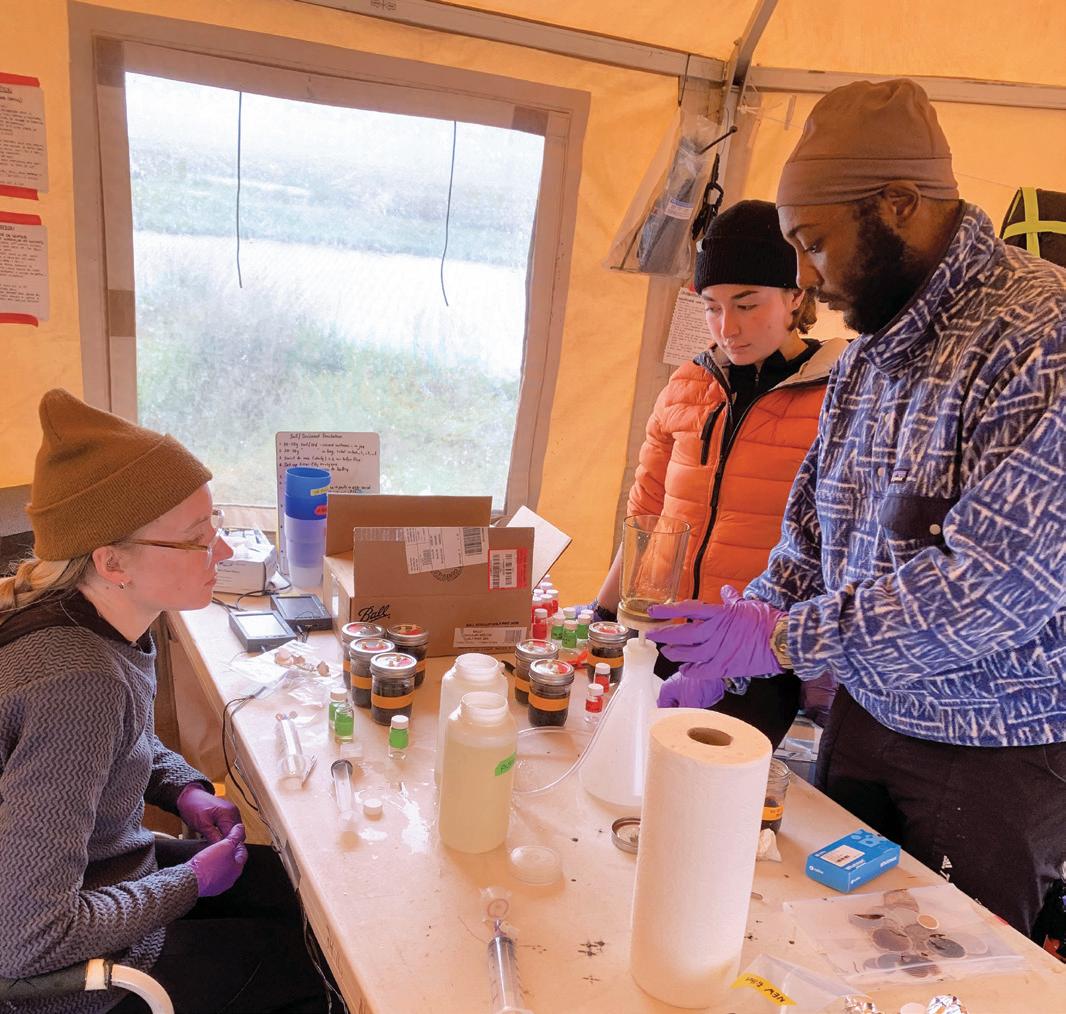
In-Kind Gifts
ESRI
Matching Gift Companies
ADP
Asahi Kasei Bioprocess America, Inc. Colgate Draper Expedia
FM Global GAF Energy GE Foundation Global Health Labs Google Jacobs
Jones Lang LaSalle Nike Okta Raytheon UHG Vanguard VMware Voya Financial
George Perkins Marsh Society
The Society recognizes forwardthinking friends who support the Center’s long-term success through a life income gift, annuity, life insurance policy, or bequest. The Society honors the legacy of George Perkins Marsh, a 19th century scholar, diplomat and naturalist known to many as America’s first environmentalist.
SOCIETY MEMBERS
Dolores Arond Stephen Bernier and Constance Messmer Sharon Bidwell
Stuart and Joanna Brown
Dale Bryan
Dennis Emory Robert and Iris Fanger
Thomas and Virginia Gregg Peter and Karen Hargraves N. Stuart Harris and Malinda Polk
David Hoover and Carol Swenson
Floyd Judd Frank and Judith Kauffman
Carl and Joanne Leaman
Victoria H. Lowell
Mary Lou and Charles Montgomery
Elizabeth Moore
Joan Person
William and Rosemary Pisano
David and Edith Ross
Jen Stamp and Tom Anderson
Genie Stevens
George and Katharine Woodwell
IN MEMORIAM
Barbara La Voy, Jean Lootz, and Merloyd Ludington
Gifts In Honor Of
Emily Babalas from Wendy Cromwell
Sergio Betancourt from Wendy Cromwell
Hannah Bouverat from Wendy Cromwell
Jim Bowers from Wendy Cromwell
Sam Brown from Wendy Cromwell
Irving Foster Brown from Dick Zajchowski and Celia Brown
Katie Burke from Robert Matthew George and Yara Cadwalader from Benjamin and Ann Williamson
Tom Callahan from Wendy Cromwell
Liz Chisholm from Wendy Cromwell
Julie Delongchamp from Wendy Cromwell
Lucy Dormandy from Wendy Cromwell
Sandhya Douglas from Wendy Cromwell
Cheryl Duckworth from Wendy Cromwell
Phil Duffy from James Diverio
Philip Duffy and Lauren Lempert Duffy from Jim Antal and Cindy Shannon
Diane Falconer from Tom and Kim Athan, and Amy Nielsen
Michael Fanger from Glenn and Susan Rothman, and Jonathan Smith and Rosella Campion
Hilary Flynn from Wendy Cromwell
Nicole Fortmann from Wendy Cromwell
Karsten Frey from Kathleen Mortenson
Christopher Goolgasian from Gordon and Wendy Cromwell
Audrey Gordon from Wendy Cromwell
Alan and Fran Greenglass –on their 50th Anniversary from Joanne Epstein
Abby Gurgol from Jill Davis
Astoria Hall from William Anderson
Tyler Hampton from Lynne Barbee
35 Climate Science for Change Fall 2022
Louise Henckel from Wendy Cromwell
John and Cheri Holdren from Kai and Marion Marcucelli R. Max Holmes from George Basch, James Diverio, and Kathy Kretman
Richard Houghton from Alan Houghton and Sky Pape, Amy and James Regan
Lily Rice Hsia from David Byrne and Rosemary Loring
Lawrence and Caroline Huntington from Susan H. Fisher
Marcia Imer from Wendy Cromwell
Meredith Joly from Wendy Cromwell
Yale and Shanti Jones from Karen Cove
Nora, Leo, and Stella Kretman from Kathy Kretman
Maddie LaRue from Gary LaRue and Susan Barrett
Kira Lawrence from Chip and Gayle Lawrence, Carolynn Van Dyke and Ann Carter Kira Lawrence from David Riihimaki
Marcus Leon and Pablo Sean Addy from SAE International
Rafe Lilienthal –in honor of his Bar Mitzvah from Katherine Beach, Fred and Linda Blaisdell, Braden Buehler, Juliana Dubovsky, Andy Lilienthal and Laura Blaisdell, Philip Lilienthal, Peter Newman, Sharon Newman, Rafe Pomerance, Deb and Mark Stone, Dan and Meredith Tipton, and Karen Weiss
Victoria Lowell from Tucker Clark, Elizabeth Anne Foss, and Charles and Ethel Hamann
Carolina Martin from Wendy Cromwell
Ed McKelvey –for completing the Climate Ride from Robert and Nora Radest
Bill Moomaw from David Brown and Nawrie Meigs Brown, and Williams Cosby
Adam Moore from Jonathan and Jennifer Blum Joe Mueller from Joseph and Allison Mueller Doug Munson from Joanna Perales
Erika Murphy from Wendy Cromwell
Christopher Neill and Linda Deegan from Barbara Woll Jones*
Oyin Oduya from Wendy Cromwell
Volkan Ozdurmus from Wendy Cromwell
Beth Piskorowski from Wendy Cromwell
Rafe Pomerance from Pamela Steiner
Pam Poole from Wendy Cromwell
Susan Pozer from Wendy Cromwell
Steven Proskauer and Lucia Gardner from Alan and Judith Hoffman
Amy and James Regan from Kathie Dalzell
Camille Romano from Peter Clark and Ellen Barol Constance and Ted Roosevelt from Lionel and Vivian Spiro
JoAnn Rossetti from Wendy Cromwell
Burton Shank and Alison Whelan from Donald Wixon and Lori Lawrence Annie Sherman from Wendy Cromwell
Melissa Siciliano from Wendy Cromwell
Roy Smale from Wendy Cromwell
Luke Stellini from Wendy Cromwell
Tom Stone from Debra Stone
Susan Unterberg from Alan Houghton and Sky Pape
John Valentino from Wendy Cromwell
Tessa Volkmer from Wendy Cromwell Camiel Vries from Wendy Cromwell Mary Walker from Grant and Jean Walker Wayne and Lisa Walker from Judith Holt Andria Weil from Wendy Cromwell David Weil from Stella Weil
Allison Brewster White from Susan Gibbs Peter and Betsy Wild from Amy Wild George Woodwell from Lily Rice Hsia George and Katharine Woodwell from Denise Backus, Copenhaver Cumpston, Abigail Norman Woodwell Climate Scientists and Staff from Georgia and John Nassikas Jenny Xie from Wendy Cromwell
Gifts in Memory Of George Billings
from Richard and Paula Tredeau
IRA?
Joseph C. Burke from John Davis and Ann Price
Susan Fishman from Harvey Fishman
Molly Geraghty from David and Betsy Fryberger
Garry and Nancy Hough from Richard Hough
Nicole Hynes from Marc Bruneau
Gary Jay from Laurie Jay David Jewett from Robert and Betsy Kyle Reece Chick Legue from Allan and Linda Dunn
Anthony Liuzzi from Monique Liuzzi
Thomas Lovejoy from Alison Rieser, Katherine Roberts, David and Betsy Hawkins, David Brown and Nawrie Meigs Brown
Pete Lowell from Elizabeth Anne Foss, Joanna Lowell
Walter Matherly from Copenhaver Cumpston
Robert McCurdy from Gilbert McCurdy
Shirley Nisbet from Ian Nisbet
Susan Parker from Jeffrey Parker
Veronica Petersen from Laurie Austin, Nancy Benchoff, Steve and Joanne Johnson, Elizabeth De Montigny
“Charlie” Clay Reifsnyder from Daniel Reifsnyder and Kathryn Clay
Jonathan Rice from Susan Rice
Stephen Schneider from John Mashey and Angela Hey B. Thomas from F. Thomas Fudala
John Turchon from James and Sylvia Connor
Lucille Wilson from Stephanie Morgan
Lois Woodwell from Marcy Woodwell Neilson
Are you 70 1/2 years of age or older with a traditional IRA? If so, you are eligible to make a tax-free donation directly to Woodwell Climate Research Center from your IRA—up to $100,000. To learn more, contact Leslie Kolterman at lkolterman@woodwellclimate.org, visit woodwellclimate.org, or consult your plan administrator.

ANNUAL REPORT Climate Science for Change Fall 2022 36
Research at Tanguro Ranch in Mato Grasso, Brazil geared back up this year, in collaboration with Amazon Environmental Research Institute (IPAM). / photo courtesy of Marcia Macedo
Everyone
Will
help secure a sustainable future for humanity? You can do it today—by including a legacy gift to Woodwell Climate in your estate plans. A legacy gift:
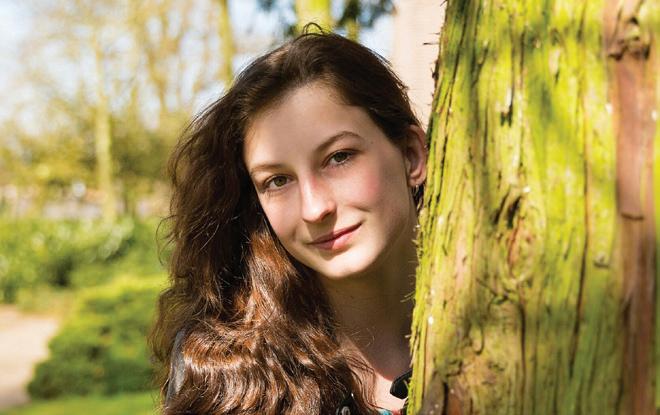
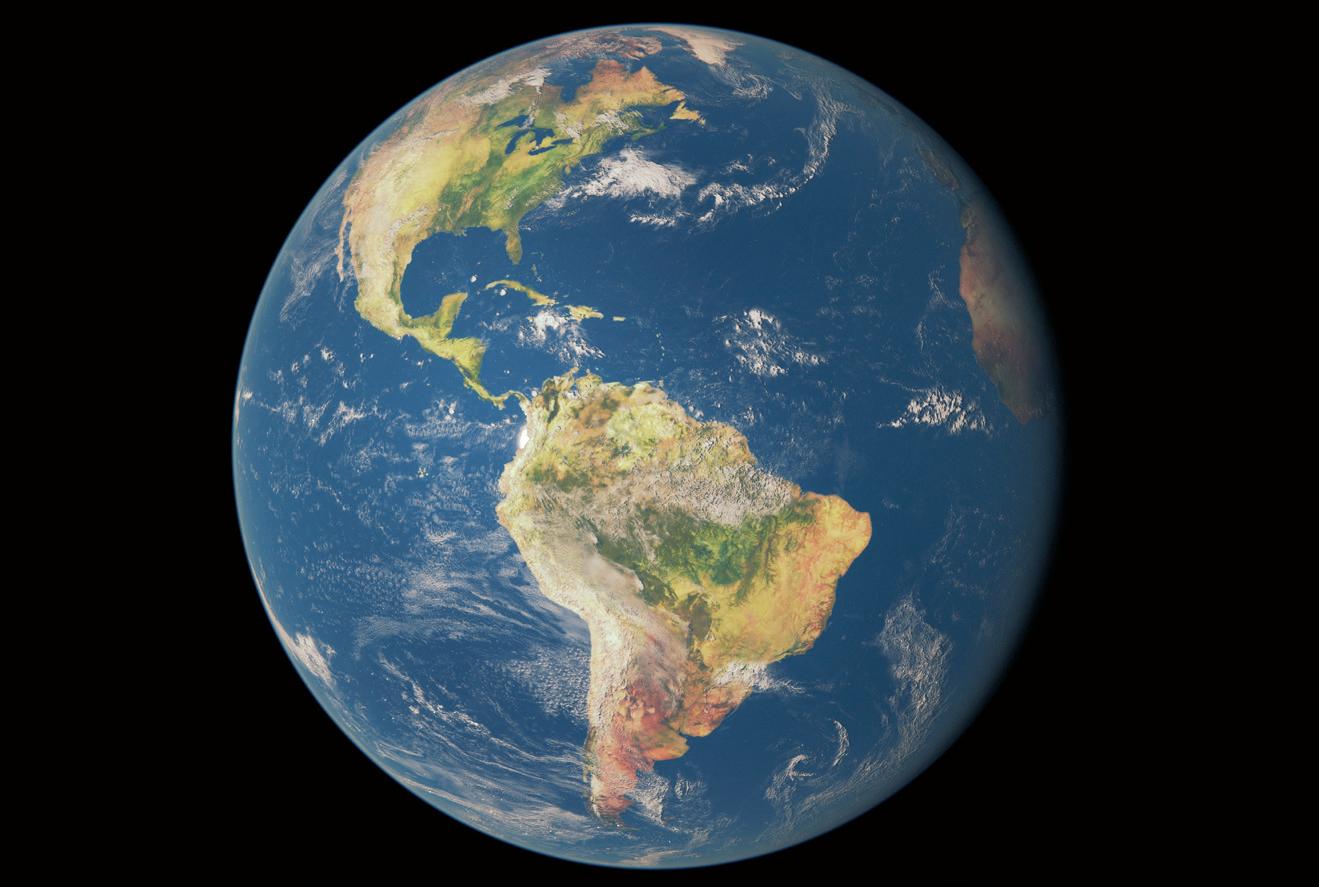
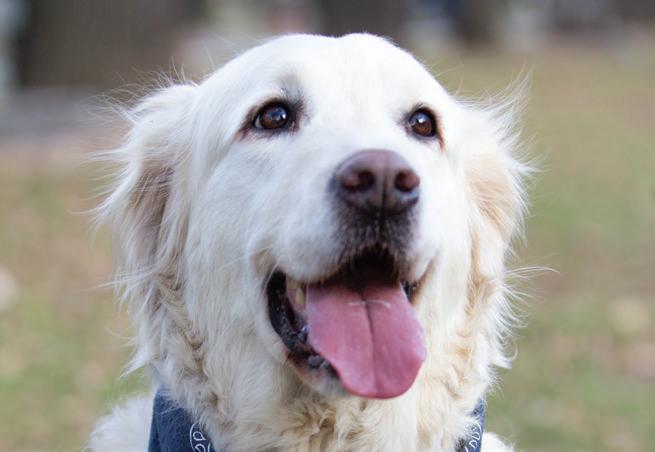

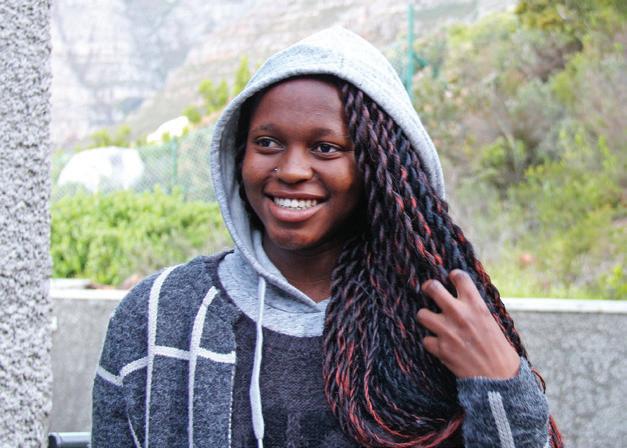
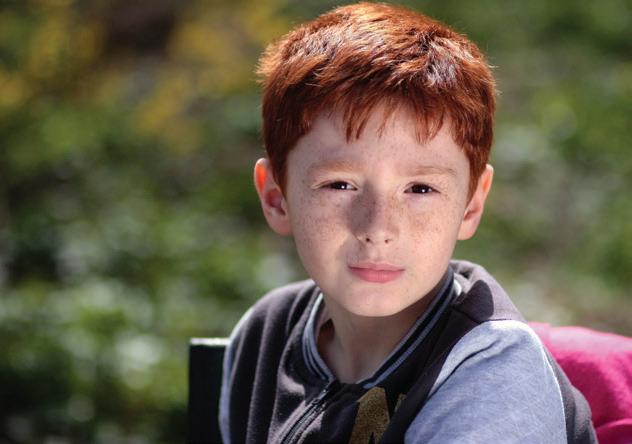
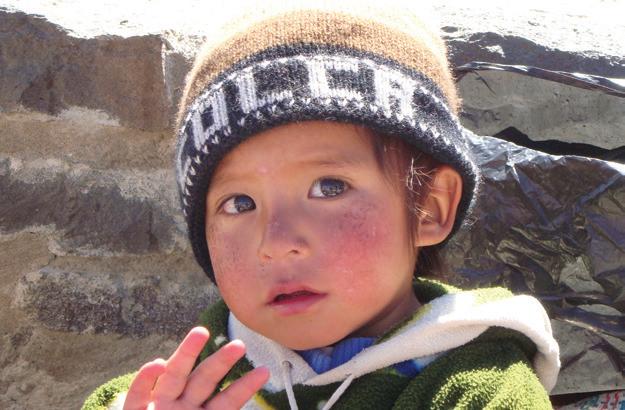
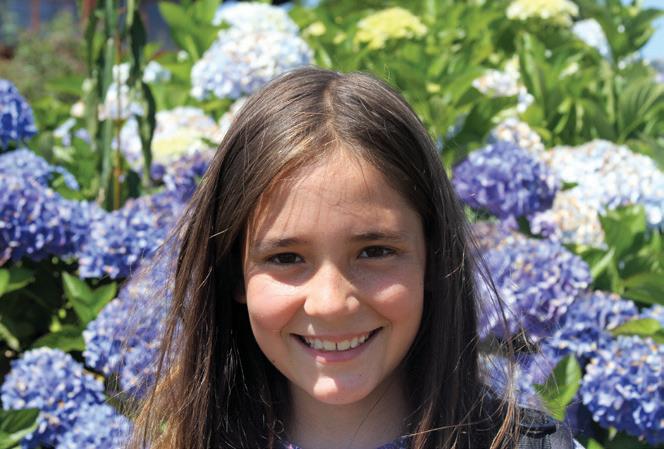
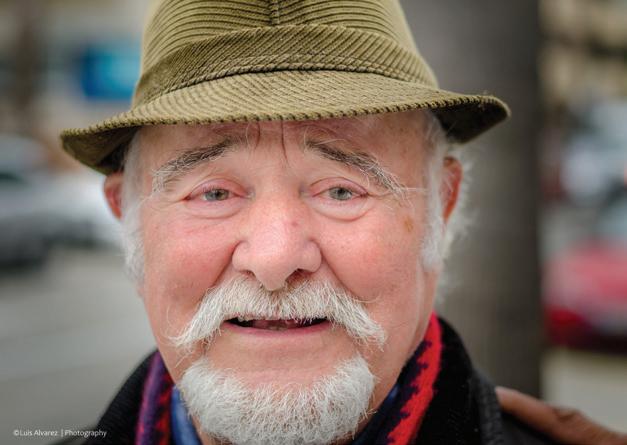
■ Allows you to be far more generous than you ever thought possible ■ Preserves your savings and cash flow, and costs you nothing now ■ Is easy to arrange—as simple as adding a paragraph to your will ■

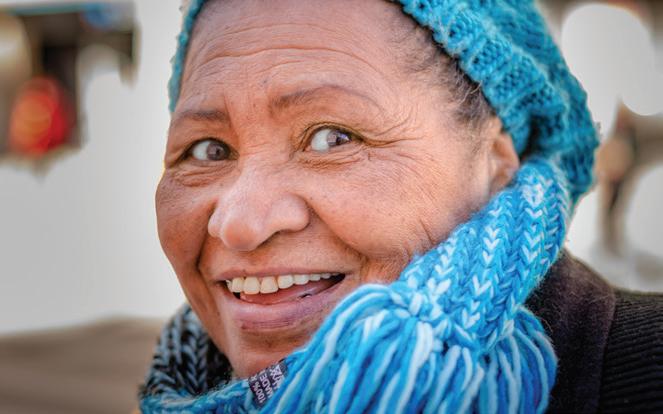
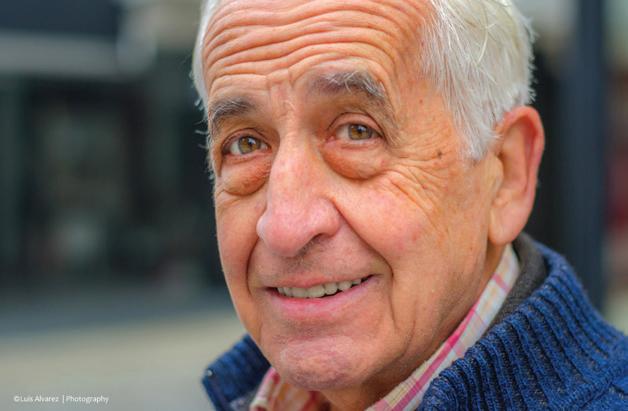
as an inspiration to other like-minded environmentalists
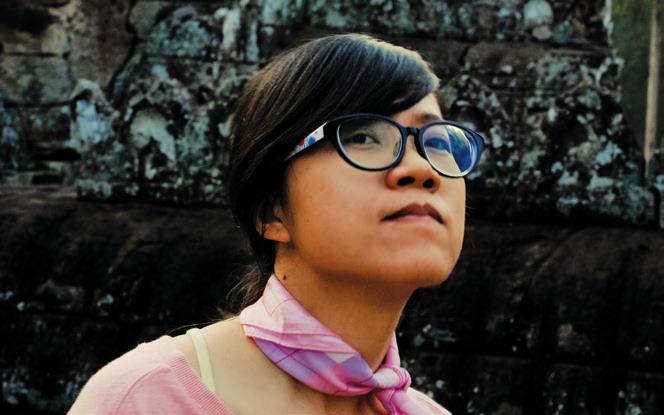

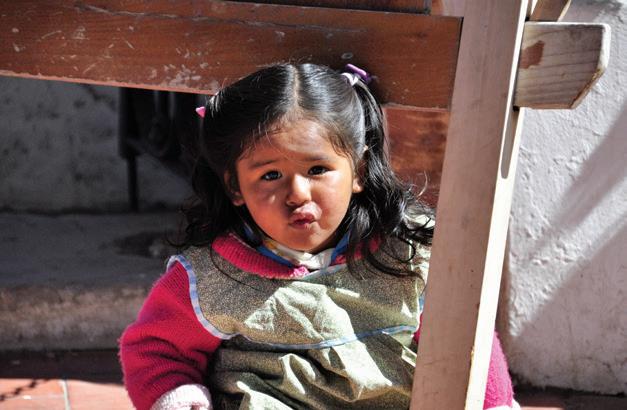
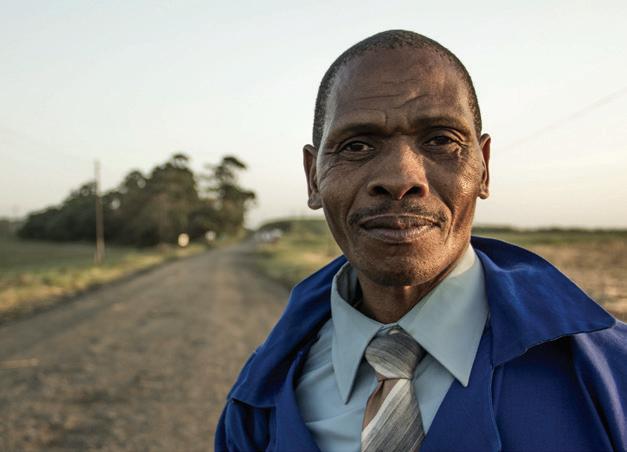
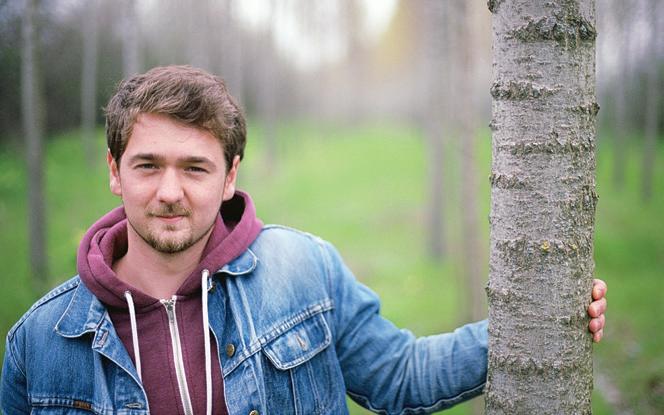
you
Serves
benefits from a gift anyone can make. To learn more about securing your legacy with Woodwell Climate visit woodwellclimate.org/gpms or contact Beth Bagley, Director of Legacy Giving, at bbagley@woodwellclimate.org or 508-444-1517.
149 Woods Hole Road Falmouth, MA, 02540-1644 woodwellclimate.org @woodwellclimate #climatescienceforchange

CLIMATE SCIENCE
FOR CHANGE.






















 Katie Constantine Sarah Ruiz Communications Intern Science Writer
Katie Constantine Sarah Ruiz Communications Intern Science Writer






 Ruiz Science Writer
Ruiz Science Writer









 Sarah Ruiz Science Writer
Sarah Ruiz Science Writer



























 — CHIEF OF EXTERNAL AFFAIRS DAVID MCGLINCHEY
— CHIEF OF EXTERNAL AFFAIRS DAVID MCGLINCHEY







 The Woodwell Building on Woodwell Climate’s campus. / photo by Julianne Waite
The Woodwell Building on Woodwell Climate’s campus. / photo by Julianne Waite











































